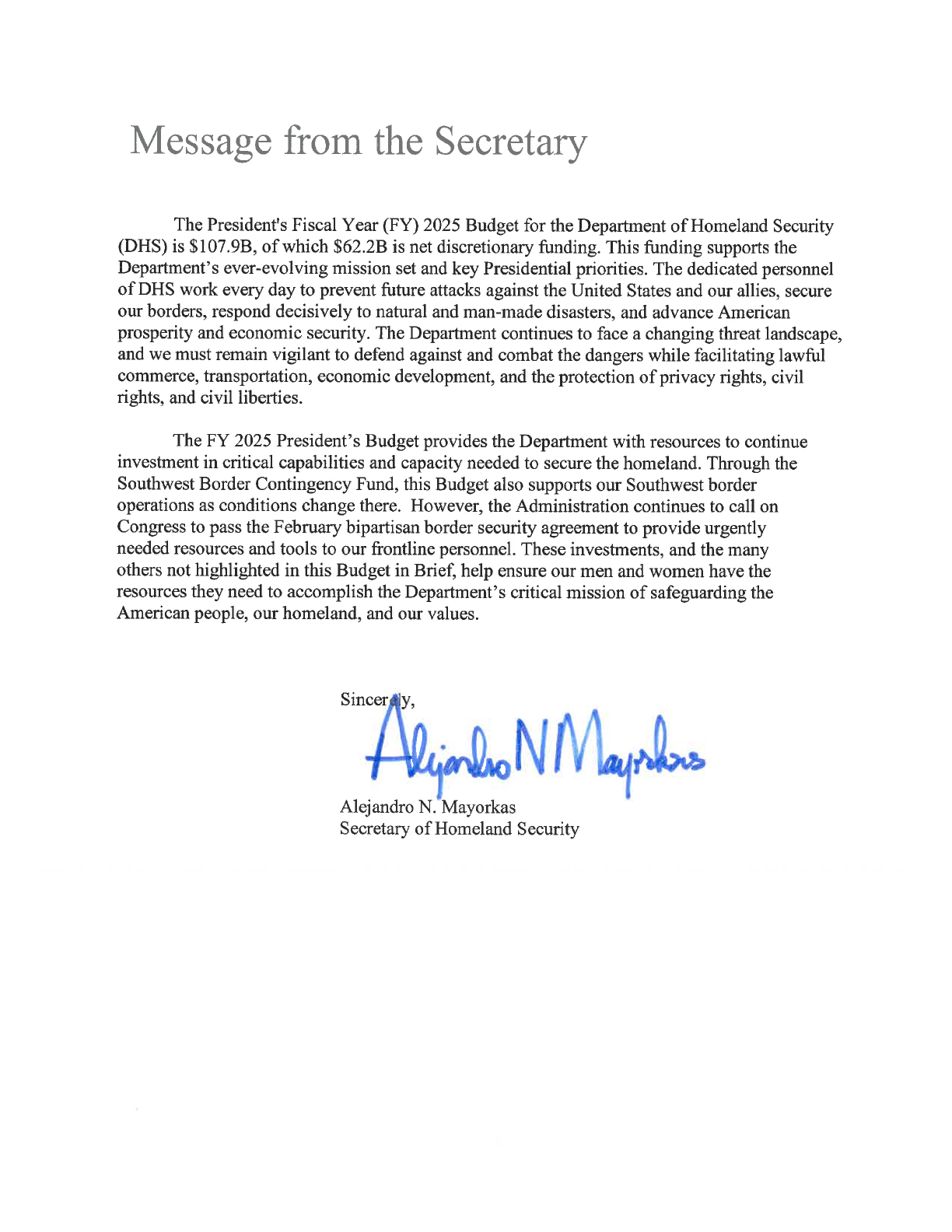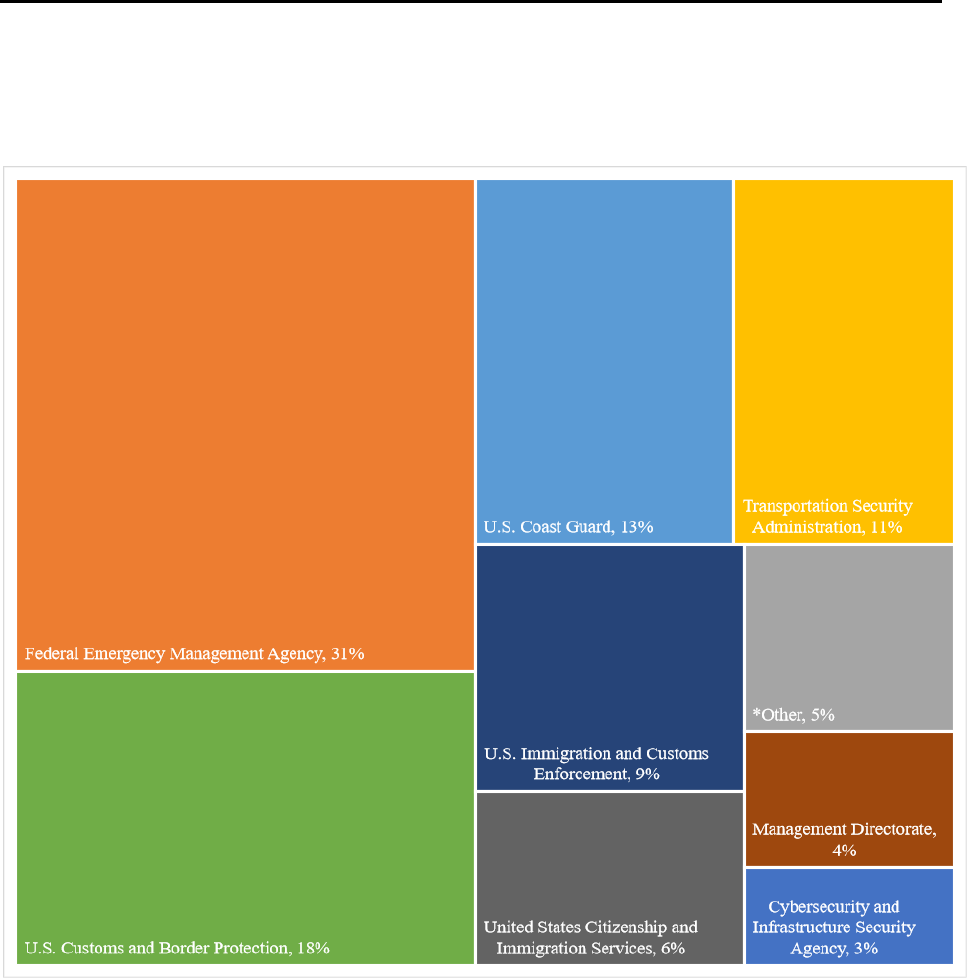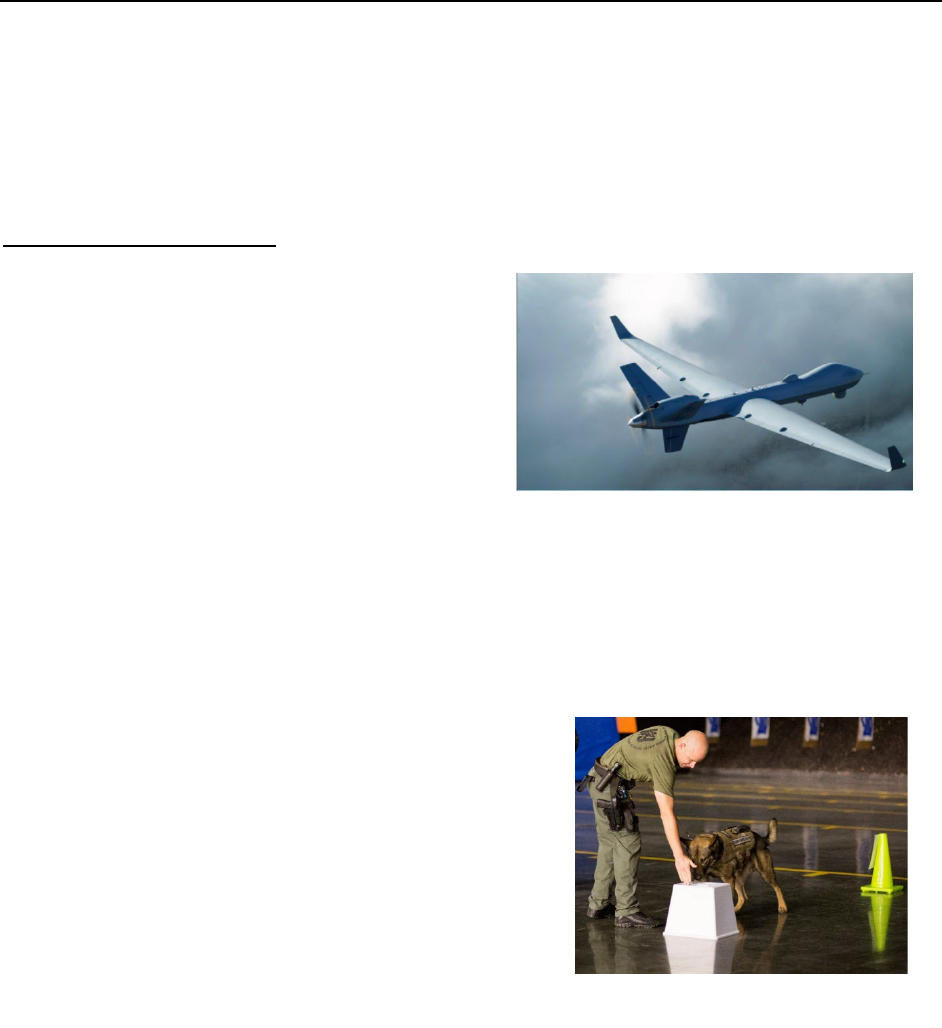
FY 2025
Budget in Brief

Table of Contents
Overview ..................................................................................................................................... 1
Funding Priorities ................................................................................................................. 3
Summary Information by DHS Organization ...................................................................... 8
Office of the Secretary and Executive Management .......................................................... 10
Management Directorate .................................................................................................... 14
Analysis and Operations ..................................................................................................... 19
Office of Inspector General ................................................................................................ 23
U.S. Customs and Border Protection .................................................................................. 25
U.S. Immigration and Customs Enforcement ..................................................................... 33
Transportation Security Administration ............................................................................. 39
U.S. Coast Guard ................................................................................................................ 46
United States Secret Service ............................................................................................... 52
Cybersecurity & Infrastructure Security Agency ............................................................... 58
Federal Emergency Management Agency .......................................................................... 65
U.S. Citizenship and Immigration Services........................................................................ 73
Federal Law Enforcement Training Centers ...................................................................... 78
Science and Technology Directorate .................................................................................. 82
Countering Weapons of Mass Destruction Office .............................................................. 88
DHS Resource Tables .............................................................................................................. 94

Overview
1
Fiscal Year 2025
Overview
Dollars in Thousands
FY 2023
Enacted
FY 2024
Annualized
CR
FY 2025
President's
Budget
FY 2024 to
FY 2025
Total
Changes
FY 2025 +/-
FY 2024 %
Total Budget Authority
$101,798,063
$103,590,766
$107,738,002
$4,147,236
4.0%
Less: Mandatory Fee, and
Trust Funds
$15,247,149
$16,832,185
$16,606,377
($225,808)
(1.3%)
Gross Discretionary
Budget Authority
$86,550,914
$86,758,581
$91,131,625
$4,373,044
5.0%
Less: Discretionary
Offsetting Fees
$5,475,756
$5,651,185
$7,638,724
$1,987,539
35.1%
Less: FEMA Disaster
Relief - Major Disasters
$19,945,000
$19,945,000
$22,708,000
$2,763,000
13.9%
Net Discretionary Budget
Authority
$61,130,158
$61,162,396
$60,784,901
($377,495)
(0.6%)
CHIMP Funding
($18,000)
($18,000)
($4,000)
$14,000
77.8%
Rescissions to Prior Years
Balances
($393,887)
($295,730)
($204,000)
$91,730
31.0%
Adjusted Net
Discretionary Budget
Authority
$60,718,271
$60,848,666
$60,576,901
($285,765)
(0.5%)
Emergency Funding
$17,938,100
$4,700,000
Fiscal Year 2025 President’s Budget
U.S. Department of Homeland Security
The Fiscal Year (FY) 2025 DHS President’s Budget (PB) invests in border security, immigration
law enforcement, refugee processing, IT modernization, cybersecurity, resilience for manmade
and natural disasters, as well as the DHS workforce. The FY 2025 PB provides $62.2B in
discretionary funding DHS, when controlling for a Transportation Security Administration
(TSA) fee proposal, of which $2.7B is designated emergency. The FY 2025 PB proposes $4.7B
for a Southwest Border Contingency Fund (SWBCF) to provide resources to DHS when
migration along the Southwest border conditions warrant additional capacity. An additional
$22.7B for the Disaster Relief Fund (DRF) is provided for response and recovery to major
disasters and building resilience to natural hazards.
DHS reiterates the Administration October 2023 Request for funding to secure the border, build
capacity to enforce immigration law, and counter fentanyl totaling $11.8B, of which $8.7B was
for DHS. This amount includes $405.0M to hire 1,300 additional Border Patrol Agents to secure
the border, $239.0M to hire 1,000 additional CBP Officers to stop fentanyl and other contraband

Overview
2
from entering the U.S., $755.0M to hire an additional 1,600 Asylum Officers and support staff to
facilitate timely immigration dispositions, $100.0M for Homeland Security Investigations to
investigate and disrupt transnational criminal organizations and drug traffickers, and $849.0M
for cutting-edge detection technology at ports of entry. The FY 2025 Budget also reiterates the
Administration’s October Domestic Supplemental request, which includes $9.0B for the DRF
and $200.0M for the Nonprofit Security Grant Program.
Further, the Administration continues to call on Congress to pass the February bipartisan border
security agreement to provide urgently needed resources and tools to our frontline personnel to
bolster the Department’s efforts to secure and manage the border. The funding requests made in
the agreement are critical to fully meeting the operational needs facing the department.

Overview
3
Funding Priorities
Securing the Border and Enforcing Immigration Law
U.S. Customs and Border Protection (CBP) and U.S. Immigration and Customs Enforcement
(ICE) work in unison to secure America’s borders and enforce our immigration laws. DHS does
so while also working to provide safe, orderly pathways for lawful migration, to include through
U.S Citizenship and Immigration Services (USCIS). The FY 2025 Budget includes $25.9B for
CBP and ICE to continue these vital functions.
• The Budget provides $2.5B for ICE Homeland Security Investigations (HSI) for additional
personnel, and technology enhancements for investigative capabilities, including an
additional $21.0M for child exploitation investigations, a vital national asset in the global
fight against transnational criminal threats.
• The Budget includes $2.0B funds to sustain 34,000 ICE immigration detention beds. The
SWBCF resources several thousand additional detention beds if conditions require.
• The Budget funds $649.0M for ICE’s Transportation and Removal program, an increase of
$225.0M, which includes air charter flights, commercial flights, and ground transportation
contracts.
• The Budget supports $360.0M for the Alternatives to Detention (ATD) program, which
monitors compliance of noncitizen participants released into the interior of the United States.
• The Budget provides $210.0M and 1,221 FTE to increase the number of CBP personnel
along U.S. borders. These investments support 350 new border patrol agents, 310 additional
processing coordinators and 150 new CBP Officers to bolster situational awareness and
operational responsiveness.
• The Budget includes $127.0M for investments in border security technology and assets
between ports of entry, and $86.0M for CBP air and marine operational support central to
efforts to secure the border.
Southwest Border Enforcement Capacity Flexibility
The FY 2025 Budget proposes an innovative $4.7B SWBCF to allow the Department to respond
to the ever-changing conditions on the southwest border. The fund would match appropriated
amounts to observed conditions at multiple points during the year rather than providing funds at
the beginning of the year observing if conditions evolve to meet the funding level. The fund will
receive appropriations on a quarterly basis only if pre-defined conditions are met. Resources in
the SWBCF may be transferred to CBP, ICE, and the Federal Emergency Management Agency
(FEMA) for critical operations like transportation, medical care, soft-sided facilities, and Shelter
and Service Program grants.
Supporting Refugee Processing and a Fair, Orderly, and Humane Immigration System
The Budget includes $145.0M and 641 FTE to fully support the USCIS International and
Refugee Affairs Division, a partner in the U.S. Refugee Admissions Program.
Protecting the Homeland from the Threat of Weapons of Mass Terrorism
The President’s Budget provides $418.0M to support the mission of the Countering the Weapons
of Mass Destruction (CWMD) Office, which ensures the security of the Homeland from all types
of terrorist threats.

Overview
4
• The Budget includes $181.0M in support of State, local, tribal, and territorial (SLTT)
governments efforts to build personnel and technical capabilities regarding Chemical,
Biological, Radiological, and Nuclear (CBRN) threats. This funding supports established
programs such as BioWatch, Mobile Detection Deployment Program, Chemical Support, and
Security the Cities.
• The Budget provides $138.0M to develop, acquire, test, evaluate, and deploy CBRN
detection technology and equipment to governmental operators across the United States, at
the Federal and SLTT levels.
Investing in Cybersecurity and Infrastructure Security Protection
The Cybersecurity and Infrastructure Security Agency (CISA) works to prevent malicious cyber
activity to Federal networks and critical infrastructure and collaborates with SLTT partners
through engagement, planning, and capacity building services, to manage cybersecurity risk for
national security, public health and safety, and economic security.
• The Budget includes $470.0M for the Continuous Diagnostics and Mitigation program to
enhance the security posture of Federal Civilian Executive Branch (FCEB) networks by
providing agencies with the capabilities to identify and prioritize cybersecurity risks and
vulnerabilities.
• The Budget provides $394.0M for the Joint Collaborative Environment (JCE) allowing the
continued build of the Cyber Analytics and Data System (CADS), that provides a robust and
scalable analytic environment capable integrating mission visibility data set and providing
cyber operators with visualization tools and advanced analytic capabilities.
• The Budget includes $116.0M to help ensure CISA has the required funding for staffing,
processes, and technology to successfully implement the Cyber Incident Reporting for
Critical Infrastructure Act (CIRCIA).
Responsible Deployment of Artificial Intelligence (AI)
The FY 2025 Budget enables DHS to lay the foundation to responsibly leverage AI and machine
learning to support our missions and developing mitigation tools and strategies to combat the
risks AI poses to homeland security.
• The Budget includes $5.0M to open an AI Office in the DHS Office of the Chief Information
Officer responsible for advancing and accelerating the responsible use of AI by establishing
standards, policies, and oversight to support the growing adoption of AI across DHS.
• The Budget provides additional AI funds for existing ICE, CBP, and FEMA programs for
investment and expansion in line with Executive Order 14110, Safe, Secure, and Trustworthy
Development and Use of Artificial Intelligence.
Investing in and Building a Resilient Nation
In support of the Administration’s efforts to build a resilient Nation, the FY 2025 Budget invests
in grant and disaster assistance programs.
• The Budget includes $22.7B for the Disaster Relief Fund (DRF) - Major Disasters, which
enables FEMA to fund authorized disaster support activities. The DRF Base requirements
total $811.0M and will be funded from prior years’ resources.
• To promote and sustain a prepared Nation, the Budget provides approximately $3.2B in
FEMA grants supporting SLTT partnerships to improve disaster resilience and implement

Overview
5
preparedness strategies and includes an increase for the Nonprofit Security Grant Program
(NSGP).
• The Budget includes a $56.0M and 34 FTE increase to support a variety of FEMA climate
resilience initiatives, including the Flood Hazard Mapping and Risk Analysis Program,
FEMA’s Building Codes Strategy, Climate Adaptation, and Environmental Planning and
Historical Preservation process improvements.
Coast Guard Presence in the Indo-Pacific Region
The U.S. Coast Guard (USCG) is a vital part of ensuring America’s security and advancing the
Administration’s national security strategy. Increasing USCG’s presence in the Indo-Pacific
region is critical to that strategy, the investments detailed below will enable a stable, free, and
open region, and solidify the United States as a trusted partner in the region.
• The FY 2025 Budget includes $200.0M, which expands the program of record and funds
construction of two Fast Response Cutters in support of the Indo-Pacific Strategy.
• The Budget also provides $63.0M to support training, partnerships, and engagement in the
Indo-Pacific region. This investment will strengthen coordination with partner nations and
bolster regional security.
Countering Fentanyl
In addition to the investments proposed in the October supplemental request, the Department’s
FY 2025 Budget includes investments in the fight against fentanyl. Through investments in Non-
Intrusive Inspection (NII) and sprints such as Operations Artemis, Rolling Wave, and Argus,
CBP and ICE Homeland Security Investigations (HSI) have increased the interdiction of
fentanyl, fentanyl precursors, and collateral contraband such as pill presses. The Budget also
includes a legislative package to cement the Administration’s Unity Agenda Strategy to combat
the fentanyl epidemic. More concretely, new authorities are required to close key loopholes that
traffickers exploit and expand penalties for those who engage in trafficking deadly fentanyl into
our communities.
Special Event and 2024 Presidential Campaign Security
The FY 2025 Budget includes $2.9B in net discretionary funding for U.S. Secret Service (USSS)
to continuously evaluate threats and reallocate resources based on the changing threat
environment.
• The Secret Service by law must provide protection and security for “major presidential and
vice-presidential candidates, and their spouses.” Presidential campaigns, significantly
increase the protective workload and the budget includes $70.0M to adequately resource
protective details for the 2024 Presidential Campaign and supports the enhanced protection,
security, travel, and overtime and training for Secret Service personnel and other Federal
partner agencies.
• The Budget includes $16.0M to support the planning and prepositioning of USSS assets for
the protection of the 2026 FIFA World Cup and supports the procurement of necessary
assets, establishment of cross-agency communications centers, and logistics associated with
the World Cup.

Overview
6
• The Budget also includes $8.0M to procure Body-Worn Cameras in support of Executive
Order 14074, Advancing Effective, Accountable Policing and Criminal Justice Practices to
Enhance Public Trust and Public Safety.
Transportation Security and Modernizing Pay and Workforce Policies
FY 2025 resources support the Transportation Security Agency (TSA) strategy improve security
and safeguard the transportation system, honor the commitment to the workforce to approve pay
raises and health benefits and address critical capability gaps to ensure the Nation’s
transportation security is the safest in the world.
• The FY 2025 Budget includes $1.5B to ensure TSA employees are paid at a level that is no
less than their counterparts on the General Schedule pay scale. TSA attrition has dropped by
11 percent since pay parity was implemented in July 2023.
• To account for anticipated increases to aviation passenger volume during FY 2025, the
Budget provides $356.0M and 3,473 FTE for additional Transportation Security Officers to
staff airport checkpoint and checked baggage screening facilities needed to maintain
passenger wait time standards of 30 minutes at standard lanes and 10 minutes for Pre-Check.
• The Budget provides $90.0M for the Checkpoint Property Screening System (CPSS)
program to address capability gaps to detect new and evolving threats reliably and efficiently
to civil aviation in current property screening technology.
• The Budget includes $136.0M to safeguard American critical infrastructure against cyber
threats in the surface and aviation sectors.

Overview
7
FY 2025 Percent of Total Budget Authority by Organization
$107.9 B
*Other: Office of the Secretary and Executive Management, Management Directorate, Analysis and Operations, Office of the
Inspector General, U.S. Secret Service, Federal Law Enforcement Training Centers, Science and Technology Directorate,
Countering Weapons of Mass Destruction Office

8
Summary Information by DHS Organization
9

10
Office of the Secretary and Executive Management
Description
Office of the Secretary and Executive Management
(OSEM) provides leadership, direction, and
management to the DHS.
OSEM includes the Office of the Secretary; Office of
Partnership and Engagement; Office of Strategy,
Policy, and Plans; Office of Public Affairs; Office of
Legislative Affairs; Office of the General Counsel;
Office for Civil Rights and Civil Liberties; Privacy
Office; Office of the Citizenship and Immigration
Services Ombudsman; Office of the Immigration
Detention Ombudsman; and the Office of Health
Security.
Responsibilities
OSEM provides central leadership, management, direction, and oversight of the Department’s
Components. OSEM directly supports the Secretary, Deputy Secretary and Chief of Staff.
Service to the Public
The Secretary ensures a coordinated effort to build a safe, secure, and resilient homeland, by
directing the Department's efforts to prevent terrorism and enhance security, secure, and manage
our borders, enforce, and administer the Nation's immigration laws, safeguard and secure
cyberspace, ensure resilience to disasters, and support national and economic security.
FY 2023 Accomplishments
• As of September 2023, the Family Reunification Task Force (FRTF), reunified 767 children
with their families. In coordination with the Department of Health and Human Services
(HHS) Substance Abuse and Mental Health Services
Administration (SAMHSA), directly notified 994 Ms.
L. class members (parents or legal guardians only) of
the availability of parole, behavioral case management
and behavioral health services.
• The Office of Partnership and Engagement (OPE)
established the Office of Non-Governmental
Organizations (NGO) Engagement with the goal to
enhance and effectively leverage NGO relationships on
behalf of the Department across all mission sets.
• The Office of the Immigration Detention Ombudsman
(OIDO) rapidly mobilized teams of case managers,
investigators, medical experts, and senior leadership to
the Southwest border to observe U.S Immigration and
At a Glance
Senior Leadership: Alejandro N.
Mayorkas, Secretary
Established: 2003
Major Divisions: Management and
Oversight; Office of Strategy, Policy, and
Plans; Operations and Engagement
Budget Request: $358,466,000
Net Discretionary: $358,466,000
Employees (FTE): 957
Secretary Mayorkas speaks with DHS plank
holder and Deputy Chief Freedom of
Information Act (FOIA) Officer Catrina
Pavlik-Keenan during the DHS 20
th
Anniversary Celebration on the St.
Elizabeths campus.

11
Customs Enforcement (ICE) and U.S. Customs and Border Protection (CBP) operations
when Title 42 was lifted in May 2023.
• The Office of the Citizenship and Immigration Services Ombudsman (CIS Ombudsman)
received 23,591 new requests for case assistance, which represents a five percent increase
compared to the average received in fiscal years 2020 and 2022. The office resolved 24,168
requests for case assistance in FY 2023 (including requests pending from the prior fiscal
year).
• In FY 2023, Office for Civil Rights and Civil Liberties (CRCL) Headquarters EEO Office
achieved 98 percent compliance in meeting regulatory time limits for processing informal
pre-complaints and for investigating formal complaints; a five percent improvement for
informal pre-complaints and 63 percent improvement for formal complaints over the FY
2021 timeliness rates.
• The Office of the General Counsel (OGC) hosted a DHS
Procurement Fraud Symposium and the annual DHS
Acquisition and Procurement Law Symposium. The DHS
Procurement Fraud Symposium had approximately 600
virtual attendees from HQ (OGC, OCPO, OIG, FPS), all
DHS Components, as well as attendees from Department
of Justice (DOJ), Housing and Urban Development
(HUD), Department of Defense (DOD), National Science
Foundation (NSF), and Nuclear Regulatory Commission
(NRC) and covered topics on cyber fraud, the Program
Fraud Civil Remedies Act, civil remedies, fraud indicators
and suspension and debarment.
• The Office of Health Security (OHS), in collaboration with
CBP’s Migrant Vaccination Program, provided 807,288
voluntary vaccinations (627,069 COVID-19 and 180,219
annual influenza).
• The Office of Public Affairs (OPA) – in keeping with the
Secretary’s priorities of celebrating the workforce – OPA
distributed over 45 editions of the employee newsletter Last
Week at DHS for FY 2023. DHS.gov had over 29,983,871
people visit in FY 2023 (an increase from 2022’s visit of
28,172,015.
• In Fiscal Year 2023, the Targeted Violence and Terrorism
Prevention (TVTP) Grant Program made 34 new awards
totaling $20.0M, including 14 awards to underserved
communities and awards in three states that had not previously
received awards. In FY 2023, previous TVTP grantees reached
over three million people online with resources and tools, held
444 trainings with over 17,000 trained, and opened nearly 700
threat assessments or similar cases.
OHS- Austere EMS
Training in Denali, Alaska
OHS- For the group photo
with DHS CMO in Miami,
FL at an ICE Facility

12
• The Office of the Executive Secretary (ESEC) in coordination with the Office of the Chief
Information Office developed a new department-wide tracking system for any document
moving to the Secretary or Deputy Secretary. DHS System of Tracking, Operations, and
Records Management (DHS STORM) that rolled out in September 2023 as the
correspondence system of record for DHS.
• The Office of Legislative Affairs (OLA) has managed, oversaw, and provided support to
approximately 77 DHS witnesses testifying at 56 hearings before multiple committees and
subcommittees in FY 2023. They have led more than 2,450 Congressional briefing Hill
engagements. OLA served as the central point for processing approximately 4,500 incoming
pieces of Congressional correspondence for DHS Components and prepared the Secretary
and Deputy Secretary for a total of eight hearings before Congress this past year.
• The Privacy Office (PRIV) co-hosted, with the Science and Technology Directorate (S&T)
Silicon Valley Innovation Program (SVIP), an Ideation Workshop on privacy enhancing
technologies during March 2023.
The Science and Technology Directorate
Silicon Valley Innovation Program held a
hybrid event from Birmingham, Alabama to
highlight a funding opportunity to develop
privacy preserving digital credentials to support
DHS operational use at U.S. Customs and
Border Protection and U.S. Citizenship and
Immigration Services.

13
BUDGET REQUEST
Dollars in Thousands
FY 2023
Enacted
FY 2024
Annualized CR
FY 2025
President’s
Budget
FY 2024 to FY
2025 Total
Changes
FTE
Amount
FTE
Amount
FTE
Amount
FTE
Amount
Operations and Support
948
$336,746
948
$336,746
957
$323,466
9
($13,280)
Procurement,
Construction, and
Improvements
-
$8,048
-
$8,048
-
-
-
($8,048)
Federal Assistance -
$40,000
-
$40,000
-
$35,000
-
($5,000)
Net Discretionary
948
$384,794
948
$384,794
957
$358,466
9
($26,328)
Gross Discretionary
948
$384,794
948
$384,794
957
$358,466
9
($26,328)
Total Budget Authority
948
$384,794
948
$384,794
957
$358,466
9
($26,328)
Less: Rescissions to Prior
Year Balances
-
($23,858)
-
-
-
-
-
-
Total
948
$360,936
948
$384,794
957
$358,466
9
($26,328)
FY 2025 Budget Highlights
DHS Medical Information Exchange……………………….……………………$2.2M, 0 FTE
The Medical Information eXchange (MIX) will be the next-generation information technology
backbone for a DHS-wide Electronic Health Record (EHR) and will support interoperability
across Components’ individual EHR systems and fill gaps in other medical information systems
in DHS. The MIX is being developed via a portfolio of programs, which began with deployment
of the Medical and Public Health Sharing Exchange (MPHISE) platform as Program 1 (which is
currently in sustainment). As part of the EHR requirement and other mission needs, the MIX
portfolio will also deliver capabilities to enable information sharing and analysis across the
extended medical and public health community. This system will assist DHS in its significant
responsibilities related to outbreak response, disease surveillance, and national health security
and provide data-driven decision support.
Supply Chain Resilience Center………………………………………………….$2.0M, 3 FTE
In a March 2023 report to the Secretary, the Homeland Security Advisory Council (HSAC)
recommended that DHS establish a Supply Chain Resiliency Center to aggregate and
disseminate information about critical supply chain vulnerabilities and disruptions. The Office
was established within the Office of Policy in November 2023. The $2.0M funding request
supports six Federal analyst positions, technical advisory services, software licenses, and
database subscriptions.

14
Management Directorate
Description
Management Directorate (MGMT) provides
leadership, direction, and management to DHS.
MGMT includes the Immediate Office of the Under
Secretary for Management, the Office of the Chief
Human Capital Officer, Office of the Chief
Procurement Officer, Office of Program
Accountability and Risk Management, Office of the
Chief Readiness Support Officer, Office of the Chief
Security Officer, Office of the Chief Financial
Officer, Office of the Chief Information Officer,
Office of Biometric Identity Management, and the
Federal Protective Service.
Responsibilities
MGMT is responsible for Department-wide mission
support services and oversight for all Departmental
Management Operations (DMO) functions, including
information technology, programming, budget and financial management, procurement and
acquisition, human capital, security, logistics and
facilities, law enforcement and security services for
Federal buildings, and delivery of Biometric identity
services.
Service to the Public
MGMT provides the overarching management
structure for the Department to enable missions,
while eliminating redundancies and reducing support
costs to run the Department effectively and
efficiently in a unified manner.
Through the Federal Protective Service (FPS), the
Department provides for the safety and security of
over 1.4 million employees and visitors at Federal
facilities across the Nation. FPS is responsible for
law enforcement at the facilities and, as necessary,
provides additional capabilities such as
countermeasures, physical security support, and cyber-physical security support to enhance the
security posture at Federal facilities. FPS also continuously evaluates emerging threats and
adapts protection activities to mitigate risk, while also working in collaboration with Federal,
State, and local law enforcement partners and with the DHS Office of Intelligence and Analysis
in support of the Department’s responsibilities for providing protection at Federal facilities.
At a Glance
Senior Leadership: Alejandro N.
Mayorkas, Secretary
Randolph D. “Tex” Alles, Senior Official
Performing the duties of the Under
Secretary for Management
Established: 2003
Major Divisions: Office of the Chief
Human Capital Officer, Office of the Chief
Readiness Support Officer, Office of
Biometric Identity Management, Office of
Program Accountability and Risk
Management
Budget Request: $4,008,085,000
Net Discretionary: $1,979,282,000
Offsetting Collections: $2,028,803,000
Employees (FTE): 3,895
FPS receiving public order police training at the
Federal Law Enforcement Training Center (FLETC)

15
FY 2023 Accomplishments
• The Office of the Chief Procurement Officer (OCPO) conducted over 62,000 contract
actions resulting in over $28.6B in total obligations while increasing competition in contract
actions, exceeding all DHS small, disadvantage, veteran, and women-owned business goals,
and reduction in protested awards.
• The Office of the Chief Financial Officer (OCFO) earned the eleventh consecutive clean
audit opinion on the Department’s financial statements, demonstrating that the Department’s
financial statements are reliable and accurate.
• The Office of the Chief Security Officer (OCSO) completed and surpassed the Secretary’s
priority for personnel security reform by maintaining at least 95 percent DHS national
security eligible population enrollment into the Office of the Director of National
Intelligence’s Continuous Evaluation System before the prescribed completion date of
March 31, 2023, ultimately allowing for the replacement of periodic reinvestigations and
reallocating resources to support initial vetting.
• The Office of the Chief Security Officer (OCSO) established a DHS Insider Threat Hub to
serve as the central coordination and deconfliction capability for all insider threat matters
within DHS. The DHS Insider Threat Program (ITP) staff developed standard operating
procedures for the DHS Enterprise HUB and the HQ HUB Operations and established
memorandums of understanding with each participant.
• Federal Protective Service (FPS) performed law
enforcement and protective services, such as criminal and
threat investigations, provided nearly 1,800 facility security
assessments and over 60 cybersecurity assessments,
conducted explosive detection canine sweeps, handled calls
for service and incidents responses—including during
demonstrations across the country, and diligently protected
the First Amendment rights of thousands of peaceful
demonstrators on or near Federal property. Additionally, FPS
provided Counter Unmanned Aerial System capabilities at
DHS Headquarters and at high profile events, commenced
agile development of the new Revenue Management System,
initiated training in support of Executive Order (EO) 14074,
and began acquisition planning activities involving body-worn
cameras for its law enforcement personnel.
• The Office of Program Accountability and Risk Management (PARM) oversees the
execution of a diverse portfolio of DHS’s largest and most complex acquisition programs
valued at over $220.0B life cycle cost.
FPS Law Enforcement Officer and
K-9 partner providing a security
sweep at a building.

16
• The Office of the Chief Information Officer (OCIO) established a permanent Customer
Experience (CX) office to help deliver services that are simple to use, accessible, equitable,
protective, transparent, and responsive for all DHS customers.
• In September 2023, the Office of the Chief Information Officer (OCIO) named the first DHS
Chief Artificial Intelligence (AI) Officer and released new policies and measures promoting
responsible use of AI.
• The Office of Biometric Identity Management (OBIM) processed almost 115 million
biometric transactions in FY 2023 as monthly transaction volumes continue to increase
towards pre-pandemic levels. At the end of FY 2023, the Automated Biometric
Identification System (IDENT) contained approximately
300 million unique identities.
• In FY 2023, OBIM's Biometric Support Center (BSC),
which supplements IDENT's automated operations with
manual support by expert human biometric examiners,
provided approximately 575,000 ten print comparisons,
of which more than 163,000 were urgent comparisons.
The BSC's human examiners also identified more than a
thousand latent fingerprints, or fingerprints of unknown
origin.
• Within the Office of the Chief Human Capital Officer
(CHCO), Cybersecurity and Intelligence Talent
Experience (CTMS) onboarded 176 employees across 29
States and the District of Columbia. CTMS connected with
over 700 prospects at 10 major conferences while continuing our LinkedIn and Google
recruitment/sourcing campaigns; These efforts yielded over 130,000 Application Portal
visits; and over 302 TJOs to-date.
IM BSC Pair Prints

17
BUDGET REQUEST
Dollars in Thousands
FY 2023
Enacted
FY 2024
Annualized CR
FY 2025
President’s
Budget
FY 2024 to FY
2025 Total
Changes
FTE
Amount
FTE
Amount
FTE
Amount
FTE
Amount
Operations and Support
2,356
$1,743,160
2,356
$1,743,160
2,345
$1,695,674
(11)
($47,486)
Procurement,
Construction, and
Improvements
-
$325,245
-
$325,245
-
$283,608
-
($41,637)
Net Discretionary
2,356
$2,068,405
2,356
$2,068,405
2,345
$1,979,282
(11)
($89,123)
Federal Protective Service
1,529
$2,113,479
1,547
$2,204,387
1,550
$2,028,803
3
($175,584)
Gross Discretionary
3,885
$4,181,884
3,903
$4,272,792
3,895
$4,008,085
(8)
($264,707)
Total Budget Authority
3,885
$4,181,884
3,903
$4,272,792
3,895
$4,008,085
(8)
($264,707)
Less: Rescissions to Prior
Year Balances
-
($113,604)
-
($113,000)
-
($154,000)
-
($41,000)
Total
3,885
$4,068,280
3,903
$4,159,792
3,895
$3,854,085
(8)
($305,707)
FY 2025 Budget Highlights
National Capital Region (NCR) Consolidation………….……………………$186.7M, 0 FTE
The Administration continues to support the strategic investment in the NCR for Headquarters
and other facility improvements, as well as operations and maintenance costs at St. Elizabeths.
This includes construction of new facilities, including $116.8M for ICE Headquarters (building
3). There is also $69.9M to continue the remaining consolidation of MGMT and FEMA from
dispersed locations to a consolidated space at 7th and D.
Financial Systems Modernization………………….….………….…….………$67.0M, 0 FTE
Financial Systems Modernization supports the continued modernization of the Components’
integrated financial, procurement, and asset management systems to improve financial
accountability and financial reporting. Modernizing will allow DHS Components to strengthen
integrated internal controls and enhance efficiency and security. The program supports the DHS
clean audit and clean internal control over financial reporting opinions. Further, implementation
of FSM mitigates complex system support, security vulnerability, and financial risks and enables
business processes standardization. In FY 2024, FSM began the modernization effort for FEMA
and Cube (ICE, CISA, DMO and S&T) and is expected to continue in FY 2025.
AI Office Chief of the Chief Information Officer………………………………$9.9M, 2 FTE
Funding supports the Department’s execution of advancing and accelerating the responsible use
of AI by establishing standards, responsible use policies and processes, and oversight to support
the growing adoption of AI across DHS. These efforts allow the implementation of beneficial AI
tools to support mission execution while ensuring necessary safeguards are in place to protect the
Department’s use of AI, its infrastructure, and operations while protecting privacy, and civil
rights and civil liberties. The implementation of AI Governance/Compliance facilitates a
comprehensive, department-wide audit of account transactions with incident management
support. The AI-driven auditing mechanisms enable the Department to efficiently assess and

18
analyze vast amounts of data, identifying potential vulnerabilities and anomalies more
effectively.
Customer Service Experience Office…………………….……..……………….$7.4M, 16 FTE
Funding supports the Customer Service Experience (CX) Office as directed in Executive Order
14058. The CX Office will enhance the overall experience of external customers and
stakeholders as they interact with various components throughout the Department. The CX
Office will reduce the burden across forms and coordinate an enterprise-based approach to a
Voice of Customer Program, building off existing efforts and network platforms that enables
public reporting of customer feedback and customer experience measures.
Technology Transformation Services…………………….…..…………………..$4.0M, 0 FTE
This initiative provides funding to DHS for the use of Government Services Administration
(GSA) Technology Transformation Services (TTS) to improve the public’s experience by
helping build, buy, and share technology that allows better service to the public. TTS applies
modern methodologies and technologies to improve the public’s experience with government.
TTS Solutions modernizes the way citizens interact with their government. This includes using
technology to improve transparency, security, and the efficiency of Federal operations, while
also increasing citizen participation. TTS is acutely focused on the citizen experience with
government digital services and is committed to improving the public's interaction with
government through technology.
Federal Protective Service (FPS)......................................................................$2.0B, 1,550 FTE
FPS protects Federal facilities and those who occupy them, including visitors, by providing
integrated law enforcement and protective security services to approximately 9,000 locations.
FPS leverages access to the intelligence and information resources to protect Federal customers
in both GSA and non-GSA owned, leased, or operated facilities in 11 FPS regions across the
country, including DHS St. Elizabeth’s Campus.

19
Analysis and Operations
Description
The Analysis and Operations appropriation provides
resources to support the Office of Intelligence and
Analysis (I&A) and the Office of Homeland Security
Situational Awareness (OSA), formally known as the
Office of Operations Coordination. This appropriation
includes both National Intelligence Program (NIP) and
non-NIP funds.
Responsibilities
The I&A mission is to equip the Homeland Security
Enterprise (HSE) with the intelligence and information
necessary to keep the Homeland safe, secure, and
resilient. I&A executes this mission by integrating
intelligence into operations across the DHS
Components, our partners in State and local
government, as well as the private sector, to identify,
mitigate, and respond to threats.
The mission of OSA is to provide information sharing, situational awareness, and a common
operating picture to the HSE and the full spectrum of incident management efforts (i.e.,
prevention, protection, response, and recovery). OSA supports the DHS mission by maintaining
24/7 operation of the National Operations Center (NOC), enabling multi-agency fusion of law
enforcement, national intelligence, emergency response, and private sector real time reporting,
and by partnering with other DHS Components and Federal, State, local, tribal, territorial
(FSLTT), foreign, private sector, and international partners. To augment NOC Watch
capabilities, OSA sections also focus on enhancing our partnerships and collaboration via
engagements, establishing two-way information flows, and automating information, and creating
augmented reporting to provide additional operational context and broaden understanding about
non-incident, homeland security priority topics.
While I&A and OSA are distinct in their missions, they collaborate with other DHS Components
as well as FSLTT, foreign, and private sector partners, to enhance intelligence analysis,
information sharing, incident management support, and situational awareness.
Service to the Public
I&A and OSA promote improved analysis and sharing of threat and incident information
providing all levels of FSLTT government, the private sector, and the public with timely
information concerning threats and hazards to the Nation.
I&A analyzes intelligence and information about homeland security threats and serves as the
interface between the Intelligence Community (IC), FSLTT, and private sector partners on
homeland security intelligence and information. Through warnings, actionable intelligence, and
analysis provided by I&A, DHS leadership, DHS Components, Federal policymakers and law
At a Glance
Senior Leadership:
Kenneth Wainstein, Under Secretary for
Intelligence and Analysis
Christopher J. Tomney, Director of the
Office of Homeland Security Situational
Awareness
Established: 2006
Major Divisions: Office of Intelligence
and Analysis; Office of Homeland Security
Situational Awareness
Budget Request: $348,302,000
Employees (FTE): 1,023

20
enforcement, IC partners, and frontline law enforcement, public safety personnel, and security
personnel all have the information they need to identify and mitigate threats to the homeland.
The Under Secretary for I&A holds six Department-wide roles: (1) the DHS Chief Intelligence
Officer, chairing the Homeland Security Intelligence Council and managing the DHS
Intelligence Enterprise (IE); (2) the DHS Information Sharing and Safeguarding Executive,
enhancing information sharing while protecting information from unauthorized disclosure; (3)
the DHS Counterintelligence Executive, leading the DHS Counterintelligence Program; (4) the
DHS Watch-listing Executive, managing the DHS Watch-listing Program; (5) the Executive
Agent for the DHS State, local, and regional Fusion Center Initiative, overseeing support for
State and local fusion centers; and (6) the DHS Counterterrorism Coordinator, developing and
coordinating DHS-wide counterterrorism policy.
OSA manages the NOC, providing critical awareness to partners at all levels of the HSE,
presenting information in context for decision support, and facilitating executive
communications. The NOC provides rapid notification to both DHS leadership and the White
House Situation Room.
Additionally, OSA provides situational awareness for partners across a wide range of homeland
security activities, threats, incidents, and events by gathering information from a variety of
sources. The foundation of this situational awareness is the collection, assessment, integration,
and exchange of information and intelligence - obtained from open sources, private sector
information sharing, law enforcement and operational reporting, and the Intelligence Community
addressing issues relevant to homeland security.
FY 2023 Accomplishments
I&A
• I&A produced hundreds of analytic products for the IC, FSLTT, and private sector partners,
addressing homeland threats such as cyber, terrorism, Nation State-sponsored threats, and
transnational organized crime. Over 60 percent of I&A’s products leveraged DHS- or SLTT-
generated information to provide unique insight into threat analysis. Moreover, nearly 85
percent of I&A analysis was produced at the Secret- or Unclassified-level to ensure broad
consumption by partners nationwide.
• I&A produced over 2,000 raw intelligence reports to inform analysts and customers of
unique homeland intelligence and enable all-source analytic products.
• I&A achieved full privacy compliance for the Intelligence Data Environment for Analytics
(IDEA), the unclassified advanced analytics platform predicated on national intelligence.
Additionally, all compliance and oversight documentation are complete in anticipation of
receiving the funding to perform the technical work required to establish the IDEA
capability.
• The I&A-facilitated Data Access Review Council concluded four agreements authorizing the
sharing of multiple Departmental datasets with IC partners for national security and
intelligence purposes. I&A’s role as a data broker between and among various FSLTT
partners ensures that unique information is made available to a broad community of
collectors, analysts, and decision makers.

21
• I&A’s National Threat Evaluation and Reporting (NTER) Program Office grew FSLTT
partners’ capacity by 125 percent through its instructor certification program with over 400
partners nationwide who teach agencies and community members how to identify, report,
share, and mitigate threats of terrorism and mass violence.
• I&A strengthened its engagement and liaison activities with FSLTT, public and private
sector partners. I&A conducted the 2023 Public-Private Analytic Exchange Program with
over 570 registered attendees from the Federal government, IC, State fusion centers, and the
private sector. This program improved collective understanding of emerging threats and
boosted public-private collaboration.
• I&A engaged with approximately 20,000 partners across the Nation, on threat topics such as
terrorism and transnational organized crime. This caused partners to conduct dozens of
operational activities, including investigations, arrests, and strategic actions like developing
new policies or procedures for information sharing or vetting potential threat actors.
• I&A strengthen the DHS Counterintelligence Program by diversifying staffing, improving
structural coordination, and expanding training and investments in technology. I&A
onboarded two Counterintelligence liaison officers, one from the Central Intelligence Agency
and one from the Federal Bureau of Investigation, which resulted in more effective sharing of
sensitive information and mitigation of counterintelligence threats.
OSA
• The NOC provided situational awareness and leadership notifications to DHS and its
homeland security partners by monitoring and reporting on more than 7,000 items of interest
ranging from suspicious activities to natural disasters while completing 7,402 requests for
situational awareness support from partners.
• OSA, in collaboration with DHS Operational Components, established the DHS Senior
Leader Situational Awareness Forum to promote cohesion and share crosscutting, longer-
range operational situational awareness information. The forum conducted snap meetings for
emergent issues to ensure broader understanding of significant incidents or events.
• The NOC established and led three forums comprised of Directors from partner Operations
Centers: the International Forum (Australia, Canada, New Zealand, and the United
Kingdom), the Interagency Forum (40 Federal Operations Centers), and the DHS Forum
(principal DHS Operations Centers). The forums developed procedures for collaboration,
information sharing and best practice exchanges among the Operations Centers.
• OSA provided strategic-level support to Secretary-level priorities involving multiple
Components such as: supporting the CBP-led Southwest Border Coordination Center to help
manage migrant flows; assisting with establishing the DHS National Security Presidential
Memorandum -36 Operational Executives Group to facilitate weapon of mass destruction
incident coordination; and partnering with multiple DHS agencies to support the creation of
an OSA-managed DHS Incident Support Team, to deliver expanded situational awareness at
the onset of emerging national-level homeland security incidents.

22
BUDGET REQUEST
Dollars in Thousands
FY 2023
Enacted
FY 2024
Annualized CR
FY 2025
President’s
Budget
FY 2024 to FY
2025 Total
Changes
FTE
Amount
FTE
Amount
FTE
Amount
FTE
Amount
Operations and Support
946
$316,640
946
$316,640
1,023
$348,302
77
$31,662
Net Discretionary
946
$316,640
946
$316,640
1,023
$348,302
77
$31,662
Gross Discretionary
946
$316,640
946
$316,640
1,023
$348,302
77
$31,662
Total Budget Authority
946
$316,640
946
$316,640
1,023
$348,302
77
$31,662
Less: Rescissions to Prior
Year Balances
-
($636)
-
-
-
-
-
-
Total
946
$316,004
946
$316,640
1,023
$348,302
77
$31,662
FY 2025 Budget Highlights
Special Events Program………………………………………………………......$0.8M, 4 FTE
The FY 2025 Budget provides additional funding for the DHS Special Events Program, a critical
program that gathers information on more than 57,000 special events, conducts risk assessments,
coordinates Departmental and Federal support thereto, and ensures that relevant information
sharing occurs. The program uses information submitted by SLTT partners to identify and assess
terrorism risk to high profile special events across the Nation and facilitates the rating of special
events with its Special Events Assessment Rating (SEAR) methodology. These resources will
fully fund personnel and necessary travel to conduct DHS approved SEAR missions.
FY 2025 Major Decreases
Contract Support………….………...………………………………………….($6.8M), 0 FTE
The FY 2025 Budget reduces funding to certain assistance and advisory services and travel.
While A&O utilizes these funds for mission critical information technology infrastructure and
security contracts, technical support, intelligence support, and services that support the NOC
situational awareness and decision support missions, adjustments to operations will be made as
appropriate to fulfill mission critical responsibilities.

23
Office of Inspector General
Description
The DHS Office of Inspector General (OIG) was
established by the Homeland Security Act of 2002
(P.L. 107-296) which amends the Inspector General
Act of 1978. The OIG has a dual reporting
responsibility to the Secretary of DHS and to the
Congress. The OIG serves as an independent and
objective audit, inspection, and investigative body to
promote economy, effectiveness, and efficiency in
DHS programs and operations, and to prevent and
detect fraud, waste, and abuse in these programs and
operations.
Responsibilities
The OIG conducts and supervises audits, evaluations, and investigations of the Department’s
programs and operations. The OIG examines, evaluates, and where necessary, critiques these
operations and activities, recommending ways for DHS to carry out its responsibilities in the
most economical, efficient, and effective manner possible. The OIG reviews recommendations
regarding existing and proposed legislation and regulations relating to the Department’s
programs and operations.
The OIG operates a web-based (www.oig.dhs.gov) and call center (800) 323-8603 Hotline, as a
resource for Federal employees and the public to report allegations of program fraud and
financial crimes, employee corruption, civil rights and civil liberties abuses, and miscellaneous
criminal activity and misconduct associated with waste, abuse, and fraud affecting the programs
and operations of the Department. The Hotline provides confidentiality and anonymity for
whistleblowers, consistent with the law.
Service to the Public
The OIG helps ensure effective stewardship of the Department’s budget and resources through
objective and independent oversight. The OIG safeguards the public’s tax dollars by deterring
and detecting fraud, waste, and abuse in the Department’s programs and operations, and
recommending more efficient and effective ways of doing business.
FY 2023 Accomplishments
During FY 2023, DHS OIG continued to improve and enhance our audits, inspections, and
investigations. Specific results of these efforts are detailed in OIG’s Semiannual Reports to
Congress which can be found at https://www.oig.dhs.gov/reports/semiannual. Highlights include:
• Questioned $53.4M in costs and recovered $405.4M in fines, restitutions, recoveries, and
deobligations resulting from audits and investigations.
• Investigated cases that led to 109 arrests, 105 indictments, 115 convictions, and 13 personnel
actions.
At a Glance
Senior Leadership:
Dr. Joseph V. Cuffari, Inspector General
Established: 2003
Major Divisions: Audits; Counsel;
External Affairs; Innovation; Inspections
and Evaluations; Integrity; Investigations;
and Management.
Budget Request: $233,206,000
Employees (FTE): 778

24
• Closed 334 investigations, initiated 351 new investigations, and referred 107 investigations
for prosecution.
• Issued 293 investigative reports and 61 audits, inspections, and evaluations. Provided 240
unique recommendations and closed 261 recommendations from FY 2023 and prior years.
• Received 22,828 complaints through the OIG Hotline and reviewed 408 whistleblower
retaliation allegations, which resulted in the initiation of critical audits, inspections, and
investigations.
• Briefed Congressional members and their staffs more than 80 times and continued to actively
engage with Congress on a range of issues relating to the OIG’s work and that of the
Department.
BUDGET REQUEST
Dollars in Thousands
FY 2023
Enacted
FY 2024
Annualized CR
FY 2025
President’s
Budget
FY 2024 to FY
2025 Total
Changes
FTE
Amount
FTE
Amount
FTE
Amount
FTE
Amount
Operations and Support
778
$214,879
778
$214,879
778
$233,206
-
$18,327
Net Discretionary
778
$214,879
778
$214,879
778
$233,206
-
$18,327
Gross Discretionary
778
$214,879
778
$214,879
778
$233,206
-
$18,327
Total Budget Authority
778
$214,879
778
$214,879
778
$233,206
-
$18,327
Less: Rescissions to Prior
Year Balances
-
-
-
-
-
-
-
-
Total
778
$214,879
778
$214,879
778
$233,206
-
$18,327
FY 2025 Budget Highlights
In the FY 2025 President’s Budget, OIG requests $233.2M and 778 full-time equivalents. The
President’s Budget request provides resources for the OIG to perform its oversight
responsibilities as an independent and objective audit, inspection, and investigative entity
promoting economy, effectiveness, and efficiency in DHS programs and operations.
Zero Trust Network Architecture and Hardware Refresh..................................$5.4M, 0 FTE
The increase over the FY 2023 Enacted budget supports the OIG’s efforts to implement a Zero
Trust network architecture in accordance with Executive Order 14028, Improving the Nation’s
Cybersecurity, and the Office of Management and Budget’s Federal Strategy to Move the U.S.
Government Towards a Zero Trust Architecture. Requested funding will also support the refresh
of enterprise-level information technology hardware that has reached end-of-life.

25
U.S. Customs and Border Protection
Description
U.S. Customs and Border Protection (CBP) is
responsible for securing America’s borders,
coastlines, and ports of entry (POEs). CBP also
protects the United States against terrorist threats and
prevents the entry of inadmissible persons and
contraband while facilitating lawful travel, trade, and
immigration. CBP performs these missions with
vigilance, integrity, and professionalism.
Responsibilities
CBP is maturing a well-informed, agile, and seamless
global network, combining customs, immigration,
border security, and agricultural protection to
strengthen U.S. border security operations while
facilitating the legal movement of people and goods.
This network must constantly enhance and evolve its
capabilities to support CBP’s Mission Areas, as
identified in CBP’s Strategy 2024 - 2028: (1) secure
the border, (2) support national security and
contingency operations, (3) facilitate lawful travel, (4) facilitate lawful trade and protect revenue.
Spanning over 5,000 miles of border with Canada; 1,900 miles of border with Mexico; and
approximately 95,000 miles of shoreline, CBP is responsible for preventing the illegal movement
of people and contraband. Agents from the U.S. Border Patrol (USBP) and from Air and Marine
Operations (AMO) guard the Nation’s land, littoral borders, and associated airspace to prevent
the illegal entry of people and goods into the United States. Multi-disciplined CBP Officers
(CBPO) and Agriculture Specialists from the Office of Field Operations (OFO) perform a full
range of inspection, intelligence analysis,
examination, and law enforcement activities
relating to the arrival and departure of persons,
conveyances, and merchandise at air, land, and
sea POEs. Collecting $94.5B in duties, taxes,
and fees in FY 2023, CBP remains the second
largest collector of revenue in the Federal
Government. Through the Office of Trade,
CBP enforces nearly 500 U.S. trade laws and
regulations on behalf of 49 Federal agencies,
facilitating compliant trade, collecting revenue,
and protecting the U.S. economy and
consumers from harmful imports and unfair
At a Glance
Senior Leadership:
Troy A. Miller, Senior Official Performing
the Duties of the Commissioner
Established: 2003
Major Divisions:
Office of Field Operations; U.S. Border
Patrol; Air and Marine Operations; Office
of Trade; Enterprise Services; &
Operations Support
Budget Request: $19,764,120,000
Net Discretionary: $16,601,815,000
Offsetting Collections: $409,086,000
Mandatory, Fees,
& Trust Fund: $2,753,219,000
Employees (FTE): 65,622
Border Patrol Agents patrol the Rio Grande River.

26
trade practices. The agency is committed to
its dual role of trade facilitation and
protection of revenue.
Service to the Public
CBP ensures that its employees maintain the
highest professional standards in order to
maintain the enormous trust and confidence
the American people place in CBP. CBP
protects the Nation from acts of terrorism and
criminality with constant vigilance at and
between the Nation’s POEs. CBP safeguards
American businesses and workers by
ensuring travelers and goods move safely
and efficiently across U.S. borders;
immigrants and visitors have proper
documentation and authorization; and U.S. customs, immigration, trade laws, regulations, and
related international agreements are enforced.
FY 2023 Accomplishments
• CBP strives to ensure that all migrants, including single adults, families and unaccompanied
children, are appropriately screened, processed, and provided with emergency medical care
when necessary. Along the Southwest Border (SWB), U.S. Border Patrol encountered
2,045,838 migrants, including 621,311 family units and 131,519 unaccompanied children.
OFO encountered 429,831 migrants at POEs, including 200,226 family units and 5,756
unaccompanied children.
• Nationwide, USBP encountered and prevented 15,267 criminals and 598 gang members from
entering the United States.
• CBP seized over 549,238 pounds of all drug types, including 81,085 pounds of cocaine,
27,023 pounds of fentanyl, and 140,408 pounds of methamphetamines. CBP also seized
$53.0M in unreported currency; 3,355 firearms; and 501,368 rounds of ammunition.
• AMO flew 97,530 flight hours and logged 42,597 maritime hours, resulting in the seizure
and disruption of 355,273 pounds of narcotics, $15.3M in illicit currency, the apprehensions
of 89,909 individuals, and the rescue of 187 people.
• AMO resolved 275 detected conventional aircraft incursions along U.S. borders; a 100
percent successful resolution rate.
• USBP and AMO conducted 5,951 life-saving search and rescue efforts, rescuing over 42,527
individuals.
• CBPOs at 328 POEs inspected 394.6 million travelers and arrested 16,062 individuals
wanted for criminal activities and stopped 1,108,330 inadmissible migrants from entering the
United States. Joint efforts by the National Targeting Center, the Immigration Advisory
Program, and the Regional Carrier Liaison Group prevented the boarding of over 15,559 U.S.
bound, high-risk travelers.
To meet border security threats and challenges, CBP AMO
deploys aircraft and maritime vessels throughout the country to
provide rapid air and marine response capabilities.

27
• CBP processed over $5.0T in combined imports/exports.
• CBP processed more than 36.6 million cargo containers through the Nation's POEs and
conducted 20,813 seizures of goods – valued at over $2.9B – that violated intellectual
property rights. Agriculture specialists conducted more than 1,247,000 cargo inspections and
intercepted more than 84,000 agricultural pests at the POEs.
• OFO cleared nearly 190 million express shipments at 28 express facility locations across the
United States and 81 million international mail shipments through eight International Mail
Facilities. In addition, OFO cleared nearly 623 million Type 86 entries and in total, over one
billion de-minimis (goods entered under $800) shipments across all operational
environments.
• OFO has increased utilization of biometric facial comparison technology to 238 airports, an
increase of 33 airports from FY 2022. This includes 14 Preclearance locations, 39 seaport
locations, and 162 pedestrian crossing locations. OFO has implemented biometric facial
comparison technology in the air exit environment at 48 airports and continues to actively
engage with the air travel industry.
• Pursuant to Sections 201 and 301 of the Trade Act of 1974 and Section 232 of the Trade
Expansion Act of 1962, CBP assessed $187.0M in Section 201 duties; $480.0M in Section
232 aluminum duties; $1.6B in Section 232 steel duties; and more than $38.0B in Section
301 aggregate duties on goods from China to date.
• CBP met all regulatory deadlines for the Enforce and Protect Act (EAPA) antidumping and
countervailing duty investigations and completed all final determinations within the statutory
deadline, maintaining full compliance. The agency initiated 60 investigations under the
EAPA valued at over $500.0M, helping to disrupt illegal trade practices and ensuring the
expedited protection of revenue owed to the U.S. Government, a 400 percent increase from
FY 2022.
• In accordance with Section 307 of the Tariff Act of 1930 (19 U.S.C. § 1307) and the Uyghur
Forced Labor Prevention Act (UFLPA), CBP stopped 4,415 shipments of goods, valued at
$1.5B suspected to have been made wholly or in part with forced labor. Of which, 4,029
shipments valued at approximately $1.4B were targeted under the UFLPA.

28
• CBP Laboratories and Scientific Services advanced criminal investigations by providing
23,760 presumptive testing results from Forward Operating Labs within 24 hours of sample
submission.
Left: Arriving commercial vehicles wait in line to pass through the Multi-Energy Portal (MEP) system at the Port of Mariposa in
Nogales, AZ. Right: Fentanyl pills seized by U.S. Customs and Border Protection Officers at the Port of Mariposa in Nogales, AZ.

29
BUDGET REQUEST
Dollars in Thousands
FY 2023
Enacted
FY 2024
Annualized CR
FY 2025
President’s
Budget
FY 2024 to FY
2025 Total
Changes
FTE
Amount
FTE
Amount
FTE
Amount
FTE
Amount
Operations and Support
51,825
$17,153,837
51,825
$17,153,837
54,011
$15,932,432
2,186
($1,221,405)
Procurement,
Construction, and
Improvements
-
$581,558
-
$581,558
-
$272,888
-
($308,670)
COBRA FTA 1,227
$303,862
1,075
$336,100
1,097
$367,403
22
$31,303
User Fee Facilities
60
$22,409
104
$22,409
105
$29,092
1
$6,683
Net Discretionary
53,112
$18,061,666
53,004
$18,093,904
55,213
$16,601,815
2,209
($1,492,089)
Global Entry Fee
255
$336,274
262
$401,065
259
$409,086
(3)
$8,021
Gross Discretionary
53,367
$18,397,940
53,266
$18,494,969
55,472
$17,010,901
2,206
($1,484,068)
Immigration Inspection
User Fee
3,564
$767,720
4,062
$835,974
4,038
$854,365
(24)
$18,391
Immigration Enforcement
Fines
5
$1,339
1
$248
1
$254
-
$6
Electronic System for
Travel Authorization
(ESTA) Fee
55
$47,166
32
$49,178
39
$61,659
7
$12,481
Land Border Inspection
Fee
303
$65,897
273
$78,593
270
$80,165
(3)
$1,572
COBRA Customs Fees
2,409
$713,554
2,491
$758,612
2,543
$821,059
52
$62,447
Agricultural Quarantine
and Inspection Fees
2,988
$639,000
3,204
$672,228
2,984
$591,360
(220)
($80,868)
Puerto Rico Trust Fund
316
$303,829
234
$303,981
228
$304,133
(6)
$152
Virgin Islands Deposit
Fund
47
$14,853
47
$14,987
47
$14,994
-
$7
Customs Unclaimed
Goods
-
$3,776
-
$3,878
-
$3,880
-
$2
9-11 Response and
Biometric Exit Account
-
$12,996
-
$21,350
-
$21,350
-
-
Total Mandatory/Fees
9,687
$2,570,130
10,344
$2,739,029
10,150
$2,753,219
(194)
$14,190
Total Budget Authority
63,054
$20,968,070
63,610
$21,233,998
65,622
$19,764,120
2,012
($1,469,878)
Less: Rescissions to Prior
Year Balances
-
($140,267)
-
($140,000)
-
($50,000)
-
$90,000
Total
63,054
$20,827,803
63,610
$21,093,998
65,622
$19,714,120
2,012
($1,379,878)
*Table does not include $309M in FY23 enacted and FY24 annualized CR to offset anticipated reductions to user fee collections.
** Includes $1.563B of FY 2023 O&S funds provided in Title V, Section 546

30
FY 2025 Budget Highlights
The Budget provides $656.9M for effective and modern port and border security, including the
modernization of USBP and Laboratory facilities; investments in border security technology and
assets; mission capability enhancements; and efforts to ensure the safe and humane treatment of
migrants in CBP custody.
In addition to the funding below, CBP may receive amounts from the Southwest Border
Contingency Fund for border surge-related costs such as temporary shelters, migrant
transportation and medical care, and surge staffing.
Modern Border Enforcement Operations
Border Staffing….………………………………………….………...….…$210.3M, 1,221 FTE
Increased Border Enforcement Staffing……………..……….….….…$117.3M, 656 FTE
Supports hiring an additional 250 Border Patrol Agents (BPAs), 135 Border Patrol
Processing Coordinators (BPPCs), 150 CBP Officers (CBPOs), and 121 Mission Support
Positions, including Intelligence Analysts, USBP Support Personnel to support the hiring
and onboarding of the new BPAs, BPPCs, and CBPOs. Additional field agents will bolster
situational awareness, respond to enhanced levels of migration, and improve agent safety.
DoD Drawdown……...................................................................................$93.0M, 565 FTE
Funding will support the hiring of 100 new BPAs; 175 BPPCs; 244 additional Border Patrol
Mission Support Staff; and 46 additional Office of Field Operations Mission and
Operational Support Staff.
Integrated Surveillance Towers (IST)…………………………..……………. $101.8M, 0 FTE
Investment will support upgrades for 10 existing Remote Video Surveillance System (RVSS)
towers, replacement of 15 obsolete radar systems on existing Integrated Fixed Towers (IFTs),
and deployment of 15 Consolidated Tower and Surveillance Equipment (CTSE) towers
($62.0M). The IST Program consolidated management of all USBP tower systems into a single
unified program. Funding also supports sustainment of ISTs along the SWB ($39.8M) to lower
reliance on DoD capabilities.
Border Enforcement Coordination Network (BECN) …...................................$45.6M, 0 FTE
Supports the modernization of IT systems, equipment, and services to support the detection,
classification, and analysis of illegal border activity while providing program confluence and
database architecture enhancements. Funds development of hardware and software, shared
services and cloud hosting costs, business intelligence and architecture support, and program
management requirements. Also funds the sustainment of existing modernized border
enforcement functionality.

31
KA350-CER Multi-Role Enforcement Aircraft (MEA)…………………….…$30.0M, 0 FTE
Funds the acquisition and missionization of one Land Interdiction MEA. The MEA is the
optimal sensor-equipped aircraft for surveillance operations in regions such as the Northern and
Southern Borders as well as maritime environments where water, terrain, weather, and distance
pose significant obstacles to border security operations between POEs and in the littorals.
Light Enforcement Platform (LEP)……..……………………...…….…………$26.9M, 0 FTE
Investment will fund two additional light helicopters, LEP #2 and 3, as well as an LEP Flight
Training Device, and will fund the execution of mandatory cyber resilience activities which are
expected to be a Cooperative Vulnerability Penetration Assessment and an Adversarial
Assessment.
Common Operating Picture (COP)……………………………………………. $25.3M, 0 FTE
Funding will complete the integration, validation, and deployment of “Agile Theme 1” and
initiate the integration, validation, and deployment of “Agile Theme 2 and 3” (based on IST
CTSE availability). Agile Theme 2 supports the initial deployments of the IST CTSE systems at
three USBP sites.
Air and Marine Operations (AMO) Contract Costs...…………………………$21.0M, 0 FTE
Increased funds will support AMO aircraft and vessel maintenance contract to provide up to
95,000 flight hours and 35,000 float hours.
UH-60 Medium Lift Helicopter………………………………………………… $14.8M, 0 FTE
Funding will support the conversion of one HH-60L to UH-60L, for a total of 13 conversions.
The platform performs essential relocation, transport, tactical response, rescue, and investigative
surveillance missions and are critical to border security operations.
Aircraft Sensor Upgrades........................................................................... ……...$13.0M, 0 FTE
Replaces eight obsolete, out-of-production, and expensive-to-support aircraft sensor integrated
mission systems. Systems targeted for replacement/refresh include High-Definition (HD) Electro
Optic/Infrared sensors, outdated mapping systems, HD video displays, and data links.
Trade and Travel Enforcement and Facilitation
Combatting Crimes of Exploitation: Combatting Forced Labor……….… $19.9M, (14) FTE
Funds will support the sustainment of 336 FTE and non-pay associated with forced labor
technology and country-of-origin tracing, and communication strategies in support of the Uyghur
Forced Labor Prevention Act (UFLPA).

32
Mission Capability and Mission Support Enhancements
Facilities, Construction, and Improvements…………………………………...$47.4M, 0 FTE
Provides funding for Phase I, including design, material specification, and contract documents,
for the Laredo C29 Checkpoint Life Safety Construction Project ($15.0M), build out and
maintenance of existing and new Forward Operating Laboratories, including the Joint Fentanyl
Signature Laboratory ($15.4M), design work associated with the construction of a new 125-
agent Freer Border Patrol Station ($12.0M), and the relocation of the current Rochester Border
Patrol Station to the Kenneth Keating Federal Building in Rochester, NY and provide necessary
tenant improvements ($5.0M).
Incident Driven Video Recording Systems (IDVRS)…………………………. $30.5M, 5 FTE
Funds the expansion to 3,600 additional body-worn cameras (BWCs) with associated licensing,
supported information technology, operations and sustainment, and security monitoring. Funding
will also support100 vehicle-mounted cameras, 200 in-vessel routers, 17,700 holster automatic
activation units, and 7,500 vehicle automatic activation units. The request also includes an urgent
need for Freedom of Information Act (FOIA) related positions dedicated to conducting video
redaction of BWCs being deployed to the field as part of the IDVRS Program.

33
U.S. Immigration and Customs Enforcement
Description
U.S. Immigration and Customs Enforcement (ICE)
protects our Nation through criminal investigations
and enforcing immigration laws to preserve national
security and public safety. ICE enforces more than
400 Federal statutes and stands at the forefront of our
Nation’s efforts to strengthen border security, counter
fentanyl, and prevent the illegal movement of people
and goods. Providing robust and unique capabilities
to the inter-agency effort to secure the homeland, ICE
has approximately 21,000 dedicated civil servants
deployed to all 50 States, the District of Columbia,
U.S. Territories, and 55 countries.
Responsibilities
ICE, provides agile, responsive, and steadfast
leadership and support to the complex and dynamic
inter-agency effort to mitigate transnational threats
and safeguard our Nation, communities, lawful
immigration, trade, travel, and financial systems.
ICE is the principal criminal investigative agency
within the DHS, responsible for investigating,
disrupting, and dismantling transnational criminal
organizations and terrorist networks threatening or
exploiting the customs and immigration laws of the
United States. ICE Homeland Security Investigations
(HSI) conducts Federal criminal investigations across
a wide array of transnational crime, including
terrorism; narcotics smuggling; transnational gang
activity; child exploitation; human smuggling and trafficking; illegal exports of controlled
technology and weapons; money laundering; financial fraud and scams; cybercrime; intellectual
property theft and trade fraud; among other threats.
ICE upholds U.S. immigration law at, within, and beyond our Nation’s borders through
Enforcement and Removal Operations (ERO). ERO provides unique, humane, and orderly
capacity to remove those who present a danger to our national security, are a threat to public
safety, or who otherwise undermine the integrity of our immigration system. ICE is responsible
for all aspects of the immigration enforcement process including identifying, apprehending,
detaining, and removing criminal noncitizens and those subject to removal.
ICE maintains the largest legal program in DHS with more than 1,400 attorneys to serve as the
exclusive representative of DHS in immigration removal proceedings before the Executive
Office for Immigration Review (EOIR). ICE Office of the Principal Legal Advisor (OPLA)
At a Glance
Senior Leadership:
Patrick J. Lechleitner, Senior Official
Performing the Duties of the Director
Established: 2003
Major Divisions:
- Enforcement and Removal Operations
- Homeland Security Investigations
- Office of the Principal Legal Advisor
- Management and Administration
Budget Request: $9,695,379,000
Gross Discretionary: $9,315,769,000
Mandatory, Fees,
& Trust Fund: $379,610,000
Employees (FTE): 21,439
Special Agent reviews monetary seizure cargo.

34
annually supports hundreds of thousands of cases related to removals, dismissals, human rights,
and national security.
While meeting its demanding responsibilities, ICE ensures
the effective and efficient management of resources. ICE’s
diverse and capable workforce develops and employs
innovative solutions to our Nation’s complex security and
immigration challenges. Stewarding valuable and limited
resources, ICE employs sound financial management
systems and policies to maximize the benefit and security of
our Nation.
Service to the Public
In combating transnational crime and enforcing our Nation’s immigration laws, ICE provides
invaluable service to the American people. ICE embraces its values of integrity, courage, and
excellence as it performs its mission with commitment and compassion. ICE is entrusted with
securing the homeland through effective investigations of crimes that threaten the American
people and our way of life. ICE is committed to efficiently, yet compassionately, enforcing
immigration laws as the Nation confronts the 21
st
century’s complex and adaptive migration
challenges.
FY 2023 Accomplishments
• ICE Health Service Corps (IHSC) administered and managed a health care system that
provided direct care to over 162,976 noncitizens in detention facilities nationwide and
oversaw compliance with health-related detention standards in non-IHSC-staffed facilities.
ICE performed 136,386 intake screenings, 87,763 physical examinations, 150,683 sick call
visits, and filled 266,109 prescriptions.
• ERO expanded the Young Adult Case Management Program to 16 cities in January 2023 to
assist participants aged 18 to 19 years with navigating the immigration process, and recently
expanded to include family unit enrollments. In FY 2023, 4,128 participants were enrolled,
and more than 10,000 referrals were made to various social service organizations.
• The HSI Monroe Project had a significant impact across the fentanyl supply chain,
supporting 138 HSI investigations leading to 137 criminal arrests, 253 seizures, apprehension
of six high-level transnational criminal organization members, and the disruption of six
clandestine synthetic drug labs in Mexico. ICE partnered investigators with data engineers
and scientists leveraging the Repository for Analytics in a Virtualized Environment
(RAVEN) platform to analyze raw data, transforming it into meaningful investigative
insights.
• HSI had several significant accomplishments in furtherance of the HSI Strategy for
Combating Illicit Opioids, including fentanyl. HSI seized over 1.2 million pounds of
narcotics, including nearly 50,300 pounds of opioids which includes approximately 17,482
lbs. of fentanyl, executed nearly 4,000 opioid related arrests, secured approximately 2,500
criminal indictments, and seized nearly $23.0M in currency and assets derived from illicit
narcotics enforcement.
ICE Agent on duty.

35
• The Child Exploitation Investigation Unit provided more than 4,900 notifications to more
than 100 countries regarding the travel of child sex offenders. These notifications resulted in
more than 1,132 offenders denied entry and returned to the United States.
• Victim Assistance Program Specialists assisted more than 7,100 victims, including nearly
1,650 child exploitation victims, over 700 human trafficking victims, more than 4,200
financial crimes victims, and approximately 500 victims of other categories (e.g., hostage
taking, kidnapping, telemarketing fraud, domestic violence, extortion, gang violence).
• OPLA attorneys represented DHS in more than 1.3 million removal hearings before EOIR by
completing over 460,000 cases, compared to FY 2022 case completion of over 250,000. In
FY 2023 OPLA sealed 49,000 orders of relief, compared to the previous year of 40,977. The
legal team completed 217,500 removal orders in FY 2023, an increase of 108,650 compared
to FY 2022.
• The Office of Professional Responsibility conducted 412 inspections, including 191
detention facility inspections, to assess compliance with Federal laws, applicable policies and
procedures, and the agency’s detention standards. This internal oversight provides ICE
executive management with an independent and objective review of the performance and
organizational health of ICE offices and programs.
• ICE successfully reduced the non-alien file Freedom of Information Act (FOIA) backlog
request by over ten percent despite an unprecedented 33 percent increase in FOIA requests
received in FY 2023.
• ICE removed 142,580 noncitizens in FY 2023, a 97.5 percent increase over FY 2022.

36
BUDGET REQUEST
Dollars in Thousands
FY 2023
Enacted
FY 2024
Annualized CR
FY 2025
President’s
Budget
FY 2024 to FY
2025 Total
Changes
FTE
Amount
FTE
Amount
FTE
Amount
FTE
Amount
Operations and Support
20,541
$8,735,963
20,541
$8,735,963
21,063
$9,311,221
522
$575,258
Procurement,
Construction, and
Improvements
-
$22,997
-
$22,997
-
$4,548
-
($18,449)
Net Discretionary
20,541
$8,758,960
20,541
$8,758,960
21,063
$9,315,769
522
$556,809
Gross Discretionary
20,541
$8,758,960
20,541
$8,758,960
21,063
$9,315,769
522
$556,809
Immigration Inspection
User Fees
-
$135,000
-
$135,000
-
$135,000
-
-
Breached Bond Detention
Fund
-
$55,000
-
$55,000
-
$55,000
-
-
Student and Exchange
Visitor Program
376
$186,610
376
$186,610
376
$186,610
-
-
Detention and Removal
Office Fee
-
$3,000
-
$3,000
-
$3,000
-
-
Total Mandatory/Fees
376
$379,610
376
$379,610
376
$379,610
-
-
Total Budget Authority
20,917
$9,138,570
20,917
$9,138,570
21,439
$9,695,379
522
$556,809
Less: Rescissions to Prior
Year Balances
-
($8,973)
-
-
-
-
-
-
Total
20,917
$9,129,597
20,917
$9,138,570
21,439
$9,695,379
522
$556,809
FY 2025 Budget Highlights
Detention Beds ...................................................................................................... $415.2M, 0 FTE
The FY 2025 Budget provides additional funding to sustain 34,000 adult detention beds at an
average daily rate of $164.65 per bed. Costs include detention facility/guard contracts, medical
service costs, and other costs directly tied to detention facilities. The Southwest Border
Contingency Fund includes funding for up to an additional 9,000 detention beds for a total of
43,000 beds.
Transportation and Removal Increase .............................................................. $225.0M, 0 FTE
The Transportation and Removal Program (TRP) funds all noncitizen travel requirements within
ERO. The surge of migrant crossings at the Southwest Border has resulted in a significantly
increased need for transportation movements. The FY 2025 Budget includes a TRP increase of
$225.0M for the operational demands of all 25 ERO Field offices to support removal efforts and
domestic transfers to designated detention locations for case management and/or staging for
removal via air and ground transport.
Third Party Medical Care ..................................................................................... $49.3M, 0 FTE
For certain non-IHSC staffed facilities, medical care is provided by an offsite medical facility,
and paid for by ICE. ICE is also responsible for the off-site medical costs of noncitizens in U.S.

37
Customs and Border Protection custody. An increase of $49.3M in FY 2025 supports increased
costs for this off-site medical care. The Budget also creates a new sub-program in ERO for off-
site medical care expenses, which will include this increase plus $108.0M in base funding
realigned from Custody Operations.
Child Exploitation Investigations ....................................................................... $20.7M, 35 FTE
The FY 2025 Budget includes $20.7M and 35 positions to expand HSI's capability to conduct
international and domestic child exploitation investigations, and to fund contracts, forensic
vehicles, equipment, and travel in support of child exploitation investigations. Moreover, these
additional positions will enable HSI to cover large scale international and domestic child
exploitation investigations involving multiple suspects or victims, including an additional HSI
international-based Special Agent to assist host and regional countries with the growing threat of
sextortion.
Victim Assistance Program ................................................................................. $16.0M, 28 FTE
The FY 2025 Budget includes $16.0M to support victims identified in HSI investigations and
prosecutions. The funding supports emergency shelter, transportation, and emergent needs of
victims. The requested FTEs will hire additional Victim Assistance Program Specialists (VAPS)
and Forensic Interview Specialists (FISs) for HSI domestic field offices to ensure a minimum of
one VAPS and one FIS in HSI primary offices and suboffices nationwide. This funding will also
ensure that personnel will have the tools, resources, and transportation necessary to work in close
coordination with Special Agents, conduct forensic interviews, and provide critical victim
assistance in a timely fashion.
Center for Countering Human Trafficking ......................................................... $10.8M, 6 FTE
The FY 2025 Budget increases support to the Center for Countering Human Trafficking for
human trafficking investigations, identification and interdiction of goods produced with forced
labor, the development of actionable intelligence to support investigations, and enhance training
efforts to protect human trafficking victims nationwide.
Body Worn Cameras ............................................................................................... $8.7M, 2 FTE
The FY 2025 Budget funds procurement of 1,600 Body Worn Cameras (BWC) to improve
policing and criminal justice practices while enhancing public trust and public safety. This
funding includes associated warranty, ancillary equipment, and sustainment of necessary
licenses. The funding will also enable ICE to reach a total of approximately 3,300 devices
implemented enterprise wide.
Consolidated ICE Financial Solution ..................................................................... $4.5M, 0 FTE
The FY 2025 Budget enhances and modernizes ICE’s financial systems through the
Consolidated ICE Financial Solution. In FY 2025, ICE will finalize system configuration and
prepare for the first operational deployment at USCIS.
Facial Recognition .................................................................................................... $4.0M, 2 FTE
The FY 2025 Budget includes $4.0M to enhance, sustain, and advance HSI’s facial recognition
within the Repository for Analytics in a Virtualized Environment (RAVEN) system. RAVEN is
unique, as it exclusively operates in images and videos obtained through legal processes or

38
targeted online undercover activities. The funding expands the safe, responsible, and
operationally impactful use of artificial intelligence.

39
Transportation Security Administration
Description
The Transportation Security Administration (TSA)
was established by the Aviation and Transportation
Security Act to provide security for the Nation’s
transportation system. TSA is an intelligence-driven,
national security organization that combines the skill
of its workforce, evolving security procedures, and
technology to optimize resource utilization and
mission effectiveness. TSA’s FY 2025 Budget
continues the FY 2023 initiative to increase TSA pay
levels, making TSA pay comparable to private sector
and Federal government employees in similar
positions to greatly assist in recruitment and retention
efforts. Additionally, continued investment in
enhanced security capabilities and technology will further strengthen TSA’s ability to employ
risk-based security measures to actively combat evolving threats to critical transportation
infrastructure. TSA focuses its efforts in three key areas: 1) Improving Security and
Safeguarding the Transportation Systems, 2) Accelerating Action, and 3) Committing to Our
People.
Responsibilities
TSA’s mission is to protect the Nation’s transportation
systems to ensure the free and secure movement of people
and commerce. In close collaboration with partners and
stakeholders, TSA pursues its mission with integrity,
respect, and commitment. TSA’s specific responsibilities
include the following:
• Ensuring effective screening of all air passengers,
baggage, and cargo on passenger and cargo-only
aircrafts.
• Detect, deter, and defeat hostile acts targeting air
carriers, airports, passengers, and crew through
deployment of the Federal Air Marshal Service (FAMS) internationally and domestically and
through the application of other layered security measures.
• Working with international partners to elevate transportation security standards globally.
• Managing security risks of surface transportation systems by working with public and private
sector owners and operators.
TSA secures the United States transportation network. Within the aviation network, TSA is
responsible for the security of 440 Federalized airports servicing over 23,000 domestic flights
and nearly 2,600 outbound international flights per day. TSA oversees this by screening more
than 858 million passengers annually and over 1.9 billion carry-on checked items for explosives
At a Glance
Senior Leadership:
David P. Pekoske, Administrator
Established: 2001
Major Divisions: Security Operations, Law
Enforcement/Federal Air Marshal Service,
Operations Support, Enterprise Support
Budget Request: $11,805,017,000
Gross Discretionary: $11,549,017,000
Mandatory, Fees
& Trust Fund: $256,000,000
Employees (FTE): 58,691
A TSA Inspector monitoring commercial
aviation operations.

40
and other dangerous items. TSA ensures aviation travel adheres to regulatory compliance via the
work conducted by more than 600 aviation transportation security inspectors. Within the surface
network, TSA conducts work that connects cities, manufacturers, and retailers through more than
four million miles of roadways; nearly 140,000 miles of railroad track; approximately 612,000
bridges and more than 470 tunnels; approximately 360 maritime ports, over 3,700 marine
terminals, approximately 12,000 miles of coastline; and approximately 2.7 million miles of
pipeline. Eight thousand surface regulatory inspections are conducted annually in support of risk-
based security and nearly 30 million daily trips taken on public transportation.
Service to the Public
TSA is committed to the highest level of security for the United States across all modes of
transportation. The Nation’s economy depends on the implementation of transportation security
measures that provide effective security against threats and ensure an efficient flow of people
and commerce. Public trust and confidence in the security of the Nation’s transportation systems
supports the continued success and growth of the Nation’s economy, as well as the safe passage
of the traveling public.
TSA Social Media Outlets
Social Media: TSA’s social media accounts on Instagram, Facebook, Twitter and LinkedIn have
become a best-in-class example in government of engaging the traveling public directly. Collectively,
our social media accounts have two million followers and have reached over 266 million users. Our
Instagram account, which provides travel tips and features pictures of travel-related items found at
TSA checkpoints around the country, surpassed one million followers. Our social media efforts have
been spotlighted in the
New York Times and on NBC Nightly News with Lester Holt.
AskTSA: AskTSA allows travelers to send a message to TSA over social media to obtain answers to
their questions about security screening. A virtual assistant automatically provides answers to
common questions on a 24/7 basis. TSA launched a texting capability that allows any individual with
a mobile device to send a text to “AskTSA” (or 275872) to be engaged by our virtual assistant or
AskTSA staff member. AskTSA now handles just over two million queries per year with a projected
40 percent increase over the previous year.
Apps:
The MyTSA app (available on the App Store & Google Play) provides passengers with 24/7
access to the most commonly requested TSA information on their mobile device.
Web Site: The tsa.gov website provides authenticated information on TSA’s policies and procedures
at airport checkpoints so that travelers have the information they need to successfully move through
the screening process. Each month, the tsa.gov website gets more than 11 million page views, making
it one of the most-visited DHS websites.
Online Subscription Services: T
SA’s RSS and News Feeds are XML-based formats for sharing and
distributing Web content. Individuals who sign up receive notifications for updates and newly posted
items, such as press releases or new content posted to tsa.gov.
YouTube:
TSA’s YouTube Channel features videos that support the agency’s mission to protect the
Nation’s transportation systems. In early 2022, TSA launched our newest video series aimed towards
younger travelers called TSA Kids.

41
FY 2023 Accomplishments
TSA’s 22
nd
year of operation validated its promise to providing secure travel for the public,
protecting commerce, and adapting and addressing emerging threats.
• Implemented the TSA new pay plan aligning TSA employee salaries with the General
Schedule (GS) scale for Federal employees.
• Screened over 858 million passengers, 484 million checked bags, and 1.9 billion carry-on
items. TSA also screened a record of over 2.9 million passengers the Sunday after
Thanksgiving and pre-screened nearly a billion passengers through Secure Flight.
• Prevented 6,737 firearms, of which 93 percent were loaded, from getting onboard
aircrafts.
• Trained and deployed more than 141 new explosives detection canine teams to 65 airports
and mass transit facilities and supported large-scale events such as the Super Bowl LVII,
the United Nations General Assembly, and the State of the Union.
• Celebrated the milestone of 18 million active TSA PreCheck members, enrolled a record
of four million new members and processed more than 1.6 million renewals. TSA also
welcomed eight new airlines, added a second TSA PreCheck enrollment provider to offer
travelers more options, and announced a PreCheck policy change to make it easier for
teenagers to accompany enrolled parents or guardians when traveling on the same
reservation.
• Provided inflight security on thousands of flights, trained over 5,000 air carrier crew
members in self-defense.
• Deployed more than 2,000 Credential Authentication Technology (CAT) machines,
including second generation (CAT-2) units that enable the use of mobile driver’s licenses
and utilize optional facial recognition technology to match credentials to the passenger
while protecting their privacy.
• Added 267 Computed Tomography X-ray scanners that produce high-quality 3-D images,
while also reducing the need to touch or manually check bags and eliminating the need to
take electronics and travel-size liquids, aerosols and gels (LAGs) out of carry-on bags.
• Updated algorithm to improve the performance of the nearly 1,000 Advanced Imaging
Technology (AIT) Units that safely screen passengers for on-person metallic and non-
metallic threats such as weapons and explosives without physical contact, significantly
reducing false alarms, enhancing accuracy, and reducing pat-downs.
• Hired more than 9,000 new Transportation Security Officers (TSOs) and Security Support
Assistants and trained frontline employees at the new state-of-the-art TSA Academy West
at Harry Reid International Airport in Las Vegas and TSA Academy East in Glynco, Ga.,
where the 100,000th TSO graduated in September.
• Responded directly to three million traveler questions, typically within two minutes, over
social media and via text to AskTSA at 275872. The TSA Contact Center answered two
million traveler calls and emails, and the TSA Cares helpline assisted more than 71,000
travelers with disabilities, medical conditions, and other special circumstances.

42
BUDGET REQUEST
Dollars in Thousands
FY 2023
Enacted
FY 2024
Annualized CR
FY 2025
President’s
Budget
FY 2024 to FY
2025 Total
Changes
FTE
Amount
FTE
Amount
FTE
Amount
FTE
Amount
Operations and Support
55,788
$6,308,363
55,788
$6,308,363
58,271
$6,475,065
2,483
$166,702
Procurement,
Construction, and
Improvements -
Discretionary
-
$141,645
-
$141,645
-
$98,912
-
($42,733)
Research and
Development
-
$33,532
-
$33,532
-
$17,990
-
($15,542)
Net Discretionary
55,788
$6,483,540
55,788
$6,483,540
58,271
$6,591,967
2,483
$108,427
Aviation Passenger
Security Fee
-
$2,490,000
-
$2,490,000
-
$4,404,400
-
$1,914,400
TWIC Fee
83
$63,100
83
$63,100
84
$65,000
1
$1,900
Hazardous Materials
Endorsement Fee
41
$19,200
41
$19,200
42
$20,000
1
$800
General Aviation at DCA
Fee
7
$600
7
$600
7
$600
-
-
Commercial Aviation and
Airports Fee
-
$10,000
-
$10,000
-
$11,000
-
$1,000
Other Security Threat
Assessments Fee
-
$50
-
$50
-
$50
-
-
Air Cargo/Certified Cargo
Screening Program Fee
16
$5,000
16
$5,000
16
$4,000
-
($1,000)
TSA Precheck Fee
239
$213,800
239
$213,800
252
$452,000
13
$238,200
Gross Discretionary
56,174
$9,285,290
56,174
$9,285,290
58,672
$11,549,017
2,498
$2,263,727
Flight Training Security
Program
19
$6,000
19
$6,000
19
$6,000
-
-
Aviation Security Capital
Fund
-
$250,000
-
$250,000
-
$250,000
-
-
Total Mandatory/Fees
19
$256,000
19
$256,000
19
$256,000
-
-
Total Budget Authority
56,193
$9,541,290
56,193
$9,541,290
58,691
$11,805,017
2,498
$2,263,727
Less: Rescissions to Prior
Year Balances
-
($12)
-
-
-
-
-
-
Total
56,193
$9,541,278
56,193
$9,541,290
58,691
$11,805,017
2,498
$2,263,727
FY 2025 Budget Highlights
The Budget aligns resources with TSA’s strategy to improve security and safeguard the
transportation system.
Annualization of Pay Plan Adjustment ................................................................. $1.5B, 0 FTE
The annualization of the TSA Pay Plan ensures the funding necessary to cover year two and
three increases, including within band increases and career ladder advancements, to fairly
compensate TSA employees in line with their General Schedule counterparts.

43
Passenger Volume ........................................................................................ $356.0M, 3,473 FTE
TSA expects passenger volume growth in FY 2025 to follow the historical growth rate of 4.5
percent averaged over the 2014-2019 period. This Budget is aimed at bolstering airport security
effectiveness by facilitating the hiring of additional Transportation Security Officers (TSOs) for
airport checkpoints, with the goal of further reducing passenger wait times while maintaining
robust security measures.
Checkpoint Property Screening System (CPSS) ................................................ $89.6M,0 FTE
As part of TSA’s enhanced aviation security infrastructure, CPSS will deploy Computed
Tomography (CT) systems that add dimension (3D images) and density to objects within a
carry-on item, providing TSOs with a better ability to identify and detect threats. The Budget
will procure and deploy CT systems for accessible property screening at airport checkpoints
nationwide.
Transportation Security Equipment (TSE) Sustainment.................................. $39.0M, 0 FTE
To meet TSA’s strategic objective of strengthening the effectiveness of its core capabilities in
aviation security, TSE maintenance is essential. These funds support the ongoing operational
capabilities of screening technology equipment at all Federalized airports, ensuring efficient
baggage screening to minimize delays and wait times for passengers.
Cybersecurity ...................................................................................................... $15.0M, 46 FTE
The Budget will bolster TSA’s initiatives to enhance cybersecurity support across all
transportation modes, develop threat-informed policies and regulations, and enforce compliance
with expanding and evolving cyber regulations. Given that cybersecurity threats represent a
critical risk to transportation, allocating additional resources will empower TSA to enhance
cybersecurity resilience, mitigate cyber risks, and offer structural oversight and regulatory
guidance.
National Deployment Office Travel .................................................................... $10.0M, 0 FTE
The National Deployment Office (NDO) serves an internal reserve force with dedicated
resources available for short-notice deployment in circumstances that require a higher number
of security personnel resources. The Budget allows for TSA to be able to meet increased
passenger volume that will occur at the checkpoints during major events.
Customer Experience.............................................................................................. $3.3M, 6 FTE
The Budget allows for TSA to design, implement, measure, and report on targeted customer
experience and employee experience improvements across several focus areas (overall
satisfaction, trust/confidence, service/effectiveness, efficiency, transparency, process/ease, and
people/employees) in order to transform the TSA customer experience for over 858 million
passengers and over 50,000 members of the screening workforce.
FY 2025 Major Decreases
Eliminate Exit Lane Staffing..................................................................... ($111.0M), 1,285 FTE
The Budget proposes transitioning access control at exit lanes to airport authorities and
commercial airports under Federal regulatory authorities, which will result in a savings of
$111.0M and 1,285 FTE. Staffing exit lanes is not a screening function, but rather falls under

44
the purview of State and local control. In 2014, the Bi-Partisan Budget Act required TSA to
continue its responsibilities for those exit lanes staffed as of December 1, 2013. Legislation will
be provided to Congress proposing transitioning the responsibility from TSA to airport
operators. TSA will work with airports to integrate exit lane security into their perimeter
security plans and assess those plans regularly. This proposal will enable TSA to focus its
resources on screening functions and risk-based security measures, properly utilizing the
sophisticated, technical skillset of Transportation Security Officers.
Eliminate VIPR Program ...............................................................................($68.2M), 294 FTE
TSA’s Visible Intermodal Prevention and Response (VIPR) teams conduct risk-based, periodic
random deployments in various modes of transportation and consist of Federal Air Marshals with
radiological detection equipment which are allocated nationwide and provide deployable law
enforcement augmentation and active threat response to the traveling public and critical
infrastructure within the Nation’s transportation system. The existing VIPR personnel will be
absorbed into other TSA Law Enforcement positions. The proposed elimination of the VIPR
teams will still require State and local law enforcement agencies continue to provide a presence
at the same locations where VIPR teams would have been deployed.
Eliminate LEO Reimbursement Program …..................................................($47.2M), 12 FTE
Law Enforcement Officers (LEO) at commercial airports is the legal responsibility of local and
State jurisdictions. The LEO Reimbursement Program provided Federal funding to partially
reimburse airports for dedicated, on-site law enforcement support of passenger screening
checkpoints throughout the United States. TSA seeks to eliminate funding this program as law
enforcement is the responsibility of local and State jurisdictions.
Eliminate Canine Reimbursement Program ....................................................($34.1M), 0 FTE
The Budget offers the option for current LEO participants to convert to a recently established
No Cost Other Transaction Agreements (OTA) in which the participant fully funds the
operations of their canine teams as TSA looks to cease paying a stipend for services. The
participant would continue receiving the TSA training and certification and would still have the
responsibility to maintain training standards and response times that are currently outlined
within the agreement.
FAMS Reduction .................................................................................................($19.6M), 0 FTE
The Budget supports FAMs who deliver essential protective and law enforcement services for
domestic and international air travel, as well as operational air travel, as well as operational
infrastructure requirements, internal business processes, and the training and travel expenses of
FAMs. TSA has evaluated the projections for FAMs attrition in FY 2025 and determined less
funding is required to sustain the current level of FTE and projected and anticipated on-board
personnel.
On-Person Screening Algorithm Development................................................ (18.7M), 0 FTE
To enhance security outcomes as TSA’s risk landscape evolves, it must continue to advance
global transportation security standards, a major strategic goal. By enhancing security policy
processes and leveraging and incorporating innovations in artificial intelligence, TSA can
increase the speed and efficiency with which it adapts to the threat environment. The FY 2023
Enacted provided $18.7M for the deployment of Low Probability of False Alarm (Low Pfa)
algorithm to AITs qualified in FY 2022, providing a 50 percent reduction in false alarms,

45
reducing the need for physical screening of passengers to clear alarms, along with procuring and
deploying a hardware and software performance upgrade kit for existing AIT systems.

46
U.S. Coast Guard
Description
Since 1790, the Coast Guard has safeguarded the
American people and promoted national security,
border security, and economic prosperity in a
complex and evolving maritime environment. The
Coast Guard saves those in peril and protects the
Nation from all maritime threats.
Responsibilities
As a branch of the U.S. Armed Forces, a law
enforcement organization, a regulatory agency, a
member of the U.S. Intelligence Community, and a
first responder, the Coast Guard employs a unique
mix of authorities, broad jurisdiction, flexible
operational capabilities, and a network of
partnerships to support national security and execute
its 11 statutory missions. The Coast Guard is the
principal Federal agency responsible for maritime
safety, security, and environmental stewardship in
U.S. ports and inland waterways, along more than
95,000 miles of U.S. coastline, throughout the 4.5
million square miles of U.S. Exclusive Economic
Zone (EEZ), and on the high seas.
The Coast Guard’s 11 statutory missions are
managed within six major operational mission programs: Maritime Response, Maritime Law
Enforcement, Marine Transportation System Management, Maritime Prevention, Maritime
Security Operations, and Defense Operations.
The Maritime Response mission program seeks to
mitigate the consequences of marine casualties and
disastrous events. The Coast Guard is the Nation’s
premier maritime first responder, minimizing loss of life
and property by searching for and rescuing persons in
distress. The Coast Guard is an agile, adaptive force
capable of rapidly mobilizing to provide an immediate
response to maritime incidents in coordination with, and
in support of, Federal, State, local, territorial, and tribal
agencies, as well as private sector partners.
At a Glance
Senior Leadership:
Admiral Linda L. Fagan, Commandant
Established: 1790 (as the Revenue Cutter
Service; named U.S. Coast Guard in 1915)
Mission Programs: Maritime Law
Enforcement; Maritime Response;
Maritime Prevention; Marine
Transportation System Management;
Maritime Security Operations; Defense
Operations
Budget Request: $13,779,731,000
Net Discretionary: $12,319,547,000
Discretionary
Housing/Offsetting Fees: $4,000,000
Mandatory, Fees
& Trust Funds: $1,456,184
Civilian (FTE): 8,986
Military (FTE): 42,071
Additional Personnel:
Military Selected Reserve: 7,000
Auxiliary: 21,000
A 154-foot Fast Response Cutter and a 418-
foot National Security Cutter respond to
wildfires in Lahaina, Hawaii.

47
The Maritime Law Enforcement mission program
seeks to protect America's maritime borders, defend
the Nation's maritime sovereignty, facilitate
legitimate use of the waterways, and suppress
violations of U.S. Federal law on, under, and over the
seas to include countering illegal migration and
Transnational Organized Crime.
The Marine Transportation System Management
mission program seeks to ensure a safe, secure, and
environmentally sound waterways system. The Coast
Guard works in concert with other Federal, State,
local, tribal, and territorial agencies, the marine industry, maritime associations, and the
international community to safeguard the efficient movement of $5.4T in annual economic
activity and support 30.8 million jobs across the Nation’s Marine Transportation System (MTS).
The Maritime Prevention mission program seeks to prevent marine casualties and property
losses, minimize security risks, and protect the marine environment. The Coast Guard does so by
developing and enforcing Federal regulations, conducting safety and security inspections, and
analyzing port security risk assessments worldwide.
The Maritime Security Operations mission program encompasses activities to detect, deter,
prevent, and disrupt terrorist attacks, and other criminal acts in the maritime domain. It includes
antiterrorism, response, and select recovery operations. This
mission entails the operational element of the Coast Guard's
Ports, Waterways, and Coastal Security (PWCS) mission
and complements Maritime Response and Prevention efforts.
The Defense Operations mission program exercises the
Coast Guard's unique authorities and capabilities to support
the national defense strategy. Every day, the Coast Guard is
deployed around the globe in support of Combatant
Commanders to protect the security of our Nation.
Service to the Public
As a maritime nation, the United States depends on a strong and agile Coast Guard to enhance
the Nation’s maritime safety, security, and economic prosperity. For 233 years, the Coast Guard
has applied its broad authorities and capabilities to save lives, protect our waters, and defend our
national interest. As challenges to our national security and global influence grow more complex,
the need for a more adaptive and connected Coast Guard has never been greater. By confronting
threats to the homeland wherever they emerge – from the Arctic to the Indo-Pacific – the Coast
Guard secures our borders, saves lives, counters malign actor behavior, prevents terrorism, and
reduces the physical and cyber security risks faced by the Nation. The Coast Guard remains
locally based, nationally responsive, globally impactful, and Semper Paratus – “Always Ready.”
A 154-foot Fast Response Cutter departs
Koror, Palau, to conduct a bilateral
fisheries enforcement patrol within
Palau’s Exclusive Economic Zone.
A Coast Guard MH-60T Jayhawk lowers an
Aviation Survival Technician during hoist training
operations.

48
FY 2023 Accomplishments
•
Responded to over 14,900 search and rescue cases; assisted over 40,400 people, saved over
5,800 lives, and protected more than $74.4M in property from loss.
•
Through alliances in the Western Hemisphere, removed over 212,000 pounds of cocaine and
nearly 54,500 pounds of marijuana worth an estimated $2.9B in wholesale value; detained
267 suspected smugglers for prosecution.
•
Responded to 28 weather/hurricane/climate disaster events which each exceeded $1.0B in
property damage or loss. These events included one drought event, four flooding events, 19
severe storm events, two tropical cyclone events, one wildfire event, and one winter storm.
•
Conducted nearly 2,100 small vessel security boardings in or around U.S. ports, waterways,
and coastal regions; and conducted over 800 boardings of vessels that posed greater-than-
normal risk to national security.
•
Conducted nearly 21,000 U.S. vessel safety/security inspections for compliance with U.S.
laws and international conventions, resulting in 31,400 deficiencies and 30 flag detentions.
•
Completed over 9,600 security inspections at Maritime Transportation Security Act regulated
facilities.
•
Responded to nearly 11,000 pollution incident reports and managed over 230 Federal
cleanup projects.
•
Protected 4.5 million square miles of U.S. EEZ and boarded over 50 foreign vessels to
suppress Illegal, Unreported, and Unregulated fishing; boarded over 4,400 U.S. vessels to
enforce domestic fishing laws and cited nearly 40 significant fisheries violations.
•
Maintained over 44,700 Aids to Navigation (ATON) to ensure safe and efficient vessel
movement throughout the Marine Transportation System.
•
Conducted over 5,700 hours of domestic icebreaking to support the movement of over
$377.0M of cargo through ice-impeded waters of the Great Lakes and Eastern Seaboard.
•
Initiated more than 18,800 incident investigations that included over 2,970
reportable marine
casualties and nearly 50 major marine casualties or marine casualties where the U.S. Coast
Guard collaborated with the National Transportation Safety Board.
•
Operated patrol boats and boarding teams to meet U.S. Central Command security
cooperation, maritime security, and counter-piracy objectives; deployed forces in the Indo-
Pacific to counter behaviors that undermine the rules-based international order; deployed the
Nation’s only Heavy Polar Icebreaker to further U.S. geopolitical, security, and economic
interests in the Polar Regions.

49
BUDGET REQUEST
Dollars in Thousands
FY 2023 Enacted
FY 2024
Annualized CR
FY 2025
President’s
Budget
FY 2024 to FY
2025 Total
Changes
FTE
Amount
FTE
Amount
FTE
Amount
FTE
Amount
Operations and Support
51,233
$9,700,478
51,233
$9,700,478
51,057
$10,466,283
(176)
$765,805
Procurement,
Construction, and
Improvements
-
$1,669,650
-
$1,669,650
-
$1,564,650
-
($105,000)
Research and
Development
-
$7,476
-
$7,476
-
$6,763
-
($713)
Medicare-Eligible Retiree
Health Care Fund
Contribution
-
$252,887
-
$277,000
-
$281,851
-
$4,851
Net Discretionary
51,233
$11,630,491
51,233
$11,654,604
51,057
$12,319,547
(176)
$664,943
Housing Fund
-
$4,000
-
$4,000
-
$4,000
-
-
Gross Discretionary
51,233
$11,634,491
51,233
$11,658,604
51,057
$12,323,547
(176)
$664,943
Retired Pay
-
$2,044,414
-
$2,044,414
-
$1,210,840
-
($833,574)
Boat Safety
19
$132,442
19
$127,199
19
$141,480
-
$14,281
Maritime Oil Spill
Program
-
$101,000
-
$101,000
-
$101,000
-
-
Funds
-
$2,864
-
$2,864
-
$2,864
-
-
Total Mandatory/Fees
19
$2,280,720
19
$2,275,477
19
$1,456,184
-
($819,293)
Total Budget Authority
51,252
$13,915,211
51,252
$13,934,081
51,076
$13,779,731
(176)
($154,350)
Less: Rescissions to Prior
Year Balances
-
($61,730)
-
($42,730)
-
-
-
$42,730
Total
51,252
$13,853,481
51,252
$13,891,351
51,076
$13,779,731
(176)
($111,620)
FY 2025 Budget Highlights
Indo-Pacific……………………………………………………………………$263.0M, 39 FTE
Provides investment in the Indo-Pacific across three primary lines of effort: increased presence,
maritime governance, and meaningful engagements. Expands the program of record and funds
construction of two FRCs in support of the Indo-Pacific Strategy of the United States.
Additionally funds a Marine Transportation System (MTS) Assessment Team to support regional
economic prosperity, a Maritime Engagement Team focused on bolstering partner-nation
capacity, and regional maritime advisors, liaison officers, attachés, legal support, and foreign
engagement personnel.
Offshore Patrol Cutter (OPC) ............................................................................ $530.0M, 0 FTE
Supports construction of OPC #7 and Long Lead Time Materials (LLTM) for OPC #8. The OPC
will replace the Coast Guard’s fleet of Medium Endurance Cutters that conduct missions on the
high seas and coastal approaches.

50
In-Service Vessel Sustainment ............................................................................ $148.0M, 0 FTE
Supports Service Life Extension Project (SLEP) efforts on the 47-foot Motor Lifeboats (MLBs),
270-foot Medium Endurance Cutters, and CGC Healy, and continues Major Maintenance
Availability (MMA) efforts on the 175-foot Coastal Buoy Tender fleet and 418-foot National
Security Cutter fleet.
Waterways Commerce Cutter (WCC) ............................................................... $135.0M, 0 FTE
Supports program management activities, Detail Design, and construction of three cutters to
recapitalize the current fleet of inland tenders and barges, including the Inland Construction
Tenders; Inland Buoy Tenders; and River Buoy Tenders.
National Security Cutter (NSC) .............................................................................. $7.0M, 0 FTE
Supports Post Delivery Activities (PDA) for the eleventh NSC, as well as class-wide activities
that include Test and Evaluation, program execution and support, and program close-out support.
Shore Infrastructure ............................................................................................ $167.0M, 0 FTE
Funds shore facility infrastructure projects, including recapitalization, modification, upgrades,
new construction, and land acquisition associated with the homeporting of new assets and the
execution of Coast Guard operations. Includes improvements at Base Charleston, facilities for
Sector Lower Mississippi River, the buildout of a Fast Response Cutter homeport in Astoria, OR,
and upgrades to waterfront facilities in Honolulu, HI, to support NSCs.
Rotary-Wing Aircraft .......................................................................................... $168.0M, 0 FTE
Continues modernization and sustainment of the Coast Guard’s rotary-wing fleet to extend the
service life of MH-60 helicopters and continue the Service’s transition to a single helicopter
type. These efforts are critical to maintaining existing vertical lift capability to align future
recapitalization with Department of Defense Future Vertical Lift technologies in the 2040s.
Personnel Pay and Personnel Allowances.......................................................... $490.0M, 0 FTE
Maintains parity with the Department of Defense (DOD) for military pay, allowances, and health
care, including prior year pay and allowances annualizations, and a 4.5 percent military pay raise
for FY 2025. As a branch of the Armed Forces of the United States, the Coast Guard is subject to
the provisions of the National Defense Authorization Act, which include pay and personnel
benefits for the military workforce. Provides funding for a 2.0 percent civilian pay raise in FY
2025.
Operations and Maintenance of New Assets ................................................. $164.0M, 525 FTE
Increases funding for operations and maintenance of shore facilities and provides sustainment
funding for new cutters, boats, aircraft, and associated C4ISR subsystems delivered through
acquisition efforts. These funds include crew for a commercially available icebreaker;
operations, maintenance, crew, and mission support elements for seven Fast Response Cutters;
crew and operations and support for an HC-130J; crew and operations and maintenance for one
HC-27J; shoreside maintenance and support personnel for OPCs #3 and 4 and operations and
maintenance for OPC #2; crew for WCC #1; and crew, operations, maintenance for eight MH-
60T helicopters and eight Maritime Security Response Team boats.

51
Commercial Maritime Community Support………………………...…………$6.7M, 30 FTE
Enhances investigatory capacity for serious crimes in the commercial maritime community by
funding skilled investigators, lawyers, and the transformation of the mariner credentialing
program to support significant changes to regulations, policies, and procedures which
supplement the credentialing system replacement.
Enhanced Maritime Law Enforcement Capability…………….……………..…$4.2M, 3 FTE
Initiates a body-worn camera program for law enforcement officers, supporting safety,
accountability, and increased public trust.

52
United States Secret Service
Description
The U.S. Secret Service carries out a unique,
integrated mission of protection and investigations.
The Secret Service ensures the safety of the President,
the Vice President, and their families, as well as the
White House, the Vice President’s Residence, visiting
heads of State and foreign governments, former
United States Presidents and their spouses, and events
of national significance. Around the world and
throughout cyberspace, the Secret Service also
safeguards the U.S. financial system through criminal
investigations to detect and arrest those that are
engaged in financial crimes.
Responsibilities
As one of the Nation’s oldest Federal law enforcement agencies, the Secret Service performs a
unique role in the United States Government. To accomplish its unique, integrated mission, the
Secret Service undertakes operations in the areas of protection, protective intelligence, and
criminal investigations. The Secret Service: (1) protects the President, the Vice President, their
immediate families, visiting heads of State and foreign government, and other designated
individuals; (2) coordinates the security at designated National Special Security Events (NSSE);
(3) protects the White House Complex, the Vice-President’s Residence, foreign diplomatic
missions, and other designated buildings; (4) investigates threats against the President, the Vice
President, and other designated individuals; (5) detects and arrests those engaged in cyber or
financial crimes, including illicit use of digital assets, fraud, identity theft, use of ransomware,
and counterfeiting of U.S. currency; and, (6) leads a global network of Cyber Fraud Task Forces
(CFTFs), which include partners trained through the Secret Service’s National Computer
Forensics Institute (NCFI).
To achieve its mission, the Secret Service relies on the recruitment, specialized training, and
retention of highly capable individuals to serve as Special Agents (SAs), Uniformed Division
(UD) Officers, Technical Law Enforcement (TLE), and Administrative, Professional, and
Technical (APT) support personnel. The mission is enhanced through the deployment of state-of-
the-art protective countermeasures, joint training with mission partners, and relationships with
State, local, and foreign law enforcement partners to successfully execute investigations of
transnational crimes and implement protective security operations that prevent, deter, mitigate,
and decisively respond to a myriad of threats.
At a Glance
Senior Leadership:
Kimberly A. Cheatle, Director
Established: 1865
Major Divisions: Office of Protective
Operations (OPO); Office of Investigations
(INV); Mission Support (MS)
Budget Request: $3,206,381,000
Gross Discretionary: $2,938,381,000
Mandatory Fees: $268,000,000
FTE: 8,296

53
Service to the Public
Secret Service investigations continue to safeguard the financial systems of the United States,
including detecting and investigating violations of criminal
laws to protect U.S. citizens from the damages inflicted by
financial and cyber-crime. This mission has been reflected
recently through the work the agency has done to combat
ransomware attacks, pandemic-related fraud, and the illicit
use of digital assets. Similar to the agency’s approach to
protection, the Secret Service’s investigative methodology
is proactive and integrates advanced technologies with
partners across the public and private sectors in specialized
task forces throughout the country and around the world.
Computer experts, forensic specialists, and intelligence
analysts provide rapid responses and critical information to
support infrastructure protection and criminal
investigations.
FY 2023 Accomplishments
• Coordinated comprehensive security plans for three NSSEs: the Africa Leaders Summit
(ALS), the State of the Union Address (SOTU), and the 78
th
United Nations General
Assembly (UNGA).
• Provided protection for 5,587 protectee visits for permanent protectees, foreign dignitaries,
and designated government representatives on official foreign travel.
o 3,015 Domestic Visits
o 343 Foreign Visits
o 2,229 Foreign Dignitary Visits to the U.S. by 314 heads of State or government and
their spouses representing 168 countries.
• Screened 1,043,141 individuals at protective
sites during 634 protective visits including
NSSEs and special events at the White House
such as the White House Easter Egg Roll and
State Arrivals.
• Screened 360,674 pieces of mail for
chemical, biological, radiological, nuclear and
explosive (CBRNE) hazards prior to delivery to
the White House and other Secret Service
protected facilities and protectees.
• Through its network of CFTFs and field offices, the
Secret Service responded to 1,017 network intrusions,
which was an increase of 12.8 percent from FY 2022.
• Closed 2,955 Cyber Financial Crime cases totaling over $1.1B in loss.
UD K9 Officer with her partner patrol
the South Grounds of the White House
Special Agents assigned to the Presidential
Protective Division maintaining security.

54
• Trained 4,739 local law enforcement investigators, prosecutors, and judges in cybercrime
investigations, data recovery techniques, and legal standards regarding digital evidence for
courtroom proceedings through the NCFI.
• Through NCFI, the Secret Service provided training, equipment, and software to State and
local law enforcement. This training enabled partners to conduct over 182,069 computer
forensics exams. Exams were conducted in a variety of crime categories: missing and
exploited children, murder / death, drug related offenses, and financial fraud investigations.
• Seized over $20.9M via seizures in criminal cases involving digital assets. This represents a
decrease of 43.9 percent over FY 2022.
• Forensically analyzed and prepared for disposition over two million counterfeit U.S. Dollar
notes, with a total value of over $119.7M, received from financial institutions and merchants
throughout the country at the agency’s Counterfeit Currency Processing Facility (CCPF).
• Provided behavioral threat assessment training to 58,677 public safety officials through 284
National Threat Assessment Center (NTAC) presentations and briefings. NTAC also trained
513 agency personnel on behavioral threat assessment through in 47 sessions. All NTAC
trainings provide attendees with findings from NTAC’s decades of research studying targeted
violence while presenting the Secret Service’s behavioral threat assessment model for
targeted violence prevention.
• Funded 65 percent design of the White House Defense Training Facility.

55
BUDGET REQUEST
Dollars in Thousands
FY 2023
Enacted
FY 2024
Annualized CR
FY 2025
President’s
Budget
FY 2024 to FY
2025 Total
Changes
FTE
Amount
FTE
Amount
FTE
Amount
FTE
Amount
Operations and Support
8,163
$2,734,267
8,163
$2,734,267
8,296
$2,872,795
133
$138,528
Procurement,
Construction, and
Improvements
-
$83,888
-
$83,888
-
$63,336
-
($20,552)
Research and
Development
-
$4,025
-
$4,025
-
$2,250
-
($1,775)
Net Discretionary
8,163
$2,822,180
8,163
$2,822,180
8,296
$2,938,381
133
$116,201
Gross Discretionary
8,163
$2,822,180
8,163
$2,822,180
8,296
$2,938,381
133
$116,201
Contribution for Annuity
Accounts
-
$269,923
-
$268,000
-
$268,000
-
-
Total Mandatory/Fees
-
$269,923
-
$268,000
-
$268,000
-
-
Total Budget Authority 8,163
$3,092,103
8,163
$3,090,180
8,296
$3,206,381
133
$116,201
Less: Rescissions to Prior
Year Balances
-
($6,333)
-
-
-
-
-
-
Total
8,163
$3,085,770
8,163
$3,090,180
8,296
$3,206,381
133
$116,201
FY 2025 Budget Highlights
Operational Mission Support (OMS) ............................................................. $134.8M, 201 FTE
The FY 2025 President’s Budget includes $134.8M for the Operational Mission Support (OMS)
program that consists of nine major protective areas; 1) Enhanced Explosive Detection Activities
2) Enhanced Chemical, Biological, and Radiological Detection Activities, 3) Presidential Audio
Countermeasures, 4) White House Physical Protective Structures, 5) Enhanced White House
Camera System, 6) Cyber Protection Activities, 7) Next Generation Presidential Limousine
Development, testing and Production, 8) Portable Security Systems for Presidential Venues and
9) Protective Systems and Weapons Testing program which is the hub of protective Research
and Development. The portfolios within the OMS program are in various stages of lifecycle
development resulting in $94.8M for Operations and Support (O&S), $38.0M for Procurement,
Construction and Improvements (PC&I) and $2.0M for Research and Development (R&D)
appropriations.
The world’s ever evolving threats requires the Secret Service mission to continually research,
develop and deploy enhanced countermeasures and technology to ensure a safe and secure
environment for the President, Vice President, and other Secret Service protectees. The
Operations and Support of Secret Service protective technologies proactively ensures mission
critical systems remain in good operational condition, avoids system failure, develop technology
for emerging threats and prevents compounding out-year cost impacts and operational delays.
2024 Presidential Campaign................................................................................. $70.0M, 0 FTE
The FY 2025 President’s Budget includes $70.0M to secure the final months of the 2024
Presidential Campaign and the 2025 Presidential Inauguration. The Secret Service is mandated

56
by law (Title 18 U.S.C. 3056) to provide protection and security for “major Presidential and
Vice-Presidential candidates, and their spouses.” The weeks leading up to the election are the
most intense for travel and overtime execution during the three-year cycle as nominees and their
family members close out the campaign. Following the election, depending on the outcome, the
Secret Service continues protection and plans for transition activities for the new Administration,
ending after the Inauguration, which concludes the campaign cycle. Regardless of whether there
is a change in Administration, the Inauguration requires extensive coordination within the
National Capital Region with partner agencies to secure multiple venues and to procure and
position a range of perimeter security assets.
2026 FIFA World Cup.......................................................................................... $16.0M, 0 FTE
The FY 2025 President’s Budget includes $16.0M to support the planning and prepositioning of
assets needed for the protection of the 2026 FIFA World Cup. Funding supports the purchase of
communications equipment and establishment of multi-agency communications centers in USSS
field offices in the 11 cities where FIFA matches will be played; long-term detail assignments for
six temporary leadership positions (two FIFA coordinators, four NSSE coordinators); the
purchase of long-lead equipment and services to prepare for two NSSE (opening ceremony and
closing matches); and lodging agreements for USSS and partner personnel who will secure the
two NSSE events.
A Member of the United States Secret Service Emergency Response Team with his K9
partner standing post on the North Grounds of the White House.

57
Body Worn Cameras …………………………………………………..………… $8.2M, 5 FTE
The FY 2025 Budget includes $8.2M to support Executive Order (EO) 14074 and DHS Body-
Worn Cameras (BWC) Policy, enabling DHS to establish, improve, and expand BWC programs
across the enterprise; equipping eligible law enforcement officers with body-worn cameras who
interact with the public. Funding will allow for the stand-up of an Incident Driven Video
Retention System (IDVRS), of which BWC are a key component. Funding will specifically be
used for the initial outfitting of Secret Service law enforcement personnel with BWC and address
data storage, hardware, and information technology infrastructure requirements. Funding would
also provide nine new positions to support the IDVRS program office, which is crucial to ensure
programmatic success.

58
Cybersecurity & Infrastructure Security Agency
Description
The Cybersecurity & Infrastructure Security Agency
(CISA) serves as both America’s cyber defense
agency and as the national coordinator for critical
infrastructure security and resilience.
CISA’s mission is to lead the national effort to
understand, manage, and reduce risk to the cyber and
physical infrastructure Americans rely on every day.
CISA will accomplish this mission through the
following areas:
• Cyber Defense: Drive and enable strategic and
systemic improvement in the Nation’s
cybersecurity.
• Risk Reduction and Resilience: Reduce security risks to and strengthen the resilience of the
critical infrastructure Americans depend on daily.
• Operational Collaboration: Strengthen operational collaboration and information sharing with
and among Federal and SLTT governments, industry, and international partners.
• Agency Unification: Unify as One CISA through integrated functions, capabilities, and
workforce maximizing efficiency and taxpayer investments.
Responsibilities
CISA has a central role in managing the range of risks that impact the security of critical
infrastructure and the Federal enterprise. From defending Federal networks against malicious
actors, to promoting reliable emergency communications for first responders, to helping local
governments and businesses leverage tools to strengthen critical infrastructure security and
mitigate risk from natural and manmade disasters, CISA is engaged throughout the country to
improve preparedness and strengthen cyber and critical infrastructure resilience.
CISA has six operational divisions: Cybersecurity Division (CSD), Infrastructure Security
Division (ISD), Emergency Communications Division (ECD), the National Risk Management
Center (NRMC), Integrated Operations Division (IOD), and Stakeholder Engagement Division
(SED).
• CSD: CISA implements its cybersecurity mission through three enduring risk-reduction
mission areas. First, CISA addresses immediate threats by making it increasingly difficult for
adversaries to achieve their goals of targeting American and allied networks. Second, CISA
hardens the terrain by supporting adoption of strong practices for security and resilience that
measurably reduce the likelihood of damaging intrusions. Finally, CISA drives security at
scale by prioritizing cybersecurity as a fundamental safety and security issue and shifting the
advantage to network defenders through the widespread development of inherently secure
technologies and innovations.
At a Glance
Senior Leadership: Jen Easterly, Director
Established: 2018
Major Divisions: Cybersecurity,
Infrastructure Security, Emergency
Communications, National Risk
Management Center, Integrated
Operations, Stakeholder Engagement
Budget Request: $3,009,047,000
Employees (FTE): 3,641

59
• ISD: CISA works closely with critical infrastructure owners/operators and SLTT partners to
enhance the physical security and resilience of the Nation’s critical infrastructure. CISA
programs build stakeholder security capacity to mitigate threats such as active shooter,
vehicle ramming, and risks posed by unmanned aircraft systems. CISA also leads efforts to
prevent the use of explosives against critical infrastructure, provides guidance and resources
to enhance the safety of schools and academic institutions, works to ensure dangerous
chemicals located at high-risk chemical facilities are properly secured, and conducts training
exercises to enhance the security and resilience of critical infrastructure.
• ECD: CISA enhances public safety interoperability at all levels of government by providing
training, coordination, tools, guidance, and standards to help partners across the country
develop their emergency communications capabilities and policies for daily operations and
incident response. CISA provides interoperable priority communications capabilities, to all
branches of government, for wireless and wireline telecommunications access and
restoration, effectively supporting operations during times of emergency and declared
disasters.
• NRMC: CISA works with critical infrastructure partners to apply actionable analysis to the
decisions and investments they make to manage risk. NRMC uses analytic insights to
identify and advance risk mitigation opportunities to support public and private sector
decisions on how to enhance resilience prior to an incident or more effectively respond to an
incident.
• IOD: CISA coordinates frontline support to our stakeholders around the Nation through a
multi-regional construct ensuring seamless support for our partners’ critical needs. IOD
enhances mission effectiveness, information sharing, and situational awareness by unifying
reporting of operations through a single channel that gives CISA leadership end-to-end
operational visibility.
• SED: CISA works to foster collaboration, coordination, and a culture of shared responsibility
for national critical infrastructure risk management and resilience with Federal, SLTT,
private sector, and international partners. CISA translates national priorities into coordinated
approaches to engage these diverse stakeholders.
Service to the Public
CISA’s collaboration with stakeholders to protect the Nation’s cyber and physical infrastructure
helps to support the assets, systems, and networks that ensure national security, economic
stability, and public health and safety, and to foster resilience in the face of natural or manmade
incidents. CISA shares information with a broad range of stakeholders to raise awareness of
available resources or recommended actions that are easily understood and implemented to
enhance the security baseline across the Nation from all risks.

60
FY 2023 Accomplishments
• CISA’s Joint Cyber Defense Collaborative (JCDC) currently has more than 300 participating
organizations from both the public and private sectors. Between January 1 and September 30,
2023, JCDC conducted more than 1,000 pre-ransomware notifications to warn domestic and
international organizations of early-stage ransomware activity, averting potential downtime
and adverse economic impacts. CISA also shared 187 pre-ransomware notifications with 24
partner countries. CISA performed 917 notifications through the Ransomware Vulnerability
Warning Pilot program, which allows CISA to warn critical infrastructure entities that their
systems have exposed vulnerabilities which can be exploited by threat actors. In FY 2023,
CISA’s JCDC released over 400 alerts and published 1,116 operational cybersecurity
products, many of which were coordinated with U.S. government, international, and industry
partners, including over 30 joint-sealed Cybersecurity Advisories.
• Many intrusions are enabled by known exploited vulnerabilities. CISA’s Protective Domain
Name System (DNS) service blocked 900 million malicious connections targeting Federal
agencies, disrupting a significant number of attempted attacks. Separately, through CISA’s
Vulnerability Disclosure Platform, security researchers enabled remediation of over 1,054
vulnerabilities in calendar year 2023 before they could be exploited by malicious actors.
• In support of secure, interoperable communications, CISA added 23,482 new Government
Emergency Telecommunications Service (GETS) subscribers, bringing total GETS users to
472,939, and 192,387 additional Wireless Priority Service (WPS) subscribers, bringing total
WPS users to 771,612. In addition, 19,059 new circuits for restoration priority were added to
the Telecommunications Service Priority (TSP) to support national security emergency
preparedness missions.
• CISA’s Office for Bombing Prevention conducted 873 classes in 40 States and territories
serving a total of 24,693 participants across all modalities; achieved 95,927 micro training
(video series) completions; issued 7,914 continuing education units (CEUs); and distributed
over 75,581 products.
• CISA launched Secure Our World, the
agency’s new cybersecurity awareness program.
The campaign is focused on empowering
individuals and families, as well as small and
medium-sized businesses to create new cyber
secure habits that extend our lines of defense to
our homes, our communities, our places of
work, and everywhere in between.
Assistant Director for Stakeholder Engagement, Alaina
Clark, welcomes CISA Partners to the Launch of Secure

61
B
UDGET REQUEST
Dollars in Thousands
FY 2023
Enacted
FY 2024
Annualized CR
FY 2025
President’s
Budget
FY 2024 to FY
2025 Total
Changes
FTE
Amount
FTE
Amount
FTE
Amount
FTE
Amount
Operations and Support
3,222
$2,350,559
3,222
$2,350,559
3,641
$2,506,983
419
$156,424
Procurement,
Construction, and
Improvements
-
$549,148
-
$549,148
-
$499,349
-
($49,799)
Research and
Development
-
$7,431
-
$7,431
-
$2,715
-
($4,716)
Net Discretionary
3,222
$2,907,138
3,222
$2,907,138
3,641
$3,009,047
419
$101,909
Gross Discretionary
3,222
$2,907,138
3,222
$2,907,138
3,641
$3,009,047
419
$101,909
Total Budget Authority
3,222
$2,907,138
3,222
$2,907,138
3,641
$3,009,047
419
$101,909
Less: Rescissions to Prior
Year Balances
-
($1,301)
-
-
-
-
-
-
Total
3,222
$2,905,837
3,222
$2,907,138
3,641
$3,009,047
419
$101,909
FY 2025 Budget Highlights
Cyber Incident Reporting for Critical Infrastructure Act (CIRCIA) ....... $115.9M, 122 FTE
President Biden signed CIRCIA into law in March 2022. CIRCIA requires CISA to publish a
Notice of Proposed Rulemaking (NPRM) by March 2024, and to issue a Final Rule identifying
the regulatory requirements within 18 months of the NPRM’s publication. The FY 2025 Budget
includes critical requirements to facilitate CISA’s ability to receive, analyze, and share reports
required under CIRCIA once the regulatory reporting requirements become effective. To
effectively meet CIRCIA’s requirements, CISA must add new staff, update existing programs,
and implement new processes and technologies, to include:
• Delivering major technology enhancements such as an unclassified ticketing system,
integration of a customer relationship management (CRM) tool, expansion of a threat
intelligence platform (TIP), and development of an incident reporting web app,
• Expanding staffing to enable CISA to receive, analyze, and action reports, and
• Increasing ransomware work by establishing a new eCrime mission team and adding staff for
the CIRCIA-required Joint Ransomware Task Force.
Cybersecurity .................................................................................................... $1.7B, 1,336 FTE
• Includes $394.1M to support the Joint Collaborative Environment (JCE), which enables
CISA to fulfill its mission of centralizing and synthesizing cyber threat and vulnerability data
across Federal, SLTT, and private sector stakeholders, and rapidly work with those
stakeholders to reduce associated risk. Within the JCE, CISA will continue to build out the
Cyber Analytic and Data System (CADS) program to provide CISA analysts with a modern,

62
scalable, unclassified analytic infrastructure environment to support secure and rapid data
transfer, data warehousing, orchestration, analysis, exchanging information with Intelligence
Community partners, and sharing contextual reports that contain classified data sets.
• Requests $469.8M for Continuous Diagnostics and Mitigation (CDM) to complete mobile
asset deployments, continue cloud asset deployments, initiate Internet of Things activities in
Asset Management, continue to fill gaps in Identity and Access Management capabilities,
and align to agency zero trust use cases. The request would fund provisions of CDM to
Federal agencies with newly signed Memoranda of Agreements, enhance security operations,
design and build security into systems, and provide continued support and enhancement for
the Federal and agency dashboard capabilities through Dashboard as a Service (DBaaS) to
deliver increased functionality to CISA and other users. Funding would also sustain existing
Endpoint Detection and Response investments and incorporate non-endpoint sensors to
increase operational visibility within the Network Security Management capability.
• Includes $21.1M to deploy CyberSentry and other critical infrastructure support capabilities
that ensure sufficient Federal visibility into critical infrastructure operations, specifically
focused on the National Critical Functions. This continues fielding efforts of customized
network sensor systems that are deployed at the intersection of Information
Technology/Operational Technology networks at organizations critical to national and
economic security.
Infrastructure Security .. …............................................................................. $187.0M, 327 FTE
• Provides $26.5M for the CISA Exercises program,
including funding for baseline capabilities
necessary for the program’s National Cyber
Exercise Program (NCEP) Administrator role. The
NCEP’s goal is to evaluate the National Cyber
Incident Response Plan and other related plans
and strategies; provide for the systematic
evaluation of cyber readiness and enhance
operational understanding of the cyber incident
response system and relevant information sharing
agreements; and promptly develop after-action
reports and plans that can quickly incorporate
lessons learned into future operations.
Emergency Communications ......................................................................... $130.3M, 119 FTE
• CISA will focus on improving cybersecurity and resilience in public safety emergency
communications systems used by all levels of government to address the rapidly advancing
technology landscape and burgeoning cybersecurity risk in the communications and
emergency service critical infrastructure sectors. CISA will enable Federal and SLTT
stakeholders to safely accept video, data, and voice in incident communications by evaluating
requirements across all 16 critical infrastructure sectors and all levels of government.
• CISA will conduct outreach with the National Security/Emergency Preparedness (NS/EP)
community, building on average user growth of 20 percent as seen over the past two years
across all FSLTT organizations and emphasizing day-to-day use so that priority services will
In April 2023, CISA conducted a full scale exercise in
Detroit with more than 800 participants simulating
multiple attacks, including a vehicle ramming,
Improvised Explosive Device (IED), and active

63
be seamlessly accessed during emergencies. CISA will better position itself to lead
collaborative efforts with the public and private sectors to ensure the NS/EP communications
community has access to priority telecommunications and restoration services to
communicate under all circumstances.
Integrated Operations .................................................................................... $254.9M, 787 FTE
• Requests $84.8M for Security Advisors to offer cybersecurity assistance to critical
infrastructure owners and operators and SLTT governments, provide critical infrastructure
protection and vulnerability mitigation subject matter expertise, support election
infrastructure security, and engage stakeholders to address complex issues facing the
emergency communications ecosystem. As the risks and vulnerabilities between the cyber
and physical infrastructure continue to converge and multiply, security advisors provide key
technical expertise to understand the risks and advise on the cascading impacts and necessary
mitigation and remediation steps.
• Includes $92.5M for the Nation’s sole integrated cyber, physical, and communications
operations center. CISA maintains full situational awareness of emerging threats and
incidents, including during the activation of Emergency Support Functions, to ensure CISA
has the most accurate, timely, and actionable intelligence and open-source information to
mitigate or minimize impacts. The CISA operations center focuses on integrating CISA
activities for all incident reports that will be eventually received pursuant to CIRCIA. CISA
will continue to receive, manage, analyze, and secure cyber incident data through improved
call center technology, email automation, and interactive web forms.
Risk Management Operations ....................................................................... $139.6M, 162 FTE
• Provides $22.9M to support Sector Risk Management Agencies (SRMAs) with expanded risk
analysis and risk management across high priority critical infrastructure sectors. This analysis
bolsters insight into cross-sectoral risk and significant risk issues within sectors such as
Communications and Information Technology. The funding will also enable CISA to
routinely identify and prioritize focused risk management opportunities to support real,
tangible risk reduction outcomes.
• Requests $15.0M to maintain analytic capabilities, including methodology and framework
development to identify critical infrastructure interdependencies. Includes applied analysis to
meet specific analytic requirements in the infrastructure community, and analytic tool
integration and agile development of data/analytic tools for a unified analytic environment.
Stakeholder Engagement and Requirements ................................................. $98.4M, 198 FTE
• Provides $28.5M for CISA to organize and implement the functional elements of the national
coordinator role across CISA divisions and administer the Federal Senior Leadership Council
on the Department’s behalf to coordinate action to build national resilience across the
SRMAs and supporting Federal agencies. CISA will continue to orchestrate the execution as
the SRMA to eight critical infrastructure sectors, including the operation of sector
management teams to retain strong relationships within and across sectors.
• Includes $10.7M to lead and implement CISA’s international strategy. The implementation
will build, strengthen, and sustain international relationships to identify and reduce risks from
key foreign dependencies that impact critical infrastructure resilience, enhance multilateral

64
exchanges that promote our priorities abroad, and enable a shared approach to global
standards and policies that advance homeland and national security objectives.

65
Federal Emergency Management Agency
Description
The Federal Emergency Management Agency
(FEMA) reduces loss of life and property and
protects the Nation from all hazards by leading
and supporting the Nation in a risk-based,
comprehensive emergency management system. In
addition to the Agency’s headquarters in
Washington, D.C., FEMA has ten permanent
regional offices, three permanent area offices, and
various disaster-related sites that carry out the
Agency’s operations throughout the United States
and its territories.
The FY 2025 President’s Budget continues to expand
upon key priorities for the Administration.
Specifically, funding supports initiatives aimed at
building capacity and capability at the State, local,
tribal, and territorial (SLTT) levels, ensuring
communities are better prepared for disasters and can
respond to and recover from catastrophic events more quickly and effectively. FEMA remains at
the forefront of the Federal response, facing a near continuous onset of emergent and
catastrophic events with steadfast dedication and vigorous commitment to provide the best
possible resources to help people before, during, and after disasters. Guiding these principles, the
FY 2025 Budget focuses the Agency’s efforts by aligning to the three main goals outlined in the
2022-2026 FEMA Strategic Plan:
• Instill Equity as a Foundation of Emergency Management
• Lead Whole of Community in Climate Resilience
• Promote and Sustain a Ready FEMA and Prepared Nation
Responsibilities
The Homeland Security Act, as amended by the Post-Katrina Emergency Management Reform
Act, directs FEMA to reduce the loss of life and property and protect the Nation from all hazards,
including natural disasters, acts of terrorism, and other incidents through a risk-based,
comprehensive emergency management system of preparedness, protection, response, recovery,
and mitigation. As of January 2024, FEMA employed more than 22,000 personnel – including
term and intermittent employees – to carry out the Agency’s mission.
At a Glance
Senior Leadership:
Deanne Criswell, Administrator
Established: 1979
Major Divisions: Response and Recovery;
Resilience;
Mission Support; United States
Fire
Administration; and 10 Regions
Budget Request: $33,089,228,000
Gross Discretionary: $28,154,155,000
Mandatory, Fees,
& Trust Fund: $4,935,073,000
Total Employees (FTE): 17,328
Disaster Relief Fund: 11,726
Other Appropriations: 5,602

66
The Robert T. Stafford Disaster Relief and
Emergency Assistance Act (Stafford Act)
authorizes the Federal Government to
provide assistance to SLTTs, eligible private
nonprofit organizations, and individuals
affected by an incident that receives a
Presidential major disaster or emergency
declaration. The Disaster Recovery Reform
Act of 2018 (DRRA, Division D of P.L. 115-
254) includes reforms to improve FEMA’s
ability to carry out its mission and better
prepare the Nation for disasters. FEMA
continues to make progress implementing its
provisions.
FEMA also delivers the National Flood Insurance Program (NFIP), pre-disaster and post-disaster
mitigation grant programs, flood mapping, disaster planning, exercise management and
coordination, urban search and rescue coordination, the Homeland Security Grant Program, the
Assistance to Firefighters Grant (AFG) Program, and other grants, training, and response
exercise programs. These programs and services support FEMA stakeholders in reducing risk
and improving the Nation’s disaster resilience. FEMA also leads continuity planning, provides
guidance, and leads operations for the Federal Executive Branch to minimize disruption to
essential functions and services during disasters.
Service to the Public
FEMA supports and empowers disaster survivors, including individuals, households,
organizations, and communities to help themselves before, during, and after disasters. FEMA
helps communities to increase resilience to disasters through effective and practical steps that
enhance capacity at all levels in the face of unpredictable and ever-evolving threats and hazards.
The agency executes its mission consistent with its core values of compassion, fairness, integrity,
and respect outlined in Publication 1, We are FEMA. The better prepared citizens are to assist
themselves and others in times of need, the stronger the Nation will be to endure future
emergencies and disasters.
FEMA works to find innovative, responsible ways to make survivor and grantee services more
efficient and customer friendly. FEMA aims to be ready and equipped to meet the needs of
individuals, communities, and SLTT partners to accelerate
disaster response and recovery. Through the Disaster Relief
Fund (DRF), FEMA offers critical support to families and
communities devasted by various disasters, enabling them to
reconstruct and recover from the impacts. Additionally,
FEMA’s role extends beyond immediate disaster response.
The agency plays a pivotal role in administering hazard
mitigation programs, which are designed to minimize the
risks and effects of disasters on life and property.
Furthermore, FEMA is responsible for managing the NFIP,
which offers a proactive approach to reducing the long-term
risks associated with both floods and other similar hazards.
FEMA Disaster Teams in Maui passing out flyers to
survivors with information on how to register for Federal
assistance.
FEMA Disaster Survivor Assistance
team members talk to tornado
survivors in Glendale, Tennessee.

67
FY 2023 Accomplishments
Instill Equity as a Foundation of Emergency Management
• FEMA leveraged satellite infrastructure capabilities to deliver Enterprise Service Provider
and Public Internet Access tools to deployed personnel and survivors at 14 disaster sites,
three emergency communication exercises, and other special events. FEMA provided
uninterrupted 24/7/365 satellite communication services, including essential communication
to impacted disaster sites suffering from compromised or destroyed infrastructure.
• FEMA deployed a modernized and scalable Accessible Communication for Survivor Support
Helpline to enable every deployed Disaster Recovery Center responder with access to deaf
interpreters and language translation services. FEMA also ensured the redesigned mobile
application was fully accessible for all survivors, including individuals with disabilities.
• The Agency established FEMA Integration Team (FIT) Preparedness Specialists as FEMA
liaison officers on-site with SLTT partners, fast-tracking integration efforts and frontline
responder availability. FIT Leads can support States within minutes, reducing travel time
while constantly advancing Federal, State, and local emergency response relationships.
• FEMA established a Tribal Cybersecurity Grant Program making $18.0M available to Tribal
Nations, building the first-ever cybersecurity resilience capabilities across SLTT partners.
Lead Whole of Community in Climate Resilience
• The Agency committed unprecedented financial assistance in climate resilience funding,
including project selections totaling $2.0B for resilience projects supported by the Building
Resilient Infrastructure and Communities program and $642.0M for the Flood Mitigation
Assistance program. This funding will fuel crucial mitigation projects in the future and will
ultimately decrease the nationwide disaster risk posture in 55 States and territories.
• The United States Fire Administration (USFA) completed a prototype of its web application
tool that will allow public stakeholders to visualize where wildland urban interface
communities are located based on relative proximities of vegetative fuels and human
development. The tool is intended to increase public awareness of wildfire hazards and direct
users to resources for community risk reduction, outreach and mitigation. Future versions of
the tool will incorporate additional data sources and capabilities.
• The Agency conducted its first Hurricane Readiness Week, uniting 150 SLTT partners in
validating capability gaps prior to the 2023 Hurricane Season and building hurricane related
climate resilience by establishing a network of awareness across levels of government.
Promote and Sustain a Ready FEMA and Prepared Nation
• FEMA responded to 100 new disasters providing comprehensive and compassionate disaster
response efforts to major events including the Maui wildfires, Hurricane Idalia devastation,
and tornadic destruction in Mississippi and Arkansas. During the Maui response, FEMA
coordinated a comprehensive Urban Search and Rescue deployment, including five task
forces, 40 Human Remain Detection Canine teams and 500,000 pounds of equipment.
• Under the Public Assistance Program, FEMA awarded over $11.8B to help rebuild and
improve infrastructure foundational to the stability of the United States. Additionally, FEMA
piloted two new Public Assistance Navigator Teams – in Hawaii and New Hampshire – to
develop a targeted, on-site approach to municipal assistance.

68
• To mitigate fraud activity, FEMA conducted substantiated fraud investigations that
successfully prevented $22.2M (equivalent to 2.4 percent per $1.0M of approved Individual
Assistance funds) from disbursement.
• FEMA conducted increased outreach and developed simplified application materials to
remove barriers to applying for the Nonprofit Security Grant Program, resulting in a 50
percent increase in applications submitted.

69
BUDGET REQUEST
Dollars in Thousands
FY 2023
Enacted
FY 2024
Annualized CR
FY 2025
President’s
Budget
FY 2024 to FY
2025 Total
Changes
FTE
Amount
FTE
Amount
FTE
Amount
FTE
Amount
Operations and Support
3,997
$1,379,680
3,997
$1,379,680
4,396
$1,573,442
399
$193,762
Procurement,
Construction, and
Improvements
-
$207,730
-
$207,730
-
$110,387
-
($97,343)
Federal Assistance
383
$3,888,014
383
$3,888,014
369
$3,522,541
(14)
($365,473)
Disaster Relief Fund
491
-
491
-
956
-
465
-
Radiological Emergency
Preparedness Program
137
-
141
-
141
-
-
-
Net Discretionary
5,008
$5,475,424
5,012
$5,475,424
5,862
$5,206,370
850
($269,054)
Disaster Relief Fund
9,010
$19,945,000
9,010
$19,945,000
10,770
$22,708,000
1,760
$2,763,000
National Flood Insurance
Program
379
$220,253
421
$239,983
419
$239,785
(2)
($198)
Gross Discretionary
14,397
$25,640,677
14,443
$25,660,407
17,051
$28,154,155
2,608
$2,493,748
National Flood Insurance
Program
210
$4,498,500
259
$4,885,739
277
$4,935,073
18
$49,334
Total Mandatory/Fees
210
$4,498,500
259
$4,885,739
277
$4,935,073
18
$49,334
Total Budget Authority
14,607
$30,139,177
14,702
$30,546,146
17,328
$33,089,228
2,626
$2,543,082
Less: CHIMP
-
($14,000)
-
($14,000)
-
-
-
$14,000
Less: Rescissions to Prior
Year Balances
-
($76)
-
-
-
-
-
-
Total
14,607
$30,125,101
14,702
$30,532,146
17,328
$33,089,228
2,626
$2,557,082
FY 2025 Budget Highlights
The FY 2025 President’s Budget includes increased funding for programs and activities that
support the goals outlined in the 2022-2026 FEMA Strategic Plan, including increased SLTT
outreach initiatives, improved disaster assistance response efforts, and enhanced data-driven
decision-making capabilities, among others, as outlined below.
Additionally, the FY 2025 Budget reiterates the Administration's request for immediate
supplemental funding in FY 2024. This request includes $9.0B for the Disaster Relief Fund and
$200.0M for the Nonprofit Security Grant Program. The supplemental request also includes
$1.4B for the Shelter and Services Program (SSP) with the assumption those funds would be
available in both FY 2024 and FY 2025. The FY 2025 Budget also proposes a Southwest Border
Contingency Fund, and SSP grants are an eligible use if certain encounter thresholds are
triggered.
Instill Equity as a Foundation of Emergency Management
Customer Experience and Voice of the Customer…………………….……….. $3.4M, 6 FTE

70
The Budget includes an increase for enhancing the customer experience to ensure easier access
to technology and a streamlined customer experience for individuals and communities seeking
disaster relief, in a manner consistent with Executive Order 14058.
Build Resilience in Disadvantaged Communities………………………...…… $2.0M, 10 FTE
Funding will improve FEMA’s mitigation grant outreach and technical assistance model to
implement Justice40 and increase community resilience in over 300 high vulnerability, high risk,
and under-resourced counties nationwide.
Lead Whole of Community in Climate Resilience
Flood Hazard Mapping and Risk Analysis…………………………….…….…$51.0M, 0 FTE
The Budget includes an additional $51.0M to further FEMA’s inventory of maps showing future
conditions. These funds may also be used to support the Federal Flood Risk Management
Standard and climate-informed science activities aimed at preparing for future flood conditions.
Building Code Strategy Implementation………………………………………. $2.1M, 10 FTE
The Budget includes funding to implement FEMA’s Building Codes Strategy, lead an all-of-
government effort to increase hazard-resistant building codes adoption across the United States,
and ensure a resilient Nation with superior building performance in disasters.
Climate Adaptation ……………………………………..…………......………… $1.5M, 8 FTE
FEMA will create a full-time, dedicated policy and coordination office to lead FEMA’s focus on
climate adaptation, impacts, and related coordination across the Agency, the Federal interagency,
and SLTT partners in support of FEMA’s programs.
Environmental and Historical Preservation (EHP) Process Improvements…$1.4M, 16 FTE
The Budget provides funding to implement the business process review findings for EHP process
improvements. This will include coordinating with FEMA disaster grants programs, developing
national policies and implementation strategies to streamline EHP processes for complex
projects, and providing customer service and technical assistance to complete complex EHP
project reviews in a timely manner.
Promote and Sustain a Ready FEMA and Prepared Nation
FY 2025 Major Disaster Request……………………….……………….…...…. $22.7B, 0 FTE
The Budget reflects a major disaster allocation totaling $22.7B to address ongoing Stafford Act
disasters. The FY 2025 request includes $2.8B over the FY 2023 Enactment for continued
recovery efforts in support of COVID-19, Hurricanes Maria, Fiona, and Ian, and other disaster
activity. The request reflects the methodology adopted in the Fiscal Responsibility Act, which is
based on three components: a 10-year average of disaster relief funding provided in prior years
that excludes the highest and lowest years; five percent of supplemental DRF appropriations
designated as emergency requirements since 2012; and carryover from the previous year. The FY
2025 request is the maximum allowable request under that methodology, though the 10-year
average assumes a FY 2024 annualized continuing resolution and does not include the
outstanding $9.0B supplemental request.

71
Nonprofit Security Grant Program………………...………………………..… $80.0M, 0 FTE
An additional $80.0M for a program total of $385.0M to support target hardening and other
physical security enhancements for nonprofit organizations that are at a high risk of terrorist
attack.
Mount Weather Emergency Operations Center (MWEOC) Facilities….....…$53.0M, 0 FTE
MWEOC has 565 acres and is a national asset providing resilient infrastructure, facilities,
logistics support, communications, operations centers, and support personnel for a wide variety
of vital government functions. It supports over 30 different departments and agencies’ continuity
missions. FY 2025 funds support facilities construction and modernization projects at the site.
Firefighter Grants……...………………………………….……..........…………$50.0M, 0 FTE
The Budget provides a $50.0M increase to the Assistance to Firefighters Grants (AFG) and
Staffing for Adequate Fire and Emergency Response (SAFER) grant programs. The increase will
provide financial assistance directly to eligible fire departments and agencies’ non-affiliated
emergency medical service organizations, and State Fire Training Academies for critical training
and equipment. AFG grant funds will support wellness activities such as cancer screenings.
Enterprise Cloud Services Support, Authentication, and Regional Initiatives……….$20.7M
This funding for the FEMA Enterprise Cloud will enable and sustain headquarters and regional
mission essential functions, disaster response and recovery, agency operations, and other
mission-related activities in a manner consistent with Executive Order 14028: Improving the
Nation’s Cybersecurity.
Integrated Public Alert Warning System (IPAWS)……………..…................. $18.6M, 0 FTE
The Budget provides funding to address gaps in National Public Warning System (NPWS)
infrastructure sustainment activities; conduct annual Alerting Authority training and
recertification to ensure communities are prepared to address severe weather threats, local
hazards, and manmade emergencies; certify the tools used by alerting authority to send alerts and
emergency messages; and facilitate the modernization of five NPWS Primary Entry Point (PEP)
radio stations and planning for the modernization of equipment at the remaining legacy PEP
stations.
Financial Systems Modernization…………...…………………………...…….. $18.0M, 2 FTE
The Budget includes $18.0M for Financial Systems Modernization to enable FEMA to
modernize its financial management technologies and ultimately deliver better outcomes for
survivors and communities.
Disaster Workforce Readiness…………………………………..………………$6.8M, 33 FTE
This funding will increase the number of personnel needed to improve training and education for
the Incident Management Assistance Team and Federal Coordinating Officer cadres.
Support for Incident Management (IM) Workforce……………….…………. $4.6M, 25 FTE
This increase funds the information technology and human capital specialists needed to recruit,
hire, equip, and support the expansion of FEMA’s IM workforce.

72
FY 2025 Major Decreases
Preparedness Grants.…………………………………………………….….($173.0M), 0 FTE
The decrease of funding for preparedness grants reflects the success of more than $65.0B in
grants to support State and local preparedness investments and the shift from initial high-cost
development capabilities to lower recurring maintenance and sustainment efforts.
Existing Distribution Centers (DCs)………………………......………...…...($39.4M), 0 FTE
The decrease of funding reflects the one-time FY 2023 cost for lease recompetes of the Hawaii
and Texas DCs and the real property project for the Guam DC.

73
U.S. Citizenship and Immigration Services
Description
U.S. Citizenship and Immigration Services (USCIS)
is responsible for administering the Nation’s lawful
immigration system.
In any given year, USCIS receives millions of
immigration benefit applications and petitions. In FY
2023, USCIS received more than 10.8 million
benefit requests and completed more than 11 million
cases, both record-breaking numbers in the agency’s
history. Through approximately 248 domestic and
international offices, USCIS processes immigrant
and nonimmigrant petitions; lawful permanent
residence and naturalization applications; asylum,
refugee, and intercountry adoption applications; and
employment authorization documents. It also
manages E-Verify, conducts administrative fraud
investigations, and works side-by-side with law
enforcement and intelligence partners to help ensure the security of the American people and the
integrity of the Nation’s immigration system.
Service to the Public
Our Mission: USCIS upholds America’s promise as a Nation of welcome and possibility with
fairness, integrity, and respect for all we serve.
Responsibilities
USCIS adjudicates immigration benefit requests in
an efficient, accurate, consistent, and professional
manner while also safeguarding national security
and public safety. USCIS processes more than 50
different types of immigration benefit applications
and petitions. The well-trained and dedicated USCIS
workforce processes immigration requests on a case-
by-case basis with quality and integrity.
Each day, USCIS employees domestically and
abroad:
• Ensure that immigration policies, regulations,
strategies, processes, and communications
support legal immigration and promote
integration, inclusion, and citizenship.
• Meet a growing humanitarian need by those seeking assistance or protection from
oppression, violence, and other urgent circumstances.
At a Glance
Senior Leadership:
Ur M. Jaddou, Director
Established: 2003
Major Directorates: Field Operations;
Service Center Operations; Refugee,
Asylum, and International Operations;
Fraud Detection and National Security;
Immigration Records and Identity
Services; External Affairs; and
Management.
Budget Request: $6,818,278,000
Gross Discretionary: $265,230,000
Mandatory, Fees,
and Trust Fund: $6,553,048,000
FTE: 24,246
The USCIS Director administers the oath of allegiance during
a naturalization ceremony on January 13, 2023, at the
Eisenhower Executive Office Building, Washington, DC

74
• Engage the public and stakeholders to promote transparency, communicate policies and
procedures clearly, and create mechanisms for sharing concerns and recommendations.
• Conduct security checks and verify identity to detect, deter, and address national security,
public safety, and fraud concerns; and
• Leverage new technology to modernize USCIS programs and processes to enhance
efficiency and customer service.
FY 2023 Accomplishments
• USCIS decreased its net backlog by 15 percent.
In FY 2023, the backlog was 4.3 million cases,
down more than 760,000 from the end of FY
2022. This occurred even as the agency
experienced a record year in filings.
• This was the first year that USCIS reduced the
backlog since the onset of the COVID-19
pandemic. The slower backlog growth rate in
FY 2022 (16 percent) and decline in FY 2023
(15 percent) were driven by an ongoing hiring
surge, a net change of 1,581 adjudication and
support staff onboarded over the prior FY, and
an agency-wide drive to find new efficiencies
in case processing.
• USCIS established internal cycle time goals for 25 forms, to guide the backlog reduction
efforts. USCIS increased capacity, improved technology, and expanded staffing to achieve
these new goals by the end of FY 2023. USCIS achieved the cycle time goal for nine of these
forms, including naturalization, and reduced cycle times for all but the I-360, Petition for
Amerasian, Widow(er), or Special Immigrant.
• In FY 2023, USCIS hosted seven Afghan Support Centers in locations throughout the United
States providing assistance to over 5,000 individuals.
• USCIS continued to provide support to the Uniting for Ukraine (U4U) parole process,
including confirming the financial suitability of approximately 117,000 supporters. In FY
2023, more than 150,000 Ukrainian nationals and their immediate family members have been
paroled into the United States under the U4U process.
• USCIS developed processes to expand lawful pathways for certain nationals of Cuba, Haiti,
Nicaragua, and Venezuela (CHNV), and confirmed the financial suitability of approximately
298,000 CHNV supporters.
• USCIS implemented new family reunification parole (FRP) processes for individuals from
Columbia, El Salvador, Honduras, and Guatemala, and modernized family reunification
parole processes for Cuba and Haiti. In FY 2023, over 26,000 invitations were sent to eligible
petitioners, inviting them to submit Form I-134A to initiate an FRP process. Petitioners filed
over 7,000 Forms I-134A as a part of FRP.
A new U.S. citizen receives her certificate during a
naturalization ceremony on August 7, 2023, at the Golden
Spike National Historic Park, Promontory Summit, UT.

75
• USCIS completed more than 145,000 credible fear and reasonable fear screenings to screen
migrants arriving at the southwest border and ensure those found to have a fear were not
removed to countries where they would face persecution or torture.
• USCIS began accepting TPS initial and re-registration applications under new designations,
extensions, or redesignations for Afghanistan, Cameroon, El Salvador, Ethiopia, Haiti,
Somalia, South Sudan, Sudan, Ukraine, and Yemen, and announced redesignation for
Venezuela. USCIS received 465,000 initial and re-registration applications for this group of
countries and approved 254,000.
• On Jan. 29, 2023, USCIS opened the Humanitarian, Adjustment, Removing Conditions, and
Travel Documents Center (HART), the first service center to focus solely on humanitarian
and related cases. These applications affect the most vulnerable of noncitizens, and the
opening of this service center has made a positive impact in the quality, timeliness, and scale
of USCIS’ humanitarian processing abilities.

76
BUDGET REQUEST
Dollars in Thousands
FY 2023
Enacted
FY 2024
Annualized CR
FY 2025
President’s
Budget
FY 2024 to FY
2025 Total
Changes
FTE
Amount
FTE
Amount
FTE
Amount
FTE
Amount
Operations and Support
914
$242,981
914
$242,981
928
$255,230
14
$12,249
Federal Assistance
-
$25,000
-
$25,000
-
$10,000
-
($15,000)
Net Discretionary
914
$267,981
914
$267,981
928
$265,230
14
($2,751)
Gross Discretionary
914
$267,981
914
$267,981
928
$265,230
14
($2,751)
Immigration
Examinations Fee
Account
20,576
$4,921,520
20,975
$5,944,570
23,107
$6,474,978
2,132
$530,408
H-1B Nonimmigrant
Petitioner Account
-
$16,867
-
$18,125
-
$17,366
-
($759)
Fraud Prevention and
Detection Account
176
$45,813
176
$51,632
176
$51,944
-
$312
EB-5 Integrity Fund
-
$8,066
35
$8,760
35
$8,760
-
-
Total Mandatory/Fees
20,752
$4,992,266
21,186
$6,023,087
23,318
$6,553,048
2,132
$529,961
Total Budget Authority
21,666
$5,260,247
22,100
$6,291,068
24,246
$6,818,278
2,146
$527,210
Less: CHIMP
-
($4,000)
-
($4,000)
-
($4,000)
-
-
Less: Rescissions to Prior
Year Balances
-
($36,145)
-
-
-
-
-
-
Total 21,666
$5,220,102
22,100
$6,287,068
24,246
$6,814,278
2,146
$527,210
NOTE: Mandatory Accounts/Fees reflect actual (FY 2023), estimated (FY 2024), and projected (FY 2025) fee receipts consistent
with the FY 2025 President’s Budget Appendix.
FY 2025 Budget Highlights
International and Refugee Affairs Division …..............................................$145.0M, 641 FTE
The FY 2025 President’s Budget includes $145.0M and 641 FTE to continue support of RAIO’s
International and Refugee Affairs Division (IRAD) operations. IRAD administers the U.S.
Refugee Admissions Program (USRAP), along with the other USRAP partners; oversees USCIS
international operations; and manages certain domestic and international parole adjudications.
IRAD is responsible for interviewing and vetting refugee applicants for possible resettlement to
the United States. To remain aligned with its Department of State and Department of Health and
Human Services partners in USRAP, USCIS continues to request Congressional support to
administers its programs. This funding will support ongoing efforts to create the next generation
of refugee processing in an electronic and secure environment, maximize remote technologies as
appropriate; provide timely and in-depth training to adjudicators; and meet the ever-changing
demands of shifting populations of vulnerable refugee populations worldwide.
Employment Status Verification (ESV) …................................................... $110.2M, 287 FTE
The FY 2025 President’s Budget includes $110.2M and 287 FTE to continue supporting E-
Verify. E-Verify is a web-based system that allows enrolled employers to confirm the eligibility
of their employees to work in the United States. E-Verify employers verify the identity and

77
employment eligibility of newly hired employees by electronically matching information
provided by employees on the Form I-9, Employment Eligibility Verification, against records
available in DHS, Social Security Administration (SSA), Department of State (DoS), and State
and local systems (DMVs).
Citizenship and Integration Grants……………………………………………. $10.0M, 0 FTE
The FY 2025 President’s Budget continues to provide $10.0M in grants to organizations that
help prepare lawful permanent residents (LPRs) for naturalization and promote prospective
citizens’ integration into American civic life by funding educational programs designed to
increase their knowledge of English, U.S. history, and civics. In addition, through these grant
opportunities, USCIS expands the availability of high-quality citizenship preparation services
and provides opportunities for immigrants to gain knowledge and training necessary to promote
their integration into the fabric of American society. Increased learning opportunities and
additional citizenship instruction resources in communities help immigrants gain the tools to
become successful citizens and meet their responsibilities as U.S. citizens.

78
Federal Law Enforcement Training Centers
Description
The Federal Law Enforcement Training Centers
(FLETC) is a technical training school for law
enforcement professionals. Currently, approximately
127 Federal agencies, and many more State and local
organizations, rely on FLETC for all or some of their
law enforcement training. Since its establishment in
1970, FLETC has provided training in subjects
integral to the performance of law enforcement
functions across the Federal Government, such as
firearms, driving, tactics, investigations, and legal
training. FLETC also enables Federal Partner
Organizations to deliver training unique to their
missions at FLETC training sites.
The Federal Law Enforcement Training Centers,
through strategic partnerships, prepare the Federal law enforcement community to safeguard
America’s people, property, and institutions. To execute this mission, the organization serves
three enterprise-level roles: producer, resource, and steward. FLETC produces law enforcement
training, products, services, systems, research, infrastructure, and expertise to meet the
operational needs of Federal law enforcement personnel. As a resource, FLETC provides access
to what it produces to State, local, tribal, private, and international law enforcement stakeholders.
As a steward, FLETC is the U.S. Government’s executive agent of Federal resources for Federal
and SLTT law enforcement personnel. Effectively performing its mission allows the organization
to achieve its vision to be the Nation’s enterprise resource for Federal law enforcement training.
Responsibilities
FLETC was founded with two complementary goals: to develop and establish consistency in the
content and delivery of Federal law enforcement training, and to leverage the advantages of a
centrally managed, universally accessible training infrastructure.
Headquartered in Glynco, Georgia, FLETC and its
Federal Partner Organizations annually train an
average of 66,000 students at four training delivery
sites occupying 3,500 acres in New Mexico, South
Carolina, Maryland, and Georgia. A typical day will
find FLETC and partner organization’s actively
engaged in delivering, exercising, and evaluating the
transfer of critical law enforcement knowledge and
skills to an average of 3,700 students, with peak days
reaching more than 4,600 students, most of whom are
in-residence at one of FLETC’s training delivery
points.
At a Glance
Senior Leadership:
Benjamine C. Huffman, Director
Established: 1970
Major Divisions: Basic training; advanced
and specialized training; State, local,
tribal, and international training; law
enforcement training curriculum
development and management; law
enforcement training research
Budget Request: $363,389,000
Employees (FTE): 1,087
FLETC Firearm instructor assists
US Coast Guard student on live range at
FLETC Charleston.

79
FLETC’s strategic vision is to serve as a national resource for law enforcement training,
committing to a course of continuous cooperation and collaboration with clients, while balancing
the needs of all stakeholders in administering its training programs.
In addition to basic training, FLETC leverages the expertise of its training partners to offer the
most comprehensive inventory of specialized and advanced training programs in law
enforcement. SLTT law enforcement personnel are an integral part of the homeland security
community. As a resource to them, FLETC provides specialized and advanced training at its
training sites and exports training programs to SLTT agencies throughout the country. FLETC
serves DHS’s international mission through participation and leadership in the International Law
Enforcement Academies in Botswana, El Salvador, Thailand, Hungary, Ghana, and New
Mexico. FLETC provides training and capacity-building activities overseas on a reimbursable
basis with the Department of State, hosting international law enforcement personnel at four
domestic training sites, and engaging with international stakeholders in research and the
exchange of best practices and subject matter expertise.
Service to the Public
In addition to training, FLETC has become a powerful force for interagency collaboration and a
repository for the accumulated experience and expertise of the Federal law enforcement
community it serves.
With over 50 years of continuous operation, FLETC
has become a career convergence point for Federal law
enforcement practitioners. Most Federal officers attend
an entry-level, basic training program at FLETC early
in their careers, and, over the course of their careers,
attend several advanced training programs. Many
former students return to FLETC as instructors for
their agencies for multi-year assignments, or as
permanent staff after completing their agency careers.
Enabled by the quality of its people and commitment to
academic rigor, FLETC develops best-in-the-business,
accredited law enforcement training programs. Today,
and every day, tens of thousands of Federal law
enforcement personnel, armed with the training they received at FLETC, anticipate, prevent, and
respond to events endangering our Nation’s people, property, and institutions. Throughout the
homeland and abroad, former FLETC students – including U.S. agents, officers, investigators,
inspectors, and screeners – assess, plan, patrol, inspect, examine, apprehend, investigate,
interview, and perform thousands of other specialized tasks as they contribute to fulfilling their
agencies’ missions.
Small boat training conducted at
FLETC Charleston.

80
FY 2023 Accomplishments
• Trained approximately 68,000 Federal, SLTT, and international law enforcement officers and
agents, as well as non-law enforcement security personnel, to enable them to perform
effectively and safely in their operating environments.
• Over 98 percent of respondents to FLETC’s annual Participation Organization Satisfaction
Survey were satisfied with the training provided by FLETC.
• Conducted 11 Curriculum Development or Review Conferences and facilitated
representation on 10 subordinate working groups.
• Culminating a multi-year effort, the Council on Occupational Education awarded FLETC
institutional accreditation in June 2023, reflecting FLETC’s commitment to academic rigor
and competent management.
• Traveling teams of FLETC instructors delivered 30 iterations of the Use of Force Instructor
Training Program for 424 State, local, and tribal officers in 26 different States throughout the
country.
• Supported the DHS Center for Prevention Programs and Partnerships by delivering 47
iterations of targeted violence and terrorism prevention-related training programs, including
the Physical Security Assessment Training (15 iterations), Threat Assessment and Threat
Management Training (13 iterations), Law Enforcement Awareness briefings (ten iterations),
Critical Communication Skills in Officer/ Citizen Encounters Instructor Training (four
iterations), Critical Communications Skills in Officer/Citizen Encounters Asynchronous
Training (three iterations), and the new Cyber Tools for Active Shooter Prevention and
Response Training (two iterations).
• Collaborated with the Singapore Home Team Academy to co-host the International Program
on Crisis Leadership, collaborated with the Five Eyes Training Academy Consortium to
prepare for the 2024 Symposium, and facilitated international site visits to FLETC from
countries such as Singapore, Canada, Norway, Qatar, India, Mexico, and Italy to share best
practices and support capacity-building initiatives.

81
BUDGET REQUEST
Dollars in Thousands
FY 2023
Enacted
FY 2024
Annualized CR
FY 2025
President’s
Budget
FY 2024 to FY
2025 Total
Changes
FTE
Amount
FTE
Amount
FTE
Amount
FTE
Amount
Operations and Support
1,085
$354,552
1,085
$354,552
1,087
$363,389
2
$8,837
Procurement,
Construction, and
Improvements
-
$51,995
-
$51,995
-
-
-
($51,995)
Net Discretionary
1,085
$406,547
1,085
$406,547
1,087
$363,389
2
($43,158)
Gross Discretionary
1,085
$406,547
1,085
$406,547
1,087
$363,389
2
($43,158)
Total Budget Authority
1,085
$406,547
1,085
$406,547
1,087
$363,389
2
($43,158)
Less: Rescissions to Prior
Year Balances
-
($460)
-
-
-
-
-
-
Total
1,085
$406,087
1,085
$406,547
1,087
$363,389
2
($43,158)
FY 2025 Budget Highlights
Body Worn Cameras (BWC)…………….……………………………………… $1.0M, 2 FTE
The FY 2025 Budget provides funds to enable DHS to establish, improve, and expand BWC
programs across the enterprise. Federal agencies are required, at a minimum, to equip their Law
Enforcement Officers (LEOs) with BWCs if they engage in the following: emergency calls,
serve search and arrest warrants, or participate in other preplanned events. FLETC core basic
training programs deliver consistent and standardized orientation, awareness, nomenclature
understanding and use and deployment of BWCs across the Federal law enforcement population,
assuring students are properly trained in the appropriate deployment of the BWC upon
graduation from their basic law enforcement training academy. This funding covers four main
categorized cost drivers: BWC hardware, IT support, various personnel, and sustainment costs.
US Border Patrol basic training students assist one
another as they climb from a rail car at FLETC
Artesia.
Student from Uniform Police Training Program at
FLETC Artesia responds while participating in a
training scenario.

82
Science and Technology Directorate
Description
The Science and Technology Directorate (S&T)
enables effective, efficient, and secure operations
across all homeland security missions by applying
scientific, engineering, analytic, and innovative
approaches to deliver timely solutions and support
departmental acquisitions. S&T provides sound,
evidence-based and technical expertise to inform
policies and directly address a broad spectrum of
current and emerging threats. S&T solutions meet
both todays and tomorrow’s challenges. S&T partners
with the DHS Components, international community,
industry as well as Federal, State, local, tribal, and
territorial (SLTT) agencies. S&T employs the largest
number of scientists and engineers in DHS, serving as both a technical and policy resource to
leaders across the Federal enterprise.
Responsibilities
S&T strengthens the Nation’s preparedness and resilience by using scientific rigor to develop
countermeasures to strategic threats, speed response and recovery operations for disasters, and
provide counsel to first responders. S&T conducts mission-focused, outcome-oriented research,
development, testing, and evaluation (RDT&E) activities, and utilizes a framework that balances
risk, cost, impact, performance, and time to delivery to guide its decision making. With an
emphasis on development activities that provide capabilities to the operational community, S&T
also invests in early applied research to ensure the Homeland Security Enterprise (HSE) is
prepared for the future.
The S&T portfolio includes research and development across all disciplines of science and
engineering to provide needed advances for near term operational needs. In addition, S&T
focuses some of its resources on higher risk research that can provide transformational
capabilities in out years, allowing DHS to get ahead of emerging threats.
In addition to S&T’s partnership with Department of Energy Laboratories, S&T operates and
maintains five national laboratory facilities, seven Technology Centers, and ten Centers of
Excellence to conduct research central to national security. S&T’s University Programs provides
the HSE with research and knowledge tools at U.S. colleges and universities to address high-
priority issues and enhances DHS capabilities over the long-term. S&T also manages two
Federally Funded Research and Development Centers to provide independent operational
analysis and systems engineering expertise in support of DHS Components.
Service to the Public
With a focus on mission-driven science, S&T harnesses the scientific expertise, technical
information, and capabilities within the national and international research community. S&T
deploys tools to strengthen, prepare, and respond to homeland security threats.
At-A-Glance
Senior Leadership:
Dr. Dimitri Kusnezov, Under Secretary for
Science and Technology
Established: 2003
Major Divisions: Mission & Capabilities
Support, Science & Engineering/Homeland
Security Advanced Research Projects
Agency, Innovation and Collaboration, and
Enterprise Services.
Budget Request: $836,108,000
Employees (FTE):
563

83
S&T’s RDT&E model focuses on customers’ needs through strategic and transparent
engagement. This approach improves S&T’s ability to transfer capabilities more rapidly to where
they are most needed, while working closely with DHS Components and industry to deliver
effective solutions. S&T’s transition of technology and information has helped strengthen
frontline community awareness, safety, and security, which is evident through efforts such as the
Wildland Fire Sensors, StreamView, and the Team Awareness Kit.
FY 2023 Accomplishments
• MQ-9 Reaper Big Wing Enhancements:
S&T partnered with CBP’s Air and Marine
Operations (AMO) to improve the MQ-9
Reaper Drone to increase land and maritime
domain awareness. S&T successfully achieved
Initial Operational Capability for one of CBP
AMO’s MQ-9 platforms that enhanced
automated take-off and landing procedures and
automated the safety checklist. Other
developments included updates to sensor
packages, redesigning wings, and de-icing
technology, which optimized performance in inclement weather. These capabilities extend
the MQ-9 flight range and duration by 50 percent, allowing the for increased patrolling of
border-region transit zones for boats and semisubmersibles carrying narcotics. The flight
range and duration enhancements further support operations in theaters not previously
accessible and reduce the costly forward operating launch and recovery teams, while
minimizing risks to CBP law enforcement officers.
• Detection Canine: S&T’s Detection Canine Program
Regional Explosives Detection Dog Initiative
(REDDI) recently surpassed 200-plus SLTT agencies
and 500 canine handler teams that have participated
in trainings since its launch in 2017. REDDI events
provide a hands-on training for detection canine
teams on the latest explosive threats and conduct
practical training scenarios. In 2023, S&T held 31
REDDI events across the United States.
• Discrete Event Simulation Tool (DES): S&T
developed a DES tool to enhance the operational
efficiency and decision-making processes for ICE Enforcement and Removal Operations
(ERO) officials. DES, a software simulation model, improves resource management and
budgeting accuracy, particularly at the detention level, by enabling precise scenario-testing
for potential operational changes. The model links operational needs to costs, thereby
overcoming the limitations of traditional forecasting methods, providing ERO leadership
with more accurate, efficient, and effective analytical insights and products to significantly
advance their operational analysis capabilities.
MQ-9 Unmanned Aircraft System showcasing
it’s Big Wing configuration.
Canine handler demonstrating explosives
detection training at S&T REDDI event.

84
• Dark Vessel Detection Maritime Approaches Surveillance Towers (MAST): MAST is an
integrated sensor system comprised of five sensor sites and a Command-and-Control site
used to increase maritime domain awareness for CBP AMO in the Caribbean Area of
Operations. In its first nine months of operation, MAST has been credited with ten successful
interdictions resulting in the seizure of over 600kg of cocaine and approximately 15
apprehensions. The first three MAST sites have successfully transitioned to CBP’s Domain
Awareness and Standards and Analysis for sustainment.
• DataHub (Kestrel): Kestrel is a cloud-based platform performing real-time analysis on
streaming air and maritime sensor data using Artificial Intelligence/Machine Learning
(AI/ML) based analytics in support of CBP AMO. In FY 2023, S&T completed the delivery
of 25 AI/ML-based analytics for general aviation (including counter Unmanned Aerial
Systems, maritime, and intelligence missions). These analytics evaluate 100 percent of the
estimated 180,000 air and maritime tracks in the system at any given time to identify suspect
behaviors. Kestrel augments AMO operators who are only able to evaluate approximately
one percent of this data and enables increased decision time for those operators to improve
interdiction rates. Kestrel has been credited by AMO as increasing the identification of
suspect activities by over 300 percent, which will increase as more analytics are delivered.
• Quality of Evidence/Value of Target (QE/VOT): S&T collaborated with the ICE
Homeland Security Investigations (HSI) and DOE’s Sandia National Laboratories to develop
a unique capability to disrupt the flow of fentanyl and precursor into the United States.
QE/VOT analysis tools have proven to be a force multiple resulting directly in mission
impact. In calendar year 2023, QE/VOT supported ICE HSI in strategic network illumination
resulting in seven high level cartel member arrets, 188 criminal arrests, 331 seizures, seven
raided drug labs. S&T’s work also led to supply chain disruptions and supported 17 Office of
Foreign Assets Control sanctions, identified 54 criminal networks, and illuminated 300+
precursor chemical suppliers for further investigation.
• Multi-Energy Portals Deployment (MEP): S&T partnered with CBP to deploy MEP at
four select Ports of Entry (POE) along the Southern Border to scan commercial vehicles for
the detection of narcotics, weapons, and human trafficking at the speed of commerce,
allowing for 100 percent adjudication of inbound vehicles. The MEP technology enables
effective and increased rate of scanning of oncoming cargo vehicles at POEs without
reducing the flow of traffic.
• Enhancing Scanning Capabilities: S&T delivered three High Definition-Advanced Imaging
Technology retrofit kits and supporting algorithms to the Transportation Security Laboratory
(TSL) for testing and evaluation. In addition, S&T delivered a rotational shoe scanner with
an updated algorithm to TSL to assess whether passengers may be able to complete the
screening process without removing their shoes.

85
BUDGET REQUEST
Dollars in Thousands
FY 2023
Enacted
FY 2024
Annualized CR
FY 2025
President’s
Budget
FY 2024 to FY
2025 Total
Changes
FTE
Amount
FTE
Amount
FTE
Amount
FTE
Amount
Operations and Support
544
$384,107
544
$384,107
563
$383,485
19
($622)
Procurement,
Construction, and
Improvements
-
$55,216
-
$55,216
-
$50,270
-
($4,946)
Research and
Development
-
$461,218
-
$461,218
-
$402,353
-
($58,865)
Net Discretionary
544
$900,541
544
$900,541
563
$836,108
19
($64,433)
Gross Discretionary
544
$900,541
544
$900,541
563
$836,108
19
($64,433)
Total Budget Authority
544
$900,541
544
$900,541
563
$836,108
19
($64,433)
Less: Rescissions to Prior
Year Balances
-
($142)
-
-
-
-
-
-
Total 544
$900,399
544
$900,541
563
$836,108
19
($64,433)
FY 2025 Budget Highlights
Forensics and Criminal Investigations (F&CI) ……………………………… $27.7M, 0 FTE
The F&CI program is essential in the development and deployment of advanced digital forensic
tools designed to combat transnational organized crime and dismantle human trafficking and
financial networks. F&CI is instrumental in fighting synthetic opioid trafficking, like fentanyl,
by refining analytical tools for data collection and analysis, crucial in breaking down drug
distribution networks. These tools encompass sophisticated algorithms and data analysis
techniques, enabling a deep dive into complex systems and providing a clearer picture of
criminal activities. F&CI will continue to introduce and integrate state-of-the-art software
systems, like StreamView, to ICE HSI which has shifted investigative methods from a
conventional, manual approach to more efficient, digital solutions. The F&CI program also
includes training for law enforcement personnel, ensuring they are adept at using these advanced
tools and techniques. Through its innovative strategies and collaborative efforts, this program
enhances the investigative and technological capacity of law enforcement agencies and stands as
a bulwark against the evolving challenges of global crime.
Maritime Safety and Security Program ............................................................. $12.1M, 0 FTE
The Maritime Safety and Security Program activities are critical to safeguarding the U.S.
maritime border and inland waterways. The program develops, evaluates, and transitions new
and innovative technologies to DHS Components to safeguard lawful trade and travel, prevent
human trafficking, transportation of illicit goods, and overall enhancing safety and resilience of
the maritime transportation system. S&T will continue to invest in technologies that will enhance
the maritime safety experience which include: 1) the use of AI/ML to identify suspect activities,
2) development and evaluation of new sensor technologies or data processing techniques to
detect dark vessels, 3) new communications capabilities which will dramatically improve the

86
Command and Control of deployed resources, and 4) the development and use of testbeds to
develop and evaluate capabilities to improve the cyber security and resilience of ports.
Air, Land, and Ports of Entry Security Program (ALPOE) …..……………. $30.0M, 0 FTE
The ALPOE program fosters technological advancements and ensuring seamless integration
across DHS Components to maintain superiority over evolving border threats. Initiatives such as
advanced Intelligence, Surveillance and Reconnaissance capabilities, integrated testing and
evaluation, and exploitation tools, are vital to address the diverse needs for border security, from
detecting unauthorized crossings to disrupting illegal trade networks. In FY 2025, S&T intends
to focus investments on air security, trade technologies, ground-based technologies, and Port of
Entry security to enhance early threat detection, streamline trade, and ensure the safety and
integrity of our Nation's borders.
Counter-Unmanned Aircraft Systems (C-UAS) ………………………………$26.2M, 0 FTE
The C-UAS program conducts extremely important testing and evaluation of the capabilities of
small unmanned aircraft systems (sUAS). The commercial marketplace is saturated with easily
obtainable sUAS’s that pose a direct and immediate threat to the United States and our
infrastructure if outfitted for nefarious uses. This program works with industry, government, and
international partners to develop new and innovative ways to identify and detect sUAS’s and
mitigate threats with minimal damage to surrounding infrastructure. Also, this program aims to
determine the future direction of sUAS technology to inform R&D investments and stay abreast
of critical sUAS developments.
Probabilistic Analysis of National Threats Hazards and Risks (PANTHR)… $37.5M, 0 FTE
The PANTHR program, in coordination with CWMD, addresses biological, chemical, and
hazard knowledge gaps to inform defensive strategies to enable risk-informed decision-making.
In FY 2025, PANTHR will deploy chemical, biological, radiological, nuclear and energetic risk
analysis capabilities to support national assessments, characterize biological and chemical
hazards for HSE biological and chemical defense, and coordinate hazard awareness and
characterization activities across the HSE. PANTHR’s projects directly support and invest in the
Administration’s National Biodefense Strategy and Implementation and aim to deliver relevant
operational impacts by increasing awareness and enabling more timely and effective decision-
making.
Baggage/Cargo/People Screening Program (BCP) ……..…….……………. $27.6.0M, 0 FTE
The BCP Screening program develops prototype solutions to address high priority technology
capability gaps for the Nation’s air travel and other mass transportation systems security
screening processes. This request supports next generation technological advancements that will
continue to address key requirements in the security screening process while enhancing the
passenger experience such as self-service screening capabilities, novel X-Ray diffraction
systems, screening technologies for limited mobility passengers, advanced high speed cargo
screening technologies, and high-definition advanced imaging technology systems. All systems
would include advanced automated detection algorithms to meet detection standards while
reducing secondary inspections. Additional funding would significantly reduce the required time
and programmatic risk to transition successful technologies into operational settings.
.

87
Critical Laboratory Repairs ............................................................................... $10.0M, 0 FTE
This program supports facility infrastructure, replacement, and upgrade or improvement projects
for S&T’s five laboratory facilities. Critical laboratory repairs and replacements ensure the safety
of our people, provide enduring science capability, and deliver mission requirements. S&T will
also invest in IT solutions to improve our IT infrastructure, which is critical to the RDT&E work
conducted at the labs. These investments will allow S&T to meet regulatory requirements and
support required 24x7 operations and research capability in support of operators.
FY 2025 Major Decreases
System of Systems Operational Analytics (SoSOA) ......................................... ($9.0M), 0 FTE
The SoSOA program provides capabilities to address operational analytics needs from DHS
Components including the CBP, ICE, and DHS Headquarters. In FY 2025, the Migrant Models
Integration model will enter a maintenance state and be available for DHS Component use. This
request supports continued enhancements to the SoSOA virtual environment and cloud
infrastructure and analytical support to inform operational and resource decisions.
Community and Infrastructure Resilience (C&IR) …………...…………… ($31.0M), 0 FTE
The C&IR program works to mitigate disaster impacts, aid recovery operations, and support
efforts to bolster resiliency across communities and individuals. This program applies research to
reduce future losses of life and property and build resilience across our communities. These
mission gaps and requirements are provided by S&T’s partners at FEMA and CISA. C&IR will
continue the development of flood-based standards, best practices, and the advancement of key
information-sharing capabilities.
Cybersecurity Program ………………………………………………………($15.0M), 0 FTE
The Cybersecurity Program provides CISA with the capability to respond proactively to
emerging cyber threats, rapidly deploy new AI/ML learning models, and update existing models
with minimal risk. This program also supports CISA’s mission execution through verification of
data integrity, protection of critical and sensitive data, and enhancement of data operations,
discovery, and usability across the agency. Savings in the Cybersecurity program have been
achieved through the conclusion of R&D project lifecycles, and the Natural Language
Processing Machine Learning activity. S&T will continue to invest in strengthening defensive
cybersecurity capabilities to mitigate risks to the Nation’s critical infrastructure.

88
Countering Weapons of Mass Destruction Office
Description
The Countering Weapons of Mass Destruction Office
(CWMD) was established to elevate, consolidate, and
streamline the Department’s efforts to protect the
homeland from chemical, biological, radiological, and
nuclear (CBRN) threats.
CWMD serves as a focal point in the counter-WMD
and CBRN mission space, strengthening DHS-wide
coordination and Federal interagency cooperation,
and providing direct support to DHS, Federal
interagency, and State, local, tribal, and territorial
(SLTT) partners.
Responsibilities
In accordance with the Homeland Security Act of 2002, as amended by the Countering Weapons
of Mass Destruction Act of 2018, CWMD is the single hub for the Department’s activities to
plan and prepare for, detect, and protect against CBRN threats.
CWMD has the primary authority and responsibility within the Department to research, develop,
acquire, and deploy operationally effective solutions to protect the Nation from CBRN threats.
For example, CWMD’s Securing the Cities (STC) program enhances the ability of 14 high-risk
urban areas across the United States to detect nuclear and other radiological material to prevent
their use in terrorist attacks. The CWMD BioWatch program gives warning of an airborne
bioterrorist attack in over 30 major metropolitan areas across the United States in time to save
lives. CWMD acquires and deploys radiological, nuclear, biological, and chemical detection
equipment for U.S. Customs and Border Protection (CBP), U.S. Secret Service, Transportation
Security Administration (TSA), United States Coast Guard (USCG), and other Federal partners.
CWMD is also responsible for the development and domestic implementation of the Global
Nuclear Detection Architecture across the Federal space and leads CBRN policy and intelligence
efforts for DHS. CWMD operates the National Biosurveillance Integration Center (NBIC),
which enhances awareness of significant biothreats. CWMD also leads interagency coordination
and serves as the central steward of the interagency national technical nuclear forensics mission.
Service to the Public
CWMD is purposefully positioned to look across the CBRN mission space due to its authorities
and ability to convene and coordinate with Federal, State, local, tribal, and territorial (FSLTT)
partners through signature programs and interagency centers. CWMD serves as a focal point in
the counter-WMD mission space, strengthening DHS-wide coordination and Federal interagency
cooperation and providing direct support, equipment, and training to DHS, Federal interagency,
and SLTT partners.
Within DHS, CWMD maintains a dedicated focus on CBRN threats, particularly those with the
potential to cause significant homeland security impacts. At the national level, CWMD
At a Glance
Senior Leadership:
Mary Ellen Callahan, Assistant Secretary
Established: 2017
Major Divisions:
Immediate Office of the Assistant
Secretary; Information Analysis;
Operations Support; Systems Support;
Policy, Strategy, and Analysis; Enterprise
Services
Budget Request: $418,022,000
Employees (FTE): 243

89
effectively works across organizational silos to ensure the full spectrum of FSLTT first
responders and decision-makers are aware of CBRN threats and have the capabilities to protect
against them.
In support of frontline responders in communities across the United States, CWMD addresses
enduring and emerging threats from end-to-end: analyzing the threat; identifying gaps, assessing
risk, generating CBRN requirements for the Department; researching, developing, acquiring,
testing, evaluating, and deploying technologies; and providing expertise, guidance, and training
and exercises.
CWMD assists FSLTT partners in countering WMD threats through programs that enhance
CBRN detection, capabilities, and coordination across all levels of government.
• NBIC enhances the capability of FSLTT governments to rapidly identify, characterize,
localize, and track emerging biological threats of national concern.
• To safeguard the Nation against biological attacks, the BioWatch program provides Federal
assistance and facilitates collaboration among all levels of government to support public
health and emergency management in communities by detecting, protecting against, and
reporting on biological incidents.
• The CWMD Training and Exercise program develops relevant
best practices, creates training curricula, provides technical
assistance, advisory and assistance services, and validates
readiness programs and activities that provide mission-related
training, exercises, field support, and capability enhancement
for SLTT jurisdictions and DHS Component personnel to
support preparedness for CBRN incidents.
• STC provides Federal assistance focused on strengthening the
defenses of and pathways into high-risk urban areas (HRUAs)
and pathways against radiological and nuclear (R/N) threats.
The program has increased its coverage over the years by
building capability in nine new HRUAs while sustaining and
expanding capabilities in the five original metropolitan areas.
The program enables 14 HRUAs to detect, identify, and
interdict R/N materials.
• The Mobile Detection Deployment Program (MDDP) supports and trains law enforcement
partners to build and sustain a national capability to detect, interdict, and prevent
WMD/CBRN threats. CWMD enhances FSLTT capability with equipment and technical
expertise to detect CBRN threats in routine law enforcement operations as well as during
special security events. This effort helps partners broaden their skills using the equipment
while enhancing real time threat detection.
• CWMD also supports SLTT partners by building their preparedness for chemical threats.
This support includes work to develop and deploy chemical defense preparedness protocols
for communities to assess and identify their unique risks and response measures.
CWMD full scale BioWatch
exercise with SLTT partners.

90
FY 2023 Accomplishments
Countering CBRN Threats in U.S. Communities
• NBIC produced over 386 biosurveillance reports on significant biothreats like COVID-19 as
well as Monkeypox, Ebola, and other global outbreaks. These reports continue to be
distributed to over 600 recipients across 229 SLTT agencies and 1,500 Federal
recipients/lists representing 27 Federal departments and agencies.
• CWMD’s BioWatch program continued 24/7/365 sample collection and analysis in more
than 30 metropolitan jurisdictions and provided biodetection surge support for 72 special
events, such as festivals, fairs, award ceremonies, concerts, and major sporting events.
• Under BioWatch, CWMD conducted more than 320 training courses and events for
jurisdictional stakeholders, Federal interagency partners, and SLTT partners, which included
environmental, technological, and online sampling opportunities.
• Under STC, CWMD facilitated 96 Preventative Radiological and Nuclear Detection training
events, providing classroom instruction and practical applications to an average of 100 law
enforcement and first responder personnel per month.
• CWMD’s MDDP units deployed 188 times to 45 States and two U.S. territories, providing
CBRN detection equipment and technical support to law enforcement partners.
Strengthening Homeland Security by Supporting DHS Operators
• CWMD continued to deploy Radiation Portal Monitors Replacement Program (RPM-RP)
systems driving down nuisance alarms and fostering the introduction of remote operations,
greatly reducing the number of CBP operators required to constantly monitor for nuclear and
radiological threats at the Nation’s ports of entry. The RPMs are used to screen 100 percent
of inbound cargo containers for R/N materials as they pass through the top and busiest land
and seaports of entry.
Developing and Integrating CBRN Detection Technology
• CWMD supported research to address high-risk, mission-oriented technical challenges by
awarding cooperative agreements to 15 universities for new CBRN detection and analytics
projects as part of the CWMD Academic Research Initiative (ARI).
• CWMD continued a multi-year effort to improve the Nation’s biological detection capability,
giving State and local partners earlier warning of a biological attack.

91
BUDGET REQUEST
Dollars in Thousands
FY 2023
Enacted
FY 2024
Annualized CR
FY 2025
President’s
Budget
FY 2024 to FY
2025 Total
Changes
FTE
Amount
FTE
Amount
FTE
Amount
FTE
Amount
Operations and Support
252
$151,970
252
$151,970
243
$160,163
(9)
$8,193
Procurement,
Construction, and
Improvements
-
$75,204
-
$75,204
-
$33,397
-
($41,807)
Research and
Development
-
$64,615
-
$64,615
-
$60,938
-
($3,677)
Federal Assistance
-
$139,183
-
$139,183
-
$163,524
-
$24,341
Net Discretionary
252
$430,972
252
$430,972
243
$418,022
(9)
($12,950)
Gross Discretionary
252
$430,972
252
$430,972
243
$418,022
(9)
($12,950)
Total Budget Authority
252
$430,972
252
$430,972
243
$418,022
(9)
($12,950)
Less: Rescissions to Prior
Year Balances
-
($350)
-
-
-
-
-
-
Total
252
$430,622
252
$430,972
243
$418,022
(9)
($12,950)
FY 2025 Budget Highlights
State, local, tribal, and territorial Support ..................................................... $181.4M, 51 FTE
The FY 2025 President’s Budget continues to support State and local agencies to build personnel
and technical capabilities and increase knowledge regarding CBRN threats and incidents.
CWMD provides training, exercise support, equipment, technical expertise, and technical
assistance to first responders and law enforcement through longstanding programs such as
BioWatch, Mobile Detection Deployment Program, Chemical Support, and Securing the Cities.
The FY 2025 President’s Budget includes an increase of $24.3M, for training, exercises, and
chemical defense technical assistance to SLTT partners and to support an adaptive approach to
environmental biodetection with the goal to enhance operational capabilities and target areas of
highest national security risk.
Developing and Deploying Detection Technologies ......................................... $138.25, 57 FTE
CWMD researches, develops, acquires, tests, evaluates, and deploys specialized CBRN detection
technologies and equipment to FSLTT operators across the United States as part of a layered
defense against these threats. On a national scale, CWMD develops, procures, and deploys
RPMs at all U.S. ports of entry to detect and prevent attacks. CWMD researches, acquires, tests,
and evaluates and deploys portable handheld devices used by Federal responders such as the
TSA Visible Intermodal Prevention and Response teams, USCG Special Mission Units and
supports SLTT partners with detection assets at special security events and in routine law
enforcement operations. CWMD is continuing research, acquisition, development, test, and
evaluation of the next generation of technology to bolster environmental bio-detection and
chemical defense programs.

92
Threat Awareness and National Leadership ..................................................... $51.3M, 67 FTE
CWMD provides actionable information, intelligence, and analysis on CBRN threats to FSLTT
stakeholders, enhancing their awareness of these threats and informing planning, training, and
response. CWMD is specifically positioned in law to look across the CBRN mission space due to
its authorities and ability to convene and coordinate with FSLTT partners through signature
programs and interagency centers that help drive national level decision-making against CBRN
threats.

93

94
DHS Resource Tables

95
Pos.
FTE $$$ Pos . FTE $$$ Pos . FTE $$$
TITLE I - DEPARTMENTAL MANAGEMENT AND OPERATIONS
Office of the Secretary and Executive Management 1,076 948 384,794 1,076 948 384,794 1,033 957 358,466
Ope r ati ons and S uppor t 1,076 948 336,746 1,076 948 336,746 1,033 957 323,466
Management and Oversight 457 403 155,690 457 403 155,690 440 404 147,360
Office of Strategy, Policy, and Plans 266 235 84,979 2
66 235 84,979 275 247 86,806
Operations and Engagement 353 310 96,077 353 310 96,077 318 306 89,300
Procurement, Construction, and Improvements 8,048 8,048
Mission Support Assets and Infrastructure 8,048 8,048
Medical Information Exchange (MIX) 8,048 8,048
Federal Assistance 40,000 40,000 35,000
Targeted Violence and Terrorism Prevention Grants 20,000 20,000 20,000
Alternatives to Detention Case Management 20,000 20,000 15,000
Discretionary Appropriations 1,076 948 384,794 1,076 948 384,794 1,033 957 358,466
Rescission of Prior Year Unobligated Balances (23,858)
Adjusted Discretionary - Appropriation 1,076 948 360,936 1,076 948 384,794 1,033 957 358,466
Net Discretionary 1,076 948 384,794 1,076 948 384,794 1,033 957 358,466
Adjusted Net Discretionary 1,076 948 360,936 1,076 948 384,794 1,033 957 358,466
Gross Discretionary 1,076 948 384,794 1,076 948 384,794 1,033 957 358,466
Adjusted Gross Discretionary 1,076 948 360,936 1,076 948 384,794 1,033 957 358,466
Management Directorate 4,159 3,885 4,181,884 4,159 3,903 4,272,792 4,117 3,895 4,008,085
Ope r ati ons and S uppor t 2,517 2,356 1,743,160 2,517 2,356 1,743,160 2,470 2,345 1,695,674
Immediate Office of the Under Secretary of Management 31 29 6,675 31 29 6,675 31 29 7,061
Office of the Chief Readiness Support Officer 191 176 275,791 191 176 275,791 202 200 218,609
Office of the Chief Human Capital Officer 311 308 150,174 311 308 150,174 312 310 156,232
Office of the Chief Security Officer 350 303 188,700 350 303 188,700 330 296 190,126
Office of the Chief Procurement Officer 488 470 92,940 488 470 92,940 428 410 101,899
Office of the Chief Financial Officer 319 311 114,213 319 311 114,213 321 317 119,692
Office of the Chief Information Officer 572 508 630,850 572 508 630,850 592 529 632,552
Office of Program Accountability and Risk Management 58 57 18,245 58 57 18,245 57 57 18,702
Office of Biometric Identity Management 197 194 265,572 197 194 265,572 197 197 250,801
Identity and Screening Program Operations 197 194 265,572 197 194 265,572 197 197 250,801
Department of Homeland Security Scorekeeping Report
FY 2023 Enacted
FY 2024 Annualized CR
FY 2025 President's Budget

96
Pos.
FTE $$$ Pos . FTE $$$ Pos . FTE $$$
Procurement, Construction, and Improvements 325,245 325,245 283,608
Construction and Facility Improvements 188,000 188,000 186,700
National Capitol Region Headquarters Consolidation 188,000 188,000 186,700
Mission Support Assets and Infrastructure 116,293 116,293 81,908
Mission Support Assets and Infrastructure End Items 19,234 19,234 11,706
Financial Systems Modernization 86,393 86,393 67,002
Human Resources Information Technology (HRIT) 10,666 10,666 3,200
Office of Biometric Identity Management 20,952 20,952 15,000
IDENT/Homeland Advanced Recognition Technology 20,952 20,952 15,000
Federal Protective Service 1,642 1,529 2,113,479 1,642 1,547 2,204,387 1,647 1,550 2,028,803
FPS O
perations 1,642 1,529 457,300 1,642 1,547 466,777 1,647 1,550 473,820
Operating Expenses 1,642 1,529 457,300 1,642 1,547 466,777 1,647 1,550 473,820
Countermeasures 1,656,179 1,737,610 1,554,983
Protective Security Officers 1,615,695 1,696,479 1,528,205
Technical Countermeasures 40,484 41,131 26,778
Discretionary Appropriations 2,517 2,356 2,068,405 2,517 2,356 2,068,405 2,470 2,345 1,979,282
Rescission of Prior Year Unobligated Balances (113,604) (113,000) (154,000)
Adjusted Discretionary - Appropriation 2,517 2,356 1,954,801 2,517 2,356 1,955,405 2,470 2,345 1,825,282
Discretionary Offsetting Fees 1,642 1,529 2,113,479 1,642 1,547 2,204,387 1,647 1,550 2,028,803
Net Discretionary 2,517 2,356 2,068,405 2,517 2,356 2,068,405 2,470 2,345 1,979,282
Adjusted Net Discretionary 2,517 2,356 1,954,801 2,517 2,356 1,955,405 2,470 2,345 1,825,282
Gross Discretionary 4,159 3,885 4,181,884 4,159 3,903 4,272,792 4,117 3,895 4,008,085
Adjusted Gross Discretionary 4,159 3,885 4,068,280 4,159 3,903 4,159,792 4,117 3,895 3,854,085
Analys is and Operations 1,050 946 316,640 1,050 946 316,640 1,051 1,023 348,302
Ope r ati ons and S uppor t 1,050 946 316,640 1,050 946 316,640 1,051 1,023 348,302
Discretionary Appropriations 1,050 946 316,640 1,050 946 316,640 1,051 1,023 348,302
Rescission of Prior Year Unobligated Balances (636)
Adjusted Discretionary - Appropriation 1,050 946 316,004 1,050 946 316,640 1,051 1,023 348,302
Net Discretionary 1,050 946 316,640 1,050 946 316,640 1,051 1,023 348,302
Adjusted Net Discretionary 1,050 946 316,004 1,050 946 316,640 1,051 1,023 348,302
Gross Discretionary 1,050 946 316,640 1,050 946 316,640 1,051 1,023 348,302
Adjusted Gross Discretionary 1,050 946 316,004 1,050 946 316,640 1,051 1,023 348,302
FY 2023 Enacted
FY 2024 Annualized CR
FY 2025 President's Budget

97
Pos.
FTE $$$ Pos. FTE $$$ Pos. FTE $$$
Office of Inspector General 809 778 214,879 809 778 214,879 809 778 233,206
Ope r ati ons and S uppor t 809 778 214,879 809 778 214,879 809 778 233,206
Discretionary Appropriations 809 778 214,879 809 778 214,879 809 778 233,206
Adjusted Discretionary - Appropriation 809 778 214,879 809 7
78 214,879 809 778 233,206
Net Discretionary 809 778 214,879 809 778 214,879 809 778 233,206
Adjusted Net Discretionary 809 778 214,879 809 778 214,879 809 778 233,206
Gross Discretionary 809 778 214,879 809 778 214,879 809 778 233,206
Adjusted Gross Discretionary 809 778 214,879 809 778 214,879 809 778 233,206
TITLE I - DEPARTMENTAL MANAGEMENT AND OPERATIONS 7,094 6,557 5,098,197 7,094 6,575 5,189,105 7,010 6,653 4,948,059
TITLE II - SECURITY, ENFORCEMENT, & INVES TIGATIONS
U.S. Customs and Border Protection 66,971 63,054 20,968,070 66,962 63,610 21,233,998 68,069 65,622 19,764,120
Ope r ati ons and S uppor t 53,390 51,825 17,153,837 53,390 51,825 17,153,837 54,497 54,011 15,932,432
Mission Support 5,415 5,234 2,177,378 5,415 5,234 2,177,378 5,282 5,271 2,254,382
Enterprise Services 3,353 3,318 1,649,960 3,353 3,318 1,649,960 3,265 3,265 1,649,732
Office of Professional Responsibility 1,010 885 277,503 1,010 885 277,503 968 960 360,168
Executive Leadership and Oversight 1,052 1,031 249,915 1,052 1,031 249,915 1,049 1,046 244,482
Border Security Operations 22,911 22,430 6,389,581 22,911 22,430 6,389,581 23,865 23,714 6,144,310
US Border Patrol 22,573 22,094 6,270,663 22,573 22,094 6,270,663 23,537 23,386 6,033,441
Operations 22,573 22,094 5,434,461 22,573 22,094 5,434,461 23,537 23,386 5,223,876
Assets and Support 836,202 836,202 809,565
Office of Training and Development 338 336 118,918 338 336 118,918 328 328 110,869
Trade and Travel Operations 22,069 21,233 5,455,076 22,069 21,233 5,455,076 22,261 21,937 5,870,386
Office of Field Operations 20,494 19,725 4,983,032 20,494 19,725 4,983,032 20,677 20,354 5,353,875
Domestic Operations 18,797 18,028 3,521,172 18,797 18,028 3,521,172 18,980 18,657 3,892,097
International Operations 840 840 158,333 840 840 158,333 840 840 161,843
Targeting Operations 857 857 283,484 857 857 283,484 857 857 283,998
Assets and Support 1,020,043 1,020,043 1,015,937
Office of Trade 1,271 1,204 392,790 1,271 1,204 392,790 1,279 1,278 440,878
Office of Training and Development 304 304 79,254 304 304 79,254 305 305 75,633
Integrated Operations 2,995 2,928 1,568,659 2,995 2,928 1,568,659 3,089 3,089 1,663,354
Air and Marine Operations 1,841 1,841 1,006,299 1,841 1,841 1,006,299 1,840 1,840 1,067,264
Operations 1,671 1,671 377,132 1,671 1,671 377,132 1,670 1,670 405,433
Assets and Support 578,117 578,117 610,576
Air and Marine Operations Center 170 170 51,050 170 170 51,050 170 170 51,255
Office of International Affairs 168 168 51,920 168 168 51,920 161 161 52,822
Office of Intelligence 390 338 79,959 390 338 79,959 428 428 95,801
Office of Training and Development 18 18 13,813 18 18 13,813 18 18 12,533
Operations Support 578 563 416,668 578 563 416,668 642 642 434,934
Section 546 Border Management 1,563,143 1,563,143 -
FY 2023 Enacted
FY 2024 Annualized CR
FY 2025 President's Budget

98
Pos.
FTE $$$ Pos . FTE $$$ Pos . FTE $$$
Procurement, Construction, and Improvements 581,558 581,558 272,888
Mission Support Assets and Infrastructure 32,673 32,673 12,265
Revenue Modernization 9,673 9,673 4,973
Employee Lifecycle Program (EL360) 3,000 3,000 7,292
Unified Immigration Portal (UIP) 9,000 9,000
COSS Transformation Initiative 2,500 2,500
Mission Support Assets and Infrastructure End Items 8,500 8,500
Border Security Assets and Infrastructure 230,277 230,277 127,398
Integrated Surveillance Towers 68,000 68,000 62,000
Border Security Assets and Infrastructure End Items 142,056 142,056 40,125
Common Operating Picture 20,221 20,221 25,273
Trade and Travel Assets and Infrastructure 126,047 126,047
Automated Commercial Environment (ACE) 20,000 2
0,000
Automated Commercial Environment (ACE) 2.0 3,000 3,000
Non-Intrusive Inspection (NII) Systems Program 69,947 69,947
Trade and Travel Assets and Infrastructure End Items 25,500 25,500
Advanced Trade Analytics Platform (ATAP) 7,600 7,600
Integrated Operations Assets and Infrastructure 92,661 92,661 85,875
Airframes and Sensors 92,661 92,661 85,875
KA350-CER Multi-Role Enforcement Aircraft (MEA) 29,000 29,000 30,000
UH-60 Mediu m Lift Helicop ter 14,849 14,849 14,849
Airframes and Sensors End Items 48,812 48,812 14,119
Construction and Facility Improvements 99,900 99,900 47,350
Bord er Patrol Facilities 73,250 73,250 32,000
Mis s io n Supp ort Facilities 26,650 26,650
Construction and Facility Improvements End Items 15,350
Immigration Inspection User Fee 4,179 3,564 767,720 4,179 4,062 835,974 4,179 4,038 854,365
Immigration Enforcement Fines 5 5 1,339 2 1 248 2 1 254
Electronic System for Travel Authorization (ESTA) Fee 94 55 47,166 94 32 49,178 94 39 61,659
Land Border Inspection Fee 303 303 65,897 303 273 78,593 303 270 80,165
COBRA FTA 1,287 1,227 303,862 1,287 1,075 336,100 1,287 1,097 367,403
Agricultural Quarantine and Inspection Fees 3,361 2,988 639,000 3,361 3,204 672,228 3,361 2,984 591,360
Global Entry Fee 416 255 336,274 416 262 401,065 416 259 409,086
Puerto Rico Trust Fund 316 316 303,829 310 234 303,981 310 228 304,133
Virgin Is lands Deposit Fund 63 47 14,853 63 47 14,987 63 47 14,994
User Fee Facilities 111 60 22,409 111 104 22,409 111 105 29,092
Cus toms Unclaimed Goods 3,776 3,878 3,880
9-11 Response and Biometric Exit Account 12,996 21,350 21,350
COBRA Cus toms Fees 3,446 2,409 713,554 3,446 2,491 758,612 3,446 2,543 821,059
FY 2023 Enacted
FY 2024 Annualized CR
FY 2025 President's Budget

99
Pos.
FTE $$$ Pos. FTE $$$ Pos. FTE $$$
Discretionary Appropriations 53,390 51,825 17,735,395 53,390 51,825 17,735,395 54,497 54,011 16,205,320
Rescission of Prior Year Unobligated Balances (140,267) (140,000) (50,000)
Adjusted Discretionary - Appropriation 53,390 51,825 17,595,128 53,390 51,825 17,595,395 54,497 54,011 16,155,320
Discretionary Fees 1,398 1,287 326,271 1,398 1,179 358,509 1,398 1,202 396,495
Discretionary Offsetting Fees 416 255 336,274 416 262 401,065 416 259 409,086
Net Discretionary 54,788 53,112 18,061,666 54,788 53,004 18,093,904 55,895 55,213 16,601,815
Adjusted Net Discretionary 54,788 53,112 17,921,399 54,788 53,004 17,953,904 55,895 55,213 16,551,815
Gross Discretionary 55,204 53,367 18,397,940 55,204 53,266 18,494,969 56,311 55,472 17,010,901
Adjusted Gross Discretionary 55,204 53,367 18,257,673 55,204 53,266 18,354,969 56,311 55,472 16,960,901
Mandatory Fees 11,767 9,687 2,570,130 11,758 10,344 2,739,029 11,758 10,150 2,753,219
U.S. Immigration and Customs Enforcement 21,190 20,917 9,138,570 21,190 20,917 9,138,570 21,479 21,439 9,695,379
Ope rations and Support 20,793 20,541 8,735,963 20,793 20,541 8,735,963 21,082 21,063 9,311,221
Mission Support 2,301 2,297 1,476,047 2,301 2,297 1,476,047 2,340 2,342 1,475,720
Enterprise Services 1,339 1,335 1,188,325 1,339 1,335 1,188,325 1,376 1,379 1,183,606
Office of Professional Responsibility 677 677 196,479 677 677 196,479 677 677 202,222
Executive Leadership and Oversight 285 285 91,243 285 285 91,243 287 286 89,892
Office of the Principal Legal Advisor 2,179 2,008 402,314 2,179 2,008 402,314 2,179 2,178 435,346
Homeland Security Investigations 8,602 8,525 2,336,158 8,602 8,525 2,336,158 8,790 8,745 2,489,325
Domestic Investigations 7,801 7,724 2,032,533 7,801 7,724 2,032,533 7,988 7,943 2,177,833
International Operations 320 320 198,748 320 320 198,748 321 321 201,698
Intelligence 481 481 104,877 481 481 104,877 481 481 109,794
Enforcement and Removal Operations 7,711 7,711 4,521,444 7,711 7,711 4,521,444 7,773 7,798 4,910,830
Custody Operations 4,855 4,855 2,880,481 4,855 4,855 2,880,481 4,903 4,928 3,271,094
Custody Operations (Title V) 74,900 74,900 -
Fugitive Operations 721 721 149,189 721 721 149,189 724 724 163,593
Criminal Apprehension Program 1,359 1,359 288,798 1,359 1,359 288,798 1,370 1,370 310,570
Alternatives to Detention 688 688 442,662 688 688 442,662 688 688 359,649
Alternatives to Detention (Title V) 57,000 57,000 -
Transportation and Removal Program 88 88 420,656 88 88 420,656 88 88 648,611
Transportation and Removal Program (Title V) 207,758 207,758 -
Third Party Medical Care 157,313
Procurement, Construction, and Improveme nts 22,997 22,997 4,548
Mission Support Assets and Infrastructure 10,563 10,563 4,548
Consolidated ICE Financial Solution (CIFS) 10,563 10,563 4,548
Operational Communications/Information Technology 12,434 12,434
T-8 8,134 8,134
Operational Communications/Information Technology End Items 4,300 4,300
FY 2023 Enacted
FY 2024 Annualized CR
FY 2025 President's Budget

100
Pos.
FTE $$$ Pos . FTE $$$ Pos . FTE $$$
Immigration Inspection User Fees 135,000 135,000 135,000
Breached Bond Detention Fund 55,000 55,000 55,000
Student and Exchange Visitor Program 397 376 186,610 397 376 186,610 397 376 186,610
Detention and Removal Office Fee 3,000 3,000 3,000
Discretionary Appropriations 20,793 20,541 8,758,960 20,793 20,541 8,758,960 21,082 21,063 9,315,769
Rescission of Prior Year Unobligated Balances (8,973)
Adjusted Discretionary - Appropriation 20,793 20,541 8,749,987 20,793 20,541 8,758,960 21,082 21,063 9,315,769
N
et Discretionary 20,793 20,541 8,758,960 20,793 20,541 8,758,960 21,082 21,063 9,315,769
Adjusted Net Discretionary 20,793 20,541 8,749,987 20,793 20,541 8,758,960 21,082 21,063 9,315,769
Gross Discretionary 20,793 20,541 8,758,960 20,793 20,541 8,758,960 21,082 21,063 9,315,769
Adjusted Gross Discretionary 20,793 20,541 8,749,987 20,793 20,541 8,758,960 21,082 21,063 9,315,769
Mandatory Fees 397 376 379,610 397 376 379,610 397 376 379,610
Transportation S ecurity Adminis tration 61,932 56,193 9,541,290 61,932 56,193 9,541,290 62,893 58,691 11,805,017
Ope r ati ons and S uppor t 61,932 56,193 9,116,113 61,932 56,193 9,116,113 62,893 58,691 11,438,115
Mission Support 1,929 1,681 1,018,734 1,929 1,681 1,018,734 1,917 1,733 1,091,338
Aviation Screening Operations 56,546 51,244 6,358,426 56,546 51,244 6,358,426 57,811 53,951 8,269,575
Screening Workforce 50,929 46,247 4,705,590 50,929 46,247 4,705,590 52,073 48,733 6,490,905
Screening Partnership Program 13 13 245,893 13 13 245,893 13 13 280,901
Screener Personnel, Compensation, and Benefits 50,572 45,935 4,207,599 50,572 45,935 4,207,599 51,702 48,385 5,940,904
Screener Training and Other 344 299 252,098 344 299 252,098 358 335 269,100
Airport Management 4,223 3,764 810,375 4,223 3,764 810,375 4,290 3,944 924,945
Canines 910 793 170,696 910 793 170,696 882 765 162,565
Screening Technology Maintenance 177 154 538,405 177 154 538,405 224 205 544,763
Secure Flight 307 286 133,360 307 286 133,360 342 304 146,397
Other Operations and Enforcement 3,048 2,863 1,421,203 3,048 2,863 1,421,203 2,745 2,587 1,518,552
Inflight Security 38 35 756,159 38 35 756,159 38 35 865,142
Federal Air Marshals 735,408 735,408 842,945
Federal Flight Deck Officer and Crew Training 38 35 20,751 38 35 20,751 38 35 22,197
Aviation Regulation 1,097 1,059 259,862 1,097 1,059 259,862 1,101 1,061 255,272
Air Cargo 640 618 120,423 640 618 120,423 634 625 140,484
Intelligence and TSOC 418 366 87,806 418 366 87,806 444 382 101,907
Surface Programs 732 669 154,734 732 669 154,734 431 394 118,187
Vetting Programs 123 116 42,219 123 116 42,219 97 90 37,560
Vetting Operations 123 116 42,219 123 116 42,219 97 90 37,560
FY 2023 Enacted
FY 2024 Annualized CR
FY 2025 President's Budget

101
Pos.
FTE $$$ Pos . FTE $$$ Pos . FTE $$$
Vetting Fees 409 405 317,750 409 405 317,750 420 420 558,650
TWIC Fee 84 83 63,100 84 83 63,100 84 84 65,000
Hazardous Materials Endorsement Fee 42 41 19,200 42 41 19,200 42 42 20,000
General Aviation at DCA Fee 7 7 600 7 7 600 7 7 600
Commercial Aviation and Airports Fee 1
0,000 10,000 11,000
Other Security Threat Assessments Fee 50 50 50
Air Cargo/Certified Cargo Screening Program Fee 16 16 5,000 16 16 5,000 16 16 4,000
TSA Precheck Fee 241 239 213,800 241 239 213,800 252 252 452,000
Flight Training Security Program 19 19 6,000 19 19 6,000 19 19 6,000
Procurement, Construction, and Improvements 141,645 141,645 98,912
Aviation Screening Infrastructure 141,645 141,645 98,912
Checkpoint Support 127,705 127,705 98,912
Checkpoint Property Screening System 105,405 105,405 89,632
CheckPoint Property Screening System 105,405 105,405 89,632
Credential Authentication Technology (CAT) 22,300 22,300 9,280
Checked Baggage 13,940 13,940
Electronic Baggage Screening Program 13,940 13,940
Research and Development 33,532 33,532 17,990
Research and Development 33,532 33,532 17,990
Emerging Alarm Resolution Technologies 3,000 3,000 3,000
On-Person Detection/Next Gen Advanced Imaging Technology (AIT) 5,000 5,000 5,000
Innovation Task Force 16,292 16,292 5,000
Checkpoint Automation (CPAM) 4,990 4,990 4,990
Aviation Passenger Security Fee 250,000 250,000 250,000
Aviation Security Capital Fund 250,000 250,000 250,000
Operations and Support (O&S) Offset 2,490,000 2,490,000 4,404,400
Discretionary Appropriations 61,523 55,788 8,973,540 61,523 55,788 8,973,540 62,473 58,271 10,996,367
Rescission of Prior Year Unobligated Balances (12)
Adjusted Discretionary - Appropriation 61,523 55,788 8,973,528 61,523 55,788 8,973,540 62,473 58,271 10,996,367
Discretionary Offsetting Fees 390 386 311,750 390 386 311,750 401 401 552,650
September 11 Security Fee (Discretionary - Offsetting Fee) (2,490,000) (2,490,000) (4,404,400)
Net Discretionary 61,523 55,788 6,483,540 61,523 55,788 6,483,540 62,473 58,271 6,591,967
Adjusted Net Discretionary 61,523 55,788 6,483,528 61,523 55,788 6,483,540 62,473 58,271 6,591,967
Gross Discretionary 61,913 56,174 9,285,290 61,913 56,174 9,285,290 62,874 58,672 11,549,017
Adjusted Gross Discretionary 61,913 56,174 9,285,278 61,913 56,174 9,285,290 62,874 58,672 11,549,017
Mandatory Appropriation 250,000 250,000 250,000
Mandatory Fees 19 19 6,000 19 19 6,000 19 19 6,000
FY 2023 Enacted
FY 2024 Annualized CR
FY 2025 President's Budget

102
Pos.
FTE $$$ Pos . FTE $$$ Pos . FTE $$$
U.S. Coas t Guard 52,500 51,252 13,915,211 52,500 51,252 13,934,081 52,273 51,076 13,779,731
Ope r ati ons and S uppor t 52,481 51,233 9,700,478 52,481 51,233 9,700,478 52,254 51,057 10,466,283
Military Personnel 43,927 43,528 5,054,656 43,927 43,528 5,054,656 43,602 43,232 5,506,664
Mission Support 1,626 1,506 426,418 1,626 1,506 426,418 1,554 1,420 438,504
Field Operations 6,928 6,199 4,219,404 6,928 6,199 4,219,404 7,098 6,405 4,521,115
Surface, Air, and Shore Operations 5,901 5,266 3,057,071 5,901 5,266 3,057,071 5,805 5,197 3,207,551
Command, Control, Communications 1,027 933 1,162,333 1,027 933 1,162,333 1,293 1,208 1,313,564
Procurement, Construction, and Improvements 1,669,650 1,669,650 1,564,650
Vessels 917,500 917,500 1,050,300
In-Service Vessel Sustainment 93,300 93,300 148,000
National Security Cutter 60,000 60,000 7,000
Offshore Patrol Cutter 543,000 543,000 530,000
Fast Response Cutter 62,000 62,000 216,000
Boats 20,000 20,000 14,300
Polar Security Cutter 47,200 47,200 -
Waterways Commerce Cutter 77,000 77,000 135,000
Polar Sustainment 15,000 15,000
Aircraft 238,000 238,000 205,900
HC-27J Conversion/Sustainment 50,000 50,000 22,150
HC-130J Acquisition/Conversion/Sustainment 15,000
MH-65 Conversion/Sustainment Project 17,000 17,000
MH-60T Acquisition/Sustainment 166,500 166,500 168,000
Small Unmanned Aircraft Systems 4,500 4,500 750
Other Acquisition Programs 99,310 99,310 141,700
Survey and Design - Vessels, Boats, and Aircraft 4,500 4,500 9,000
Other Equipment and Systems 11,300 11,300 5,000
Program Oversight and Management 20,000 20,000 21,500
C4ISR 14,010 14,010 44,000
Coast Guard Logistics Information Management System 15,000 15,000 5,500
Cyber and Enterprise Mission Platform 34,500 34,500 26,700
In-Service Systems Sus tainment (ISSS) 30,000
Shore Facilities and Aids to Navigation (ATON) 414,840 414,840 166,750
Major Shore, Housing, ATON, Survey and Design 218,000 218,000 91,750
Major Acquisition Systems Infrastructure 191,840 191,840 70,000
Minor Shore 5,000 5,000 5,000
Research and Development 7,476 7,476 6,763
Research and Development 7,476 7,476 6,763
Uncrewed Systems 4,131 4,131 3,737
Polar Operations 450 450 407
Waterways Management and Environmental Response 500 500 453
Operational Performance Improvements and Modeling 1,620 1,620 1,465
Space Based Operations 775 775 701
FY 2023 Enacted
FY 2024 Annualized CR
FY 2025 President's Budget

103
Pos.
FTE $$$ Pos. FTE $$$ Pos . FTE $$$
Medicare-Eligible Retiree Health Care Fund Contribution 252,887 277,000 281,851
Retired Pay 2,044,414 2,044,414 1,210,840
Boat Safety 19 19 132,442 19 19 127,199 19 19 141,480
Maritime Oil Spill Program 101,000 101,000 101,000
Funds 6,864 6,864 6,864
General Gift Fund 2,864 2,864 2,864
Housing Fund 4,000 4,000 4,000
Discretionary Appropriations 52,481 51,233 11,630,491 52,481 51,233 11,654,604 52,254 51,057 12,319,547
Rescission of Prior Year Unobligated Balances (61,730) (
42,730)
Adjusted Discretionary - Appropriation 52,481 51,233 11,568,761 52,481 51,233 11,611,874 52,254 51,057 12,319,547
Discretionary Offsetting Fees 4,000 4,000 4,000
Net Discretionary 52,481 51,233 11,630,491 52,481 51,233 11,654,604 52,254 51,057 12,319,547
Adjusted Net Discretionary 52,481 51,233 11,568,761 52,481 51,233 11,611,874 52,254 51,057 12,319,547
Gross Discretionary 52,481 51,233 11,634,491 52,481 51,233 11,658,604 52,254 51,057 12,323,547
Adjusted Gross Discretionary 52,481 51,233 11,572,761 52,481 51,233 11,615,874 52,254 51,057 12,323,547
Mandatory Appropriation 19 19 2,280,720 19 19 2,275,477 19 19 1,456,184
FY 2023 Enacted
FY 2024 Annualized CR
FY 2025 President's Budget

104
Pos.
FTE $$$ Pos . FTE $$$ Pos . FTE $$$
U.S. Secret Service 8,305 8,163 3,092,103 8,305 8,163 3,090,180 8,300 8,296 3,206,381
Ope r ati ons and S uppor t 8,305 8,163 2,734,267 8,305 8,163 2,734,267 8,300 8,296 2,872,795
Mission Support 985 904 610,031 985 904 610,031 1,004 1,000 641,440
Protective Operations 3,758 3,671 1,158,072 3,758 3,671 1,158,072 3,762 3,762 1,229,628
Protection of Persons and Facilities 3,219 3,146 907,707 3,219 3,146 9
07,707 3,184 3,184 932,920
Protective Countermeasures 166 162 82,506 166 162 82,506 201 201 94,805
Protective Intelligence 373 363 94,565 373 363 94,565 377 377 98,336
Presidential Campaigns and National Special Security Events 73,294 73,294 103,567
Field Operations 3,181 3,257 827,255 3,181 3,257 827,255 3,152 3,152 854,815
Domestic and International Field Operations 3,163 3,239 752,729 3,163 3,239 752,729 3,130 3,130 827,103
Support for Missing and Exploited Children Investigations 6,000 6,000 6,000
Support for Computer Forensics Training 18 18 68,526 18 18 68,526 22 22 21,712
Basic and In-Service Training and Professional Development 381 331 138,909 381 331 138,909 382 382 146,912
Procurement, Construction, and Improvements 83,888 83,888 63,336
Protection Assets and Infrastructure 52,830 52,830 53,436
Protection Assets and Infrastructure End Items 52,830 52,830 53,436
Operational Communications/Information Technology 3,158 3,158
Operational Communications/Information Technology End Items 3,158 3,158
Construction and Facility Improvements 27,900 27,900 9,900
Construction and Facility Improvements End Items 27,900 27,900 9,900
Research and Development 4,025 4,025 2,250
Research and Development 4,025 4,025 2,250
Protective Systems and Weapons Testing (PSWT) Program 3,775 3,775 2,000
Computer Emergency Response Team (CERT) Program 250 250 250
Contribution for Annuity Accounts 269,923 268,000 268,000
Discretionary Appropriations 8,305 8,163 2,822,180 8,305 8,163 2,822,180 8,300 8,296 2,938,381
Rescission of Prior Year Unobligated Balances (6,333)
Adjusted Discretionary - Appropriation 8,305 8,163 2,815,847 8,305 8,163 2,822,180 8,300 8,296 2,938,381
Net Discretionary 8,305 8,163 2,822,180 8,305 8,163 2,822,180 8,300 8,296 2,938,381
Adjusted Net Discretionary 8,305 8,163 2,815,847 8,305 8,163 2,822,180 8,300 8,296 2,938,381
Gross Discretionary 8,305 8,163 2,822,180 8,305 8,163 2,822,180 8,300 8,296 2,938,381
Adjusted Gross Discretionary 8,305 8,163 2,815,847 8,305 8,163 2,822,180 8,300 8,296 2,938,381
Mandatory Appropriation 269,923 268,000 268,000
TITLE II - SECURITY, ENFORCEMENT, & INVESTIGATIONS 210,898 199,579 56,655,244 210,889 200,135 56,938,119 213,014 205,124 58,250,628
FY 2023 Enacted
FY 2024 Annualized CR
FY 2025 President's Budget

105
Pos.
FTE $$$ Pos . FTE $$$ Pos . FTE $$$
TITLE III - PREPAREDNESS AND RECOVERY
Cybersecurity and Infrastructure Security Agency 3,745 3,222 2,907,138 3,745 3,222 2,907,138 4,021 3,641 3,009,047
Ope r ati ons and S uppor t 3,745 3,222 2,350,559 3,745 3,222 2,350,559 4,021 3,641 2,506,983
Mission Support 757 624 249,027 757 624 249,027 817 712 485,075
Cybersecurity 1,258 1,103 1,302,945 1,258 1,103 1,302,945 1,459 1,336 1,243,065
Cyber Operations 958 839 882,851 9
58 839 882,851 1,107 1,025 840,423
Strategy and Performance 75 71 17,027 75 71 17,027 100 99 23,594
Threat Hunting 290 256 268,234 290 256 268,234 331 306 260,929
Vulnerability Management 243 204 218,133 243 204 218,133 288 260 211,193
Capacity Building 174 152 241,671 174 152 241,671 175 159 219,098
Operational Planning and Coordination 176 156 137,786 176 156 137,786 213 201 125,609
Technology and Services 300 264 420,094 300 264 420,094 352 311 402,642
Cybersecurity Services 14 14 7,040 14 14 7,040 20 20 9,421
Continuous Diagnostics and Mitigation 88 78 93,045 88 78 93,045 88 79 82,177
Joint Collaborative Environment 198 172 320,009 198 172 320,009 244 212 311,044
Infrastructure Security 353 298 194,062 353 298 194,062 357 327 186,992
Infrastructure Assessments and Security 247 221 152,853 247 221 152,853 276 254 145,660
Strategy and Performance 35 33 15,819 35 33 15,819 35 33 14,934
Security Programs 51 44 35,965 51 44 35,965 62 55 31,235
CISA Exercises 39 33 26,918 39 33 26,918 39 37 26,493
Assessments and Infrastructure Information 98 89 38,914 98 89 38,914 105 96 41,519
Bombing Prevention 24 22 35,237 24 22 35,237 35 33 31,479
Chemical Security 106 77 41,209 106 77 41,209 81 73 41,332
Emergency Communications 139 113 136,820 139 113 136,820 131 119 101,573
Emergency Communications Preparedness 96 74 60,730 96 74 60,730 96 87 42,764
Priority Telecommunications Services 43 39 76,090 43 39 76,090 35 32 58,809
GETS/WPS/SRAS/TSP 26 24 62,887 26 24 62,887 18 16 50,680
Next Generation Networks Priority Services 17 15 13,203 17 15 13,203 17 16 8,129
Integrated Operations 865 769 225,663 865 769 225,663 865 787 254,946
Regional Operations 696 619 138,124 696 619 138,124 694 627 146,980
Coordination and Service Delivery 144 130 23,727 144 130 23,727 140 126 28,684
Security Advisors 370 324 81,578 370 324 81,578 375 339 84,842
Chemical Inspectors 182 165 32,819 182 165 32,819 179 162 33,454
Operations Coordination and Planning 169 150 87,539 169 150 87,539 171 160 107,966
Operations Center 109 94 71,410 109 94 71,410 111 102 92,478
Intelligence 25 25 4,940 25 25 4,940 25 25 5,209
Planning and Readiness 22 18 7,560 22 18 7,560 22 20 6,726
Business Continuity and Emergency Preparedness 13 13 3,629 13 13 3,629 13 13 3,553
FY 2023 Enacted
FY 2024 Annualized CR
FY 2025 President's Budget

106
Pos.
FTE $$$ Po
s. FTE $$$ Pos. FTE $$$
Risk Management Operations 183 164 156,149 183 164 156,149 179 162 136,931
National Infrastructure Simulation Analysis Center 36,293 36,293 23,698
Infrastructure Analysis 183 164 119,856 183 164 119,856 179 162 113,233
Stakeholder Engagements and Requirements 190 151 85,893 190 151 85,893 213 198 98,401
Sector Risk Management Agency (SRMA) 53 50 30,099 53 50 30,099 63 60 28,474
Council Management 41 33 14,478 41 33 14,478 41 38 14,664
Stakeholder Engagement 70 44 32,508 70 44 32,508 83 74 44,545
International Affairs 26 24 8,808 26 24 8,808 26 26 10,718
Procurement, Construction, and Improveme nts 549,148 549,148 499,349
Construction and Facilities Improvements 27,100 27,100
St Elizabeths 27,100 27,100
Cybersecurity Assets and Infrastructure 454,089 454,089 470,668
Continuous Diagnostics and Mitigation 331,896 331,896 387,638
National Cybersecurity Protection System 91,193 91,193
Cyber Analytics and Data System 83,030
Emergency Communications Assets and Infrastructure 61,158 61,158 28,681
Next Generation Networks Priority Services Phase 1 23,486 23,486 3,558
Next Generation Networks Priority Services Phase 2 37,672 37,672 25,123
Infrastructure Security Assets and Infrastructure 6,801 6,801
CISA Gateway 6,801 6,801
Re se arch and Deve lopme nt 7,431 7,431 2,715
Infrastructure Security R&D 1,216 1,216 -
Improvised Explosive Device Precursor 793 793 -
Infrastructure Development and Resilience (IDR) 423 423 -
Risk Management R&D 6,215 6,215 2,715
Strategic Risk Initiative 575 575 575
Technology Development and Deployment Program (TDDP) 5,640 5,640 2,140
Discretionary Appropriations 3,745 3,222 2,907,138 3,745 3,222 2,907,138 4,021 3,641 3,009,047
Rescission of Prior Year Unobligated Balances (1,301)
Adjusted Discretionary - Appropriation 3,745 3,222 2,905,837 3,745 3,222 2,907,138 4,021 3,641 3,009,047
Net Discretionary 3,745 3,222 2,907,138 3,745 3,222 2,907,138 4,021 3,641 3,009,047
Adjusted Net Discretionary 3,745 3,222 2,905,837 3,745 3,222 2,907,138 4,021 3,641 3,009,047
Gross Discretionary 3,745 3,222 2,907,138 3,745 3,222 2,907,138 4,021 3,641 3,009,047
Adjusted Gross Discretionary 3,745 3,222 2,905,837 3,745 3,222 2,907,138 4,021 3,641 3,009,047
FY 2023 Enacted
FY 2024 Annualized CR
FY 2025 President's Budget

107
Pos.
FTE $$$ Pos . FTE $$$ Pos . FTE $$$
Federal Emergency Management Agency 6,054 14,607 30,139,177 6,136 14,702 30,546,146 6,186 17,328 33,089,228
Ope r ati ons and S uppor t 4,852 3,997 1,379,680 4,852 3,997 1,379,680 4,921 4,396 1,573,442
Mission Support 1,468 1,244 586,196 1,468 1,244 586,196 1,500 1,379 655,225
Regional Operations 1,225 1,044 196,759 1,225 1,044 196,759 1,235 1,119 228,544
Mitigation 2
27 142 71,353 227 142 71,353 207 195 73,885
Preparedness and Protection 690 518 240,815 690 518 240,815 743 601 326,555
Response and Recovery 1,242 1,049 284,557 1,242 1,049 284,557 1,236 1,102 289,233
Response 896 806 222,496 896 806 222,496 901 830 237,439
Recovery 346 243 62,061 346 243 62,061 335 272 51,794
Procurement, Construction, and Improvements 207,730 207,730 110,387
Operational Communications/Information Technology 15,902 15,902 27,600
Integrated Public Alert and Warning System (IPAWS) 12,902 12,902 10,600
National Continuity Program Strategic Partner Program 15,000
National Warning System (NAWAS) 3,000 3,000
National Fire Incident Reporting System 2,000
Construction and Facility Improvements 77,305 77,305 69,237
Mt. Weather Facilities 63,411 63,411 53,000
Center for Domestic Preparedness (CDP) 8,000 8,000
National Emergency Training Center (NETC) 2,156 2,156 11,500
Regional Facilities 3,738 3,738 4,737
Mission Support Assets and Infrastructure 114,523 114,523 13,550
Grants Management Modernization 51,054 51,054
Financial Systems Modernization 12,025 12,025 13,550
Enterprise Data & Analytics Modernization 33,544 33,544
IT Acquisition Programs 14,000 14,000
Identity Access Control Systems Operations 3,900 3,900
Federal Assistance 399 383 3,888,014 399 383 3,888,014 380 369 3,522,541
Gra n t s 3,571,895 3,571,895 3,202,750
State Homeland Security Grant Program 520,000 520,000 421,000
Urban Area Security Initiative 615,000 615,000 531,000
Public Transportation Security Assistance 105,000 105,000 100,000
Port Security Grants 100,000 100,000 100,000
Presidential Residence Protection Assistance 3,000 3,000 -
Assistance to Firefighters Grants 360,000 360,000 385,000
Staffing for Adequate Fire and Emergency Response (SAFER) Grants 360,000 360,000 385,000
Emergency Management Performance Grants 355,000 355,000 375,000
Nonprofit Security Grant Program 305,000 305,000 385,000
Tribal Homeland Security Grant Program 15,000
Flood Hazard Mapping and Risk Analysis Program (RiskMAP) 312,750 312,750 363,750
Regional Catastrophic Preparedness 12,000 12,000 12,000
Emergency Food and Shelter 130,000 130,000 130,000
Next Generation Warning System 56,000 56,000 -
Community Project Funding 338,145 338,145 -
FY 2023 Enacted
FY 2024 Annualized CR
FY 2025 President's Budget

108
Pos.
FTE $$$ Pos . FTE $$$ Pos . FTE $$$
Education, Training, and Exercises 399 383 316,119 399 383 316,119 380 369 319,791
Center for Domestic Preparedness 114 109 71,031 114 109 71,031 108 103 70,890
Center for Homeland Defense and Security 18,000 18,000 18,000
Emergency Management Institute 94 89 30,777 94 89 30,777 88 87 32,042
U.S. Fire Adminis tration 141 137 58,287 141 137 58,287 140 137 65,114
National Domestic Preparedness Consortium 101,000 101,000 101,000
Continuing Training Grants 16,000 16,000 12,000
National Exercise Program 50 48 21,024 50 48 21,024 44 42 20,745
Disaster Relief Fund 9,501 19,945,000 9,501 19,945,000 11,726 22,708,000
Base Disaster Relief 491 - 491 - 956 -
Major Dis as ter Allocation 9,010 19,945,000 9,010 19,945,000 10,770 22,708,000
National Flood Ins urance Prog ram 647 589 4,718,753 729 680 5,125,722 729 696 5,174,858
Mission Support 49 46 13,753 49 46 18,917 34 31 14,578
Floodplain Management and Flood Mapping 375 333 206,500 401 375 221,066 401 388 225,207
National Flood Insurance Fund - Mandatory 223 210 3,542,955 279 259 3,699,847 294 277 3,999,265
National Flood Insurance Reserve Fund 955,545 1,185,892 935,808
Radiological Emergency Preparedness Program 156 137 - 156 141 - 156 141 -
Discretionary Appropriations 5,407 5,008 5,475,424 5,407 5,012 5,475,424 5,457 5,862 5,206,370
Rescission of Prior Year Unobligated Balances (76)
Adjusted Discretionary - Appropriation 5,407 5,008 5,475,348 5,407 5,012 5,475,424 5,457 5,862 5,206,370
Discretionary Offsetting Fees 424 379 220,253 450 421 239,983 435 419 239,785
Discretionary - Major Disasters (DRF) 9,010 19,945,000 9,010 19,945,000 10,770 22,708,000
Net Discretionary 5,407 5,008 5,475,424 5,407 5,012 5,475,424 5,457 5,862 5,206,370
CHIMP (14,000) (14,000)
Adjusted Net Discretionary 5,407 5,008 5,461,348 5,407 5,012 5,461,424 5,457 5,862 5,206,370
Gross Discretionary 5,831 14,397 25,640,677 5,857 14,443 25,660,407 5,892 17,051 28,154,155
Adjusted Gross Discretionary 5,831 14,397 25,640,601 5,857 14,443 25,660,407 5,892 17,051 28,154,155
Mandatory Fees 223 210 4,498,500 279 259 4,885,739 294 277 4,935,073
TITLE III - PREPAREDNESS AND RECOVERY 9,799 17,829 33,046,315 9,881 17,924 33,453,284 10,207 20,969 36,098,275
FY 2023 Enacted
FY 2024 Annualized CR
FY 2025 President's Budget

109
Pos.
FTE $$$ Pos . FTE $$$ Pos . FTE $$$
TITLE IV - RESEARCH & DEVELOPMENT, TRAINING, & SERVICES
U.S. Citizenship and Immigration Services 22,809 21,666 5,260,247 24,601 22,100 6,291,068 25,432 24,246 6,818,278
Ope r ati ons and S uppor t 965 914 242,981 965 914 242,981 994 928 255,230
Employment Status Verification 321 302 109,611 321 302 109,611 321 287 110,230
Application Processing 644 612 133,370 644 612 133,370 - - -
Refugee, Asylum, and International Operations 673 641 145,000
Federal Assistance 2
5,000 25,000 10,000
Citizenship and Integration Grants 25,000 25,000 10,000
Immigration Examinations Fee Account 21,659 20,576 4,921,520 23,411 20,975 5,944,570 24,213 23,107 6,474,978
Immigration Examination Fee Account: Non-Premium 3,838,685 4,543,266 4,989,648
Immigration Examination Fee Account: Premium 1,082,835 1,401,304 1,485,330
Immigration Policy and Support (Immigration Services) 2,919 2,773 3,316 2,971 3,425 3,326
Premium Processing Including Transformation (Immigration Services) 2,113 2,007 3,293 2,950 3,417 3,268
Adjudication Operations (Immigration Services) 13,434 12,762 13,244 11,866 13,619 12,856
Refugee and Asylum Operations (Immigration Services) 1,809 1,719 2,014 1,805 2,195 2,152
Immigration Records and Applicant Services (Immigration Services) 1,384 1,315 1,544 1,383 1,557 1,505
H-1B Nonimmigrant Petitioner Account 16,867 18,125 17,366
H-1B Nonimmigrant Petitioner Fee Account 16,867 18,125 17,366
Fraud Prevention and Detection Account 185 176 45,813 185 176 51,632 185 176 51,944
Fraud Prevention and Detection Account 45,813 51,632 51,944
Dis trict Operations 115 109 115 109 115 109
Service Center Operations 70 67 70 67 70 67
EB-5 Integrity Fund 8,066 40 35 8,760 40 35 8,760
EB-5 Integrity Fund 8,066 8,760 8,760
Adjudication Operations (Immigration Services) 40 35 40 35
Discretionary Appropriations 965 914 267,981 965 914 267,981 994 928 265,230
Rescission of Prior Year Unobligated Balances (36,145)
Adjusted Discretionary - Appropriation 965 914 231,836 965 914 267,981 994 928 265,230
Net Discretionary 965 914 267,981 965 914 267,981 994 928 265,230
CHIMP (4,000) (4,000) (4,000)
Adjusted Net Discretionary 965 914 227,836 965 914 263,981 994 928 261,230
Gross Discretionary 965 914 267,981 965 914 267,981 994 928 265,230
Adjusted Gross Discretionary 965 914 231,836 965 914 267,981 994 928 265,230
Mandatory Fees 21,844 20,752 4,992,266 23,636 21,186 6,023,087 24,438 23,318 6,553,048
FY 2023 Enacted
FY 2024 Annualized CR
FY 2025 President's Budget

110
Pos.
FTE $$$ Pos . FTE $$$ Pos . FTE $$$
Federal Law Enforcement Training Centers 1,115 1,085 406,547 1,115 1,085 406,547 1,115 1,087 363,389
Ope r ati ons and S uppor t 1,115 1,085 354,552 1,115 1,085 354,552 1,115 1,087 363,389
Mission Support 239 233 32,043 239 233 32,043 239 233 34,040
Law Enforcement Training 876 852 322,509 876 852 322,509 876 854 329,349
Procurement, Construction, and Improvements 51,995 5
1,995 -
Construction and Facility Improvements 51,995 51,995 -
Charleston Construction Project 10,000 10,000
Strength and Conditioning Complex 20,300 20,300
Construction of Recycling Center 7,000 7,000
Replace Existing Building Diesel Generators 3,000 3,000
Repair and Replacement of Cheltenham Storm Water Infrastructure 11,000 11,000
Vogel Road 695 695
Discretionary Appropriations 1,115 1,085 406,547 1,115 1,085 406,547 1,115 1,087 363,389
Rescission of Prior Year Unobligated Balances (460)
Adjusted Discretionary - Appropriation 1,115 1,085 406,087 1,115 1,085 406,547 1,115 1,087 363,389
Net Discretionary 1,115 1,085 406,547 1,115 1,085 406,547 1,115 1,087 363,389
Adjusted Net Discretionary 1,115 1,085 406,087 1,115 1,085 406,547 1,115 1,087 363,389
Gross Discretionary 1,115 1,085 406,547 1,115 1,085 406,547 1,115 1,087 363,389
Adjusted Gross Discretionary 1,115 1,085 406,087 1,115 1,085 406,547 1,115 1,087 363,389
FY 2023 Enacted
FY 2024 Annualized CR
FY 2025 President's Budget

111
Pos.
FTE $$$ Pos . FTE $$$ Pos. FTE $$$
Science and Technology Directorate 572 544 900,541 572 544 900,541 571 563 836,108
Ope r ati ons and S uppor t 572 544 384,107 572 544 384,107 571 563 383,485
Mission Support 439 411 164,210 439 411 164,210 439 431 175,140
Laboratory Facilities 133 133 127,522 133 133 127,522 132 132 130,590
Acquisition and Operations Analysis 92,375 92,375 77,755
Procurement, Construction, and Improvements 55,216 5
5,216 50,270
Construction and Facility Improvements 55,216 55,216 50,270
Critical Repair/Replacement Requirement 35,750 35,750 10,000
Plum Island Closure and Support 13,466 13,466 40,270
Detection Sciences Testing and Applied Research Center 6,000 6,000
Research and Development 461,218 461,218 402,353
Research, Development and Innovation 407,681 407,681 348,816
Border Security Thrust Area 83,007 83,007 100,500
Chemical, Biological, and Explosive Defense Thrust Area 21,510 21,510 17,046
Counter Terrorist Thrust Area 60,983 60,983 55,114
Cyber Security / Information Analysis Thrust Area 48,567 48,567 33,550
First Responder / Disaster Resilience Thrust Area 55,950 55,950 24,950
Innovation Research and Foundational Tools Thrust Area 95,106 95,106 84,106
Physical Security and Critical Infrastructure Resilience Thrust Area 42,558 42,558 33,550
University Programs 53,537 53,537 53,537
Centers of Excellence 45,880 45,880 45,880
Minority Serving Institutions (MSI) 7,657 7,657 7,657
Discretionary Appropriations 572 544 900,541 572 544 900,541 571 563 836,108
Rescission of Prior Year Unobligated Balances (142)
Adjusted Discretionary - Appropriation 572 544 900,399 572 544 900,541 571 563 836,108
Net Discretionary 572 544 900,541 572 544 900,541 571 563 836,108
Adjusted Net Discretionary 572 544 900,399 572 544 900,541 571 563 836,108
Gross Discretionary 572 544 900,541 572 544 900,541 571 563 836,108
Adjusted Gross Discretionary 572 544 900,399 572 544 900,541 571 563 836,108
FY 2023 Enacted
FY 2024 Annualized CR
FY 2025 President's Budget

112
Pos.
FTE $$$ Pos . FTE $$$ Pos . FTE $$$
Countering Weapons of Mass Des truction 269 252 430,972 269 252 430,972 259 243 418,022
Ope r ati ons and S uppor t 269 252 151,970 269 252 151,970 259 243 160,163
Mission Support 269 252 85,570 269 252 85,570 259 243 85,588
Capability and Operational Support 66,400 66,400 74,575
Procurement, Construction, and Improvements 75,204 75,204 33,397
Large Scale Detection Systems 66,137 66,137 33,397
Radiation Portal Monitor Program (RPMP) 21,942 21,942 1
3,197
Radiation Portal Monitor Replacement Program (RPM RP) 34,530 34,530 16,700
International Rail (IRAIL) 9,665 9,665 3,500
Portable Detection Systems 9,067 9,067
Basic Handheld RIIDs 3,000 3,000
Portable Detection Equipment End Items 6,067 6,067
Research and Development 64,615 64,615 60,938
Transformational Research and Development 37,004 37,004 33,820
Transformational Research and Development 37,004 37,004 33,820
Technical Forensics 2,000 2,000 6,530
Technical Forensics 2,000 2,000 6,530
Detection Capability Development 25,611 25,611 20,588
Detection Capability Development 25,611 25,611 20,588
Federal Assistance 139,183 139,183 163,524
Training, Exercises, and Readiness 19,559 19,559 23,261
Securing the Cities 34,628 34,628 36,366
Biological Support 84,996 84,996 103,897
Discretionary Appropriations 269 252 430,972 269 252 430,972 259 243 418,022
Rescission of Prior Year Unobligated Balances (350)
Adjusted Discretionary - Appropriation 269 252 430,622 269 252 430,972 259 243 418,022
Net Discretionary 269 252 430,972 269 252 430,972 259 243 418,022
Adjusted Net Discretionary 269 252 430,622 269 252 430,972 259 243 418,022
Gross Discretionary 269 252 430,972 269 252 430,972 259 243 418,022
Adjusted Gross Discretionary 269 252 430,622 269 252 430,972 259 243 418,022
TITLE IV - RESEARCH & DEVELOPMENT, TRA INING, & SERVICES 24,765 23,547 6,998,307 26,557 23,981 8,029,128 27,377 26,139 8,435,797
FY 2023 Enacted
FY 2024 Annualized CR
FY 2025 President's Budget

113
Pos.
FTE $$$ Pos . FTE $$$ Pos . FTE $$$
Department of Homeland Security 252,556 247,512 101,798,063 254,421 248,615 103,609,636 257,608 258,885 107,732,759
Discretionary Appropriations 214,017 203,603 63,293,887 214,017 203,607 63,318,000 216,386 210,125 64,792,806
Rescission of Prior Year Unobligated Balances (393,887) (295,730) (204,000)
Total Res cis s io ns (393,887) (295,730) (204,000)
Adjusted Discretionary - Appropriation (Less: Rescissions) 214,017 203,603 62,900,000 214,017 203,607 63,022,270 216,386 210,125 64,588,806
Discretionary Fees 1,398 1,287 326,271 1
,398 1,179 358,509 1,398 1,202 396,495
Discretionary - Offsetting Fee 2,872 2,549 5,475,756 2,898 2,616 5,651,185 2,899 2,629 7,638,724
Discretionary - Major Disasters (DRF) 9,010 19,945,000 9,010 19,945,000 10,770 22,708,000
Net Discretionary 215,415 204,890 61,130,158 215,415 204,786 61,186,509 217,784 211,327 60,784,901
Adjusted Net Discretionary (Less: Rescissions and CHIMP) 215,415 204,890 60,718,271 215,415 204,786 60,872,779 217,784 211,327 60,576,901
Gross Discretionary 218,287 216,449 86,550,914 218,313 216,412 86,782,694 220,683 224,726 91,131,625
Adjusted Gross Discretionary (Less: Rescissions) 218,287 216,449 86,143,027 218,313 216,412 86,472,964 220,683 224,726 90,927,625
Mandatory Appropriation 19 19 2,800,643 19 19 2,793,477 19 19 1,974,184
Mandatory Fees 34,250 31,044 12,446,506 36,089 32,184 14,033,465 36,906 34,140 14,626,950
Emergency Funding 17,938,100 4,700,000
FY 2023 Enacted
FY 2024 Annualized CR
FY 2025 President's Budget


